RCF M18DIGI Wireless Audio Digital Mixer User Manual Manual
RCF SpA Wireless Audio Digital Mixer Manual
RCF >
Manual
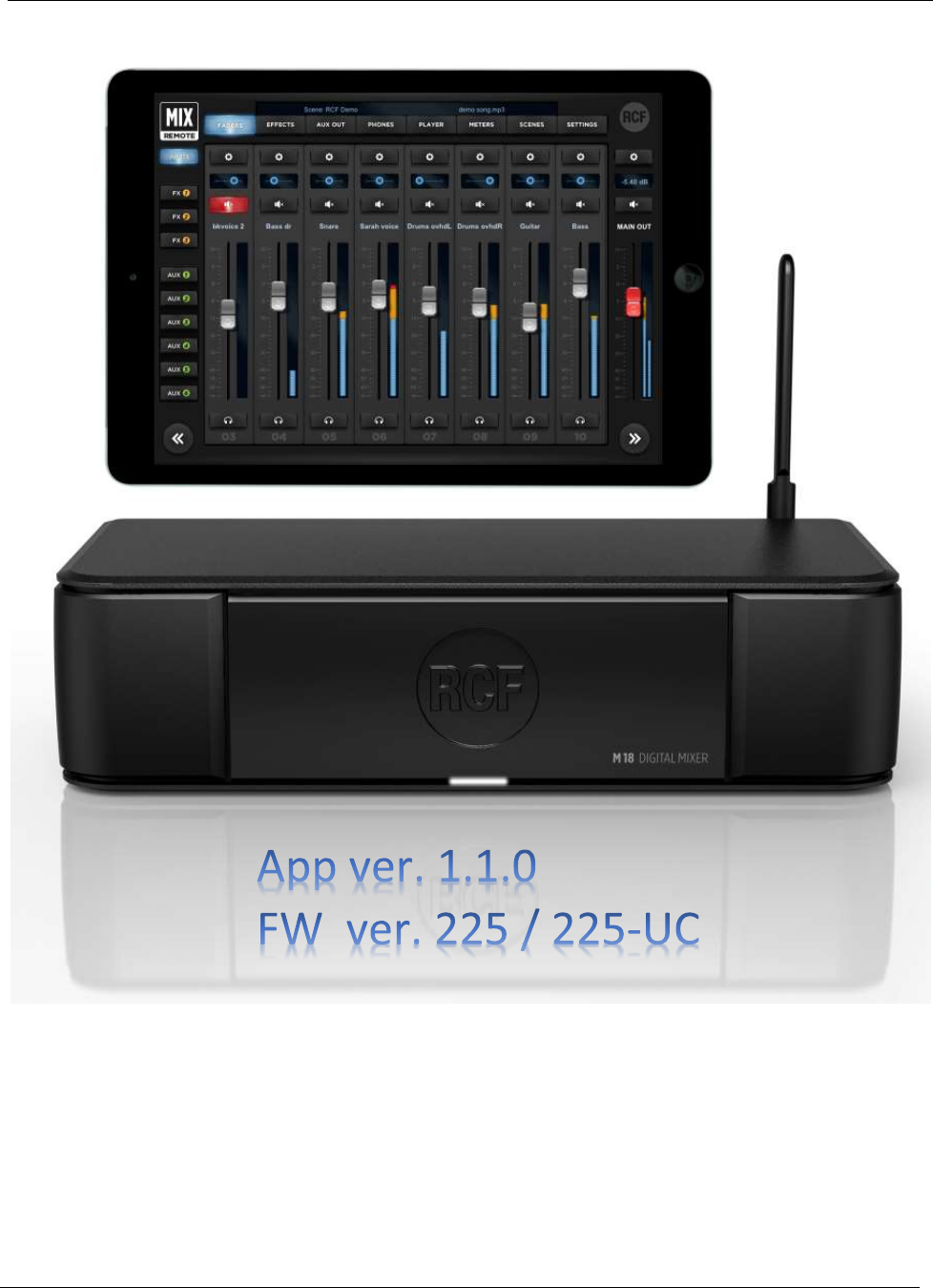
RCF spa
M 18 Digital Mixer User’s Manual
1
M 18 Digital Mixer - User’s Manual
Date: 25 Sept 2017
Rev.: 1.1.020G
p/n: 10399006 rev. J
This document refers to:
- Firmware version 225 / 225-UC
- iOS MixRemote app version 1.1.0 (build 105)

RCF spa
M 18 Digital Mixer User’s Manual
2
What’s new in firmware 225 / app ver. 1.1.0
M18 firmware release history:
version 182 (released 2016-01-14)
version 203 (released 2016-04-20)
Version 203 adds the following features:
• REC page; this feature was not enabled in firmware 182
• Redesigned and improved PREAMP graphics
• PFL indication on MAIN VU meters
• Improved VU Meter calibration
• Audio Player has louder output level
plus a series of bug fixes.
version 225 (released 2017-07-20 *)
Version 221 adds the following features:
• Improved VuMeters
• DAC and Mute Groups
• Additional controls: MUTE All Outputs, Mute FX
• Additional AMP models (Overange 120, Heavy 51, Slo 88 Lead, Slo 88 Crunch)
• Acoustic Simulator can be enabled instead of AMP simulation
• Additional Stomp effects: Ring Modulator, AutoWah, Octaver
• File player can also reproduce 4 tracks
• Metronome function with audio samples
• Import, Export, Copy and Swap functions to manage your favorite Shows, Snapshots and Patches
• Additional options for footswitch and output routing of AUX1, AUX2
• plus a series of bug fixes.
version 225-UC (released 2017-07-20 *)
This version was developed for USA and Canada markets; the controlling app automatically detects the firmware variant (225 or 225-UZ and acts
accordingly). The two variants differ for band WiFi management to comply with local certification regulations. All other features are in common.
RCF S.p.A. accepts no liability for any loss which may be suffered by any person who relies either wholly or in part upon
any description, photograph, or statement contained herein. Technical specifications, appearances, and other
information are subject to change without notice. All trademarks are the property of their respective owners.

RCF spa
M 18 Digital Mixer User’s Manual
3
Summary
The M series Digital Mixers by RCF ................................................................................................................... 5
M 18 features .................................................................................................................................................... 7
Overview ........................................................................................................................................................ 7
Internal Reverb .............................................................................................................................................. 9
MultiFX ........................................................................................................................................................ 10
Master Processor ......................................................................................................................................... 11
VALVE WARMER ...................................................................................................................................... 11
XCITER ...................................................................................................................................................... 11
MAXIMIZER .............................................................................................................................................. 11
Storing and recalling parameters ................................................................................................................ 12
MixRemote iOS app ......................................................................................................................................... 14
FADERS > INPUTS view ................................................................................................................................ 15
Input channels: preamplifier, dynamics, MultiFX ........................................................................................ 16
Input channels: EQ section .......................................................................................................................... 24
FADERS > SEND view ................................................................................................................................... 25
EFFECTS view ............................................................................................................................................... 26
EFFECTS > SEND ....................................................................................................................................... 26
EFFECTS > MULTIFX ................................................................................................................................. 27
OUTPUTS view ............................................................................................................................................. 28
PHONES view ............................................................................................................................................... 29
PLAY/REC view ............................................................................................................................................. 30
PLAY ......................................................................................................................................................... 30
REC ........................................................................................................................................................... 31
METERS view ............................................................................................................................................... 34
LOAD/SAVE view .......................................................................................................................................... 35
SETTINGS view ............................................................................................................................................. 36
Hardware Description ...................................................................................................................................... 40
Connectors................................................................................................................................................... 40
Startup sequence and recovery from an error condition............................................................................ 42
Restoring the unit with firmware ver. 182 .................................................................................................. 43
Restoring the unit with firmware ver. 203 .................................................................................................. 44
M 18 Usage ...................................................................................................................................................... 45
Secrets of mixing on a digital console ......................................................................................................... 45

RCF spa
M 18 Digital Mixer User’s Manual
4
Sound Shaping with M 18 ............................................................................................................................ 46
DRUMS ..................................................................................................................................................... 47
BASS ......................................................................................................................................................... 49
KEYBOARDS.............................................................................................................................................. 49
ELECTRIC GUITARS ................................................................................................................................... 50
ACOUSTIC GUITARS ................................................................................................................................. 50
VOICE ....................................................................................................................................................... 51
A1 – Declaration .............................................................................................................................................. 52
A2 - Block Diagram .......................................................................................................................................... 55
A3 – MIDI implementation chart ..................................................................................................................... 57
A4 – Technical Specifications........................................................................................................................... 58
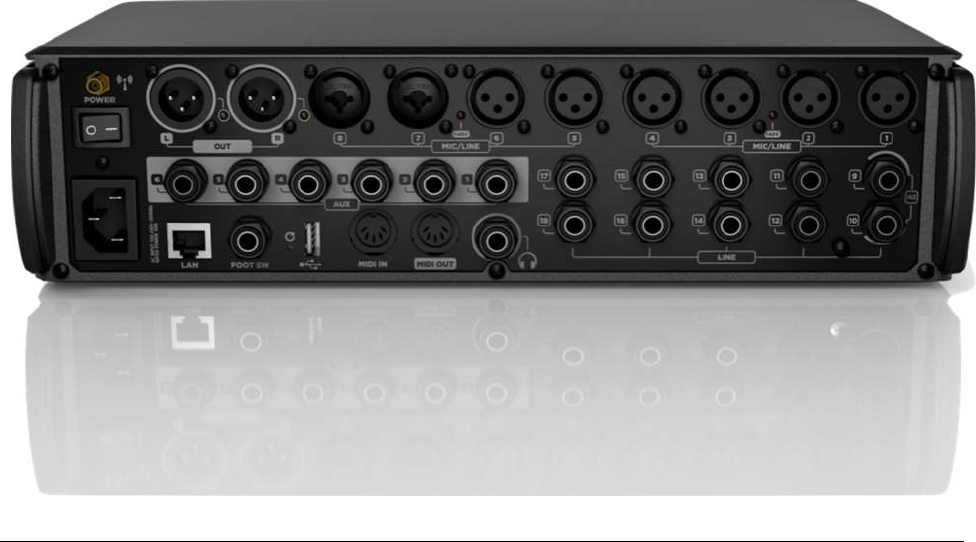
RCF spa
M 18 Digital Mixer User’s Manual
5
The M series Digital Mixers by RCF
A new family of compact Digital Mixers have been designed by RCF, with the aim to address the
requirements of modern performing musicians.
The main goal is to allow the user to minimize the amount of equipment needed for a live act. Therefore, a
significant effort has been spent to include all the main features to ensure a seamless performance. These
features are the following:
- compact size: the mixer is small and can be placed anywhere within the stage or between the
instruments
- full remote control over WiFi of all features
- integration of high-quality amplifier modeling
- internal WiFi Access Point and Power Supply
The M series of Digital Mixers are ideal in all cases where a dedicated sound engineer may not be available,
and therefore a FOH mixer would be inappropriate. The musicians themselves can perform the sound check
by moving in from of the house PA with a tablet and setting up the mixer accordingly.
Two independent amplifier simulation algorithms, licensed from Overloud ™, have been included into a
multieffect-like organization of internal effects. This enables a further option to avoid bringing on the stage
bulky and large amplifiers, relying on the main PA and stage monitors.
A high-quality stereo player is available on the unit, accessing files from a USB flash drive, representing a
further option in minimizing the amount of equipment required for a live gig.
Therefore, you can leave home several items, such as the multicore snake, external effects that would
normally connect to the mixer, guitar and/or bass amplifiers, external file player, and yet obtain a high-
quality and professional result.
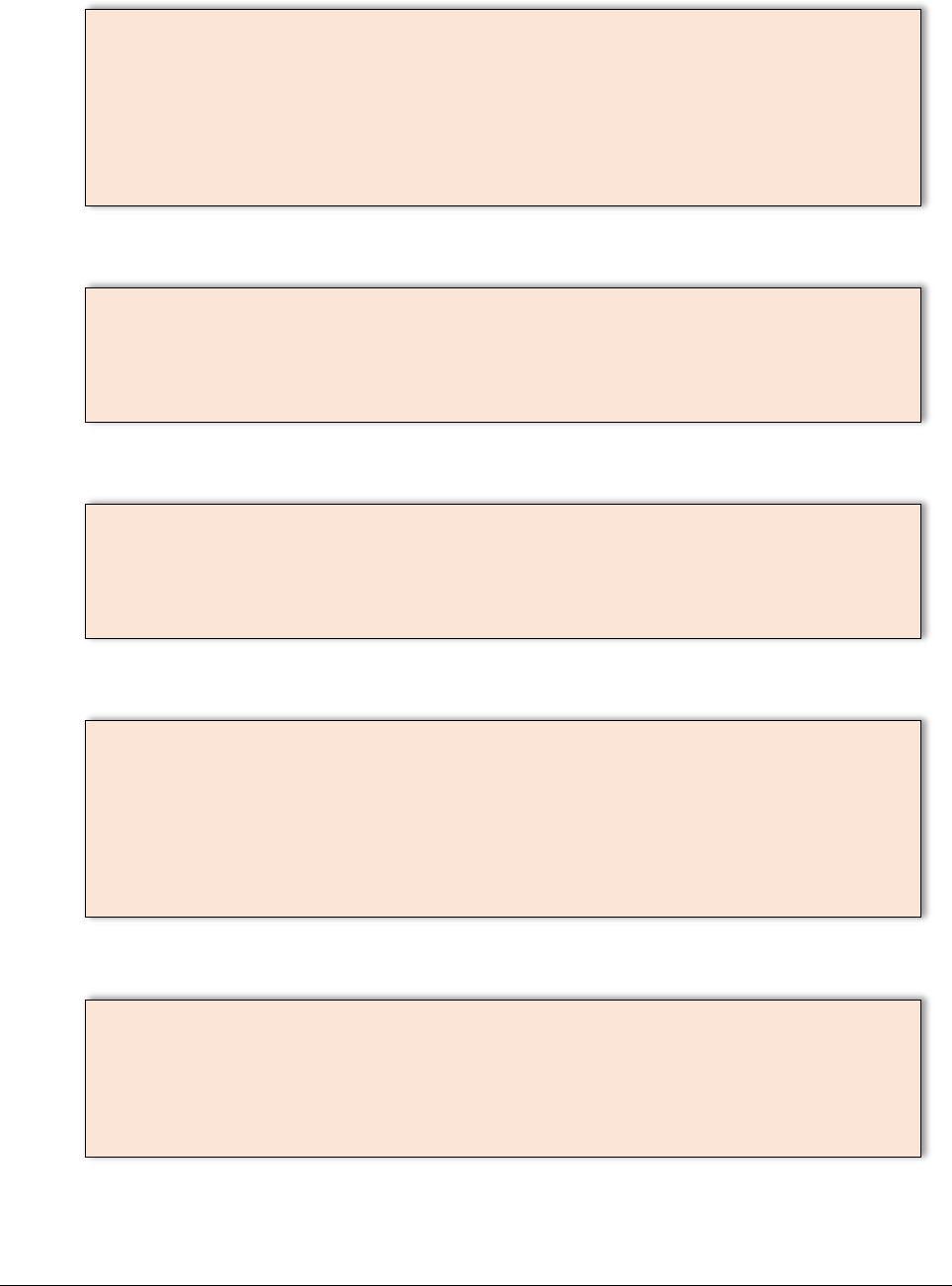
RCF spa
M 18 Digital Mixer User’s Manual
6
This document is available to help you in exploring the various features of the M 18 Digital Mixer, and is
arranged in different sections:
M 18 Features
An overview of the most interesting features of the M 18 Digital Mixer is presented,
focusing on the unique aspects of the unit. It includes details on the internal high-quality
digital reverb, on the MultiFX concept, on the Master Processor, and on the options to
save and recall internal parameters.
MixRemote iOS app
Detailed reference of the MixRemote app for iOS, which is the primary way to interact with
the mixer itself. All app views and controls are presented in detail.
Hardware Description
Overview of the connections available on rear panel.
Detailed indications on the startup sequence and recovery options.
M 18 Usage
Useful tips on how to make the best use of the M Series Digital Mixer.
This section includes advices on the gain structure concept, and several practical hints on
equalization and compression settings for specific instrument types.
Appendixes
A1 – Block Diagram
A2 – MIDI implementation
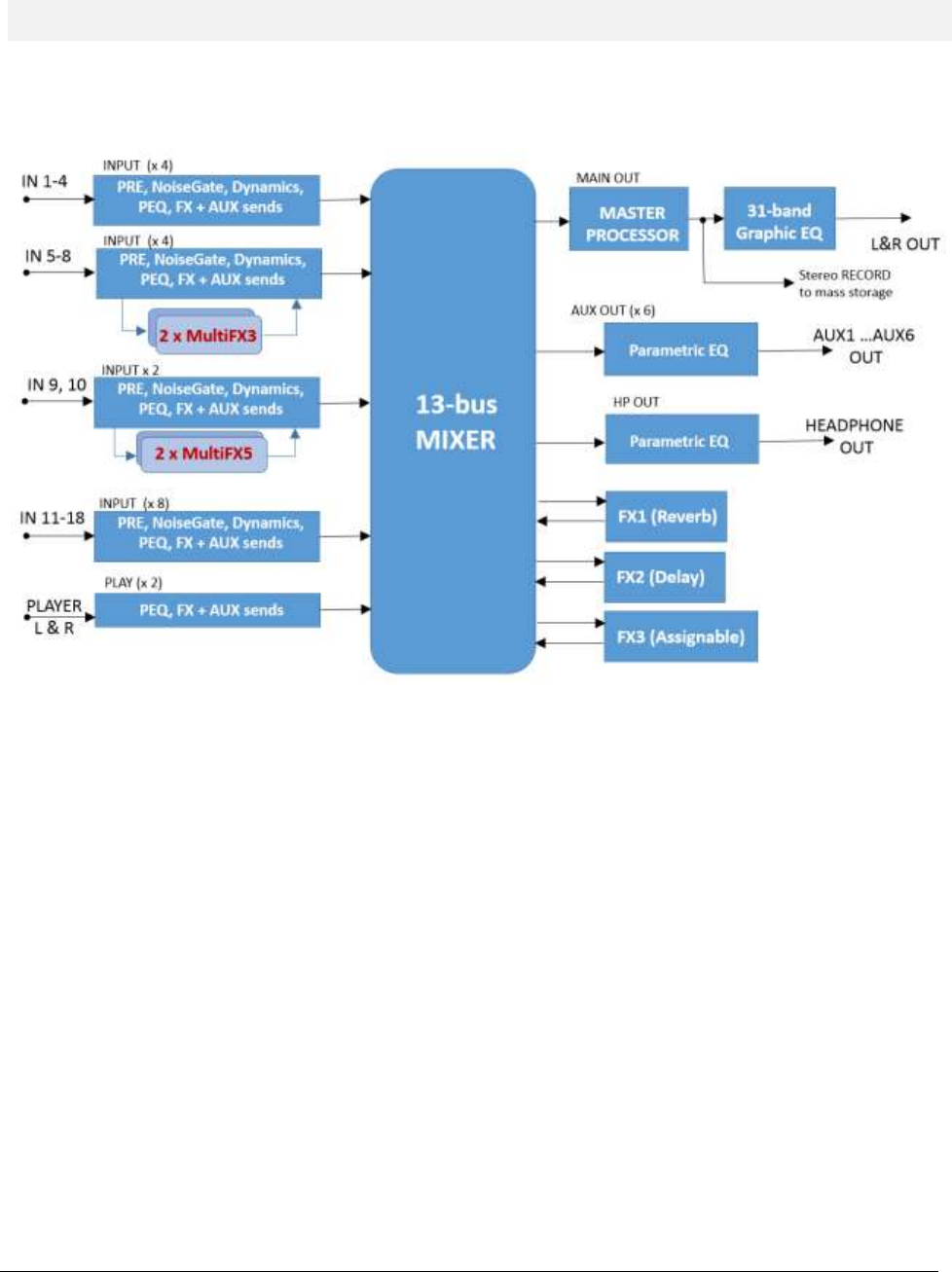
RCF spa
M 18 Digital Mixer User’s Manual
7
M 18 features
Overview
The M 18 Digital Mixer is a feature-packed unit that includes several of the useful blocks required to arrange a good-
sounding live act.
Signal processing capabilities of the M 18 Digital Mixer
In addition to the usual essential processing blocks that are present in every mixer (equalizers, compressors), several
effects are available, arranged as follows:
• Three global stereo effects, each with a dedicated FX SEND buss
• Two 5-stage MultiFX blocks, dedicated to channels 9 and 10; in each of these two blocks, an amp simulator is
available
• Two 3-stage MultiFX blocks, dedicated to channels 5 and 6 or 9 and 10
• A highly musical Mastering Processor on the MAIN L & R output signals
• A 31-band stereo Graphic Equalizer on the MAIN L& R output signals, after the Mastering Processor
The MultiFX blocks can be managed independently from the mixer, with a set of memories (which we call PATCHES),
to allow the same flexibility which would be available with an external multieffect unit.
A total of 13 summing busses are present in the M 18 Digital Mixer:
• MAIN left & right buss
• FX SEND 1,2,3 buss
• AUX SEND 1,2,3,4,5,6 buss
• Stereo PHONES buss
Among these, the stereo personal monitor deserves special mention.
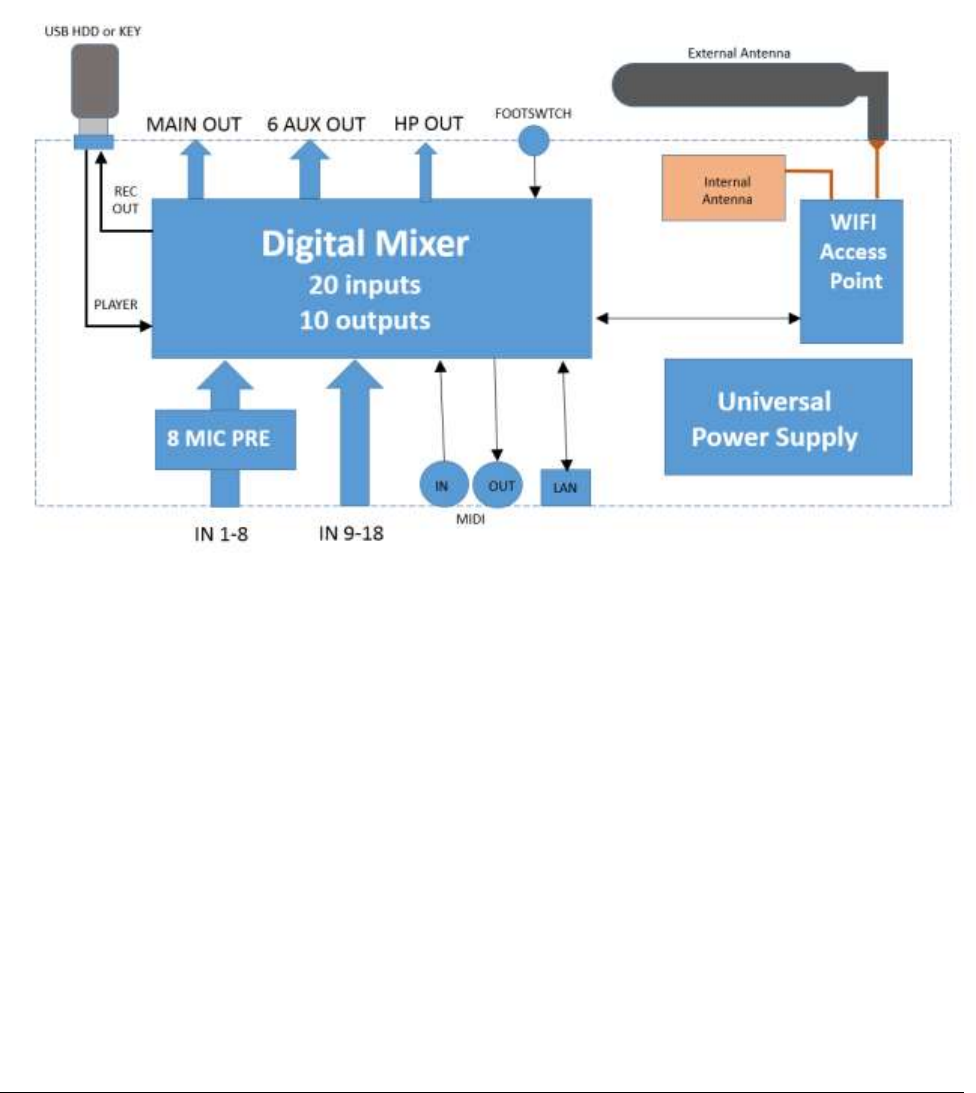
RCF spa
M 18 Digital Mixer User’s Manual
8
You can set the PHONES buss in one of two modes:
- PFL mode (pre-fader listen), in which the input channels put in SOLO mode are summed and sent to the
PHONES output, through the EQ and PHONES fader; the PFL level is shown on the MAIN L and R VU meter.
Please notice that the stereo PFL VU meter display reflects the PAN value, and of course, being pre-fader, is
not affected by the fader level.
- Personal Mix mode, in which a separate mix of all inputs, including the 2-channel player, is available and
allows a complete stereo mix to be routed to the PHONES output (and optionally to a pair of AUX outputs;
see routing options)
A complete overview of the M 18 internal features is shown here below:
The internal Access Point is a dual-antenna MIMO WiFi interface; one of the two antennas is external, while the other
is located on the top right side (when facing at the RCF logo).
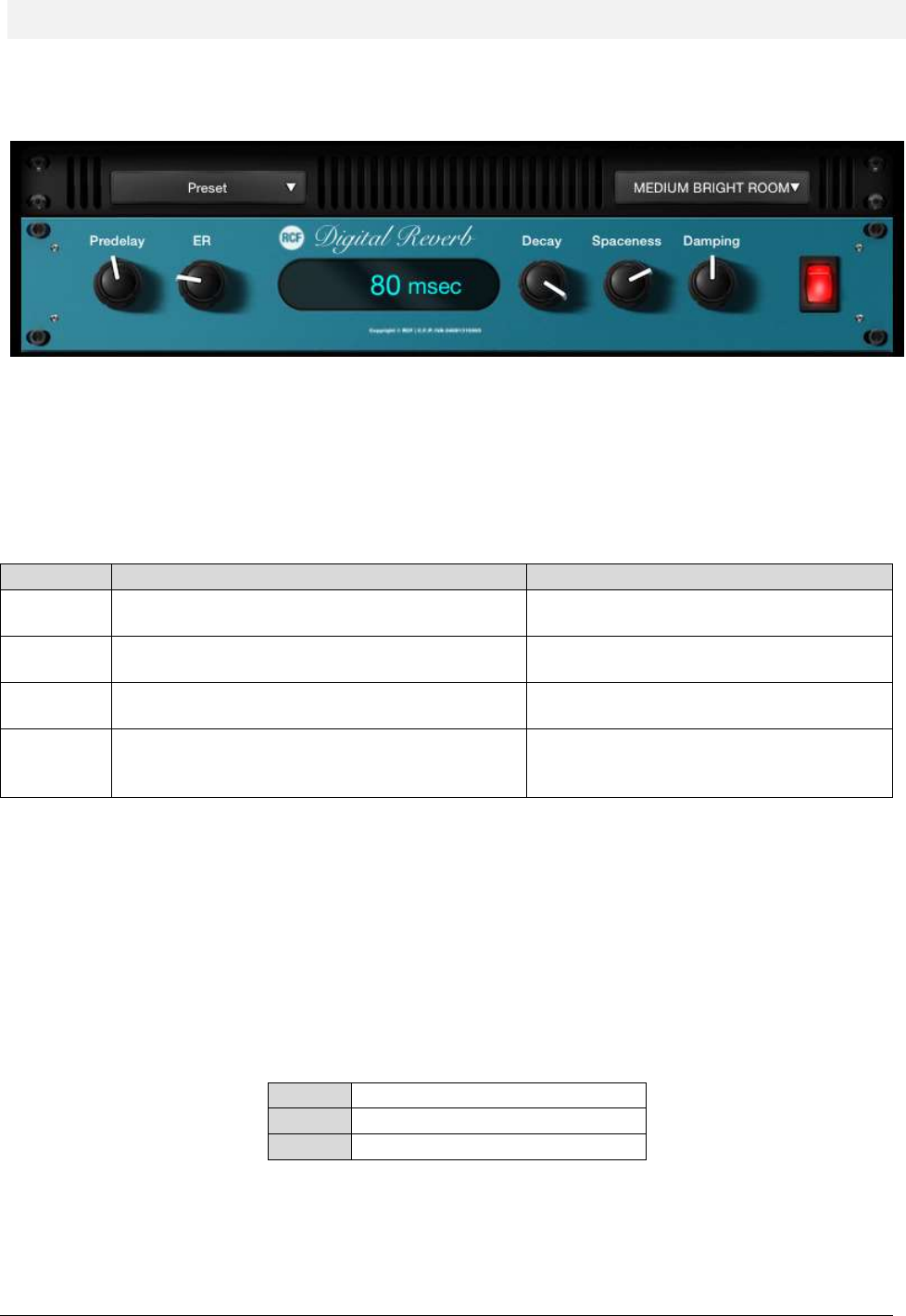
RCF spa
M 18 Digital Mixer User’s Manual
9
Internal Reverb
The M18 Digital Reverb is a very intuitive and smooth sounding processor, and represents an essential ingredient of
the final mix. Great care has been taken to provide the highest quality algorithms and presets.
Based on 12 algorithms, it allows to easily find the perfect reverberation for every kind of application in a few clicks.
The algorithms are been designed and tailored to focus immediately the sound you are looking for and then fine tune
it with the essential parameters available through the five pots.
The algorithms are also available in some cases into two variations (Bright/Warm or Digital/Vintage) to further help in
selecting the proper starting point.
A total of four different reverb types are available:
TYPE
VARIATIONS
Hall
usually perfect for smooth and deep reverberations
large/medium
warm/bright
Room
the algorithm to start with if you are looking for hi
impact reverberations
large/medium
warm/bright
Plate
classic “all purpose” algorithm with unique
character
digital/vintage
Ambience
the first choice if you are looking for something to
expand the stereo field or to somehow enhance the
sounds
model 1, model 2
TIP
The reverberation is one of the most crucial signal processors to achieve a correct mix, so it’s very important to use it
with care. Often the reverberation of the venue affects our overall sound, especially because usually the sound check
is done without audience that is another element that can drastically change the reverberation time of the venue.
So keep in mid to evaluate the reverberation time of the empty venue, and then consider that it will be shorter with
the audience during the live gig; for these reasons, it could be useful to check the amount of the reverb also on
headphones.
A full set of carefully crafted presets are available, grouped into categories as indicated by their prefix:
[MIS]
Miscellaneous, general-purpose
[VOX]
Voice-oriented
[ACO]
Acoustic
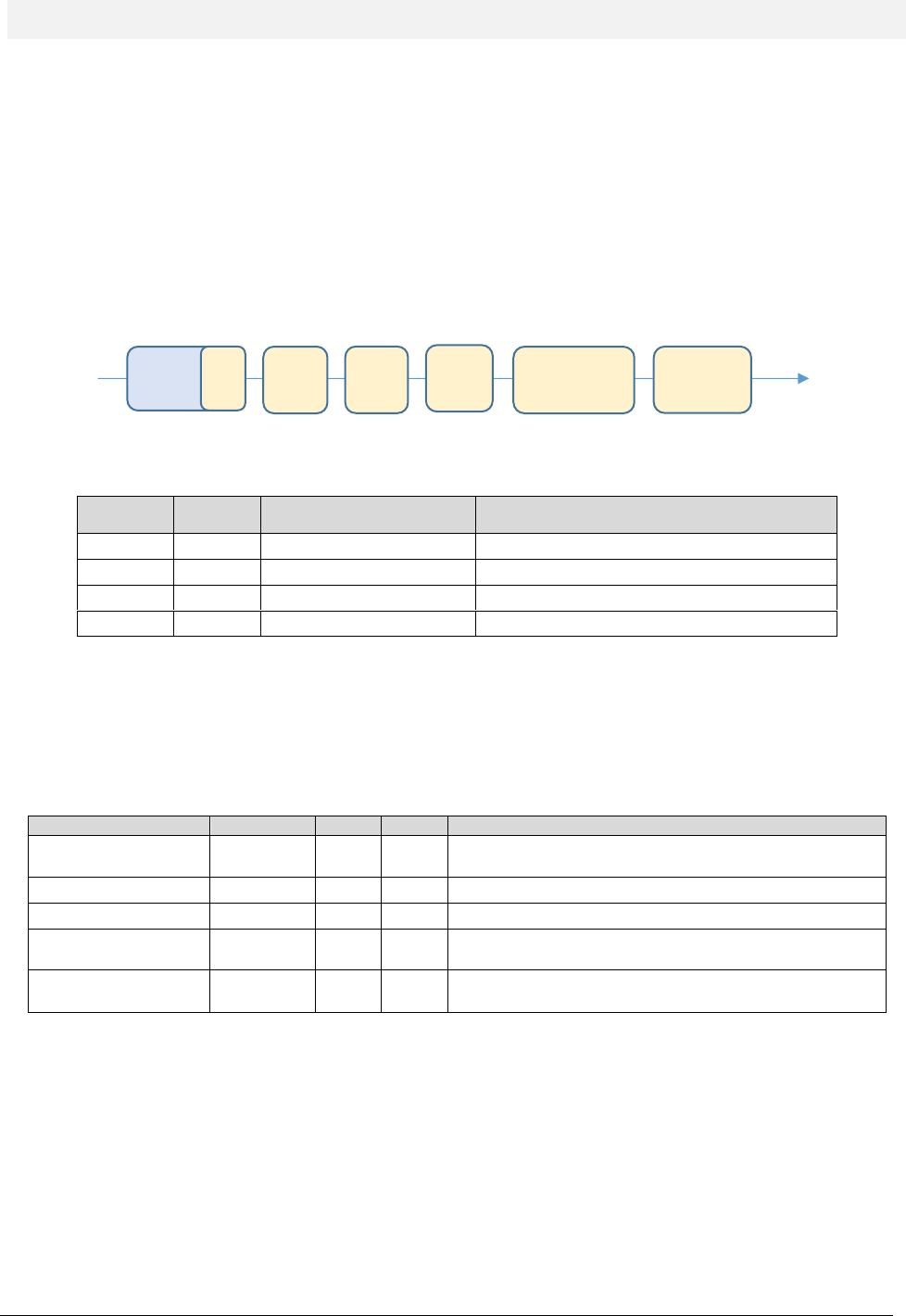
RCF spa
M 18 Digital Mixer User’s Manual
10
MultiFX
The M series Digital Mixers offer an unprecedented level of integration by offering multiple internal effects
that can be assigned to some of the inputs channels; these effects are additional and independent from the
main effects which are connected to the internal effect busses.
The aim of multieffect inclusion is to provide a new approach to effect processing, as effect settings can be
effectively combined with mixing parameters. It is thus possible to create a wide variety of sonic results
without additional equipment.
In the M 18 Digital Mixers the internal effects are combined into a total of 4 multi-effects, which are
inserted into 4 input channels. The insertion point is before the EQ section, as follows:
The M18 Digital Mixer offers a total of four independent MultiFX blocks, allocated as follows:
Multieffect
chain
cascaded
effects
Allocated to
input channel
Some usage
examples
MFX1
3
5 (XLR in) or 7 (COMBO in)
Voice, acoustic guitar, percussions, analog synths
MFX2
3
6 (XLR in) or 8 (COMBO in)
Voice, acoustic guitar, percussions, analog synths
MFX3
5
9 (Line in, Hi-Z option)
Electric guitar, electric bass, analog synths
MFX4
5
10 (Line in, Hi-Z option)
10 (Line in, Hi-Z option)
MFX1 and MFX2 feature a Modulation effect, a Delay and a Special FX unit; MFX3 and MFX4 are similar to
MFX1 and MFX2, but they add OverDrive modeling and a high-quality Amp Simulation section.
The order of cascaded effects can be modified for each patch; the M series has a total of 5 different effect
families, and one of each family is available within a MultiFX block, as follows:
Effect Family
Abbreviation
MFX1,2
MFX3,4
Description
Modulation
MOD
YES
YES
classical modulators typically used for several instruments
(chorus, flanger, tremolo)
Delay
DLY
YES
YES
Several types of mono delays
Special Effects
FX
YES
YES
General-purpose container, including pitch shift
OverDrive
OD
-
YES
Modeling of classic overdrive stomp boxes, licensed from
OverloudTM
Amplifier simulation
AMP
-
YES
Accurate modeling of guitar and basshead amps and
cabinets, licensed from OverloudTM and from MarkBassTM
You can save the all parameters of a specific MFX chain, including effect ordering, within a PATCH, that can
be recalled independently from other mixer parameters. You can recall PATCHes via MIDI program change
message, and you can also individually turn on and off the effects via NoteOn MIDI messages; each MFX
reacts on different MIDI channels, which can be set within the SETTINGS > MIDI page. The dual footswitch
input can be set to control a specific MFX, to either move to next or previous PATCH, or turn individual
effects on and off.
Therefore, you have a high degree of flexibility for controlling MFX chains during a live gig.
PREAMP
PHASE
HPF
MultiFX
AUDIO
IN
To
MIX
BUSSES
A/D
NOISE
GATE
COMP
4-band
EQ
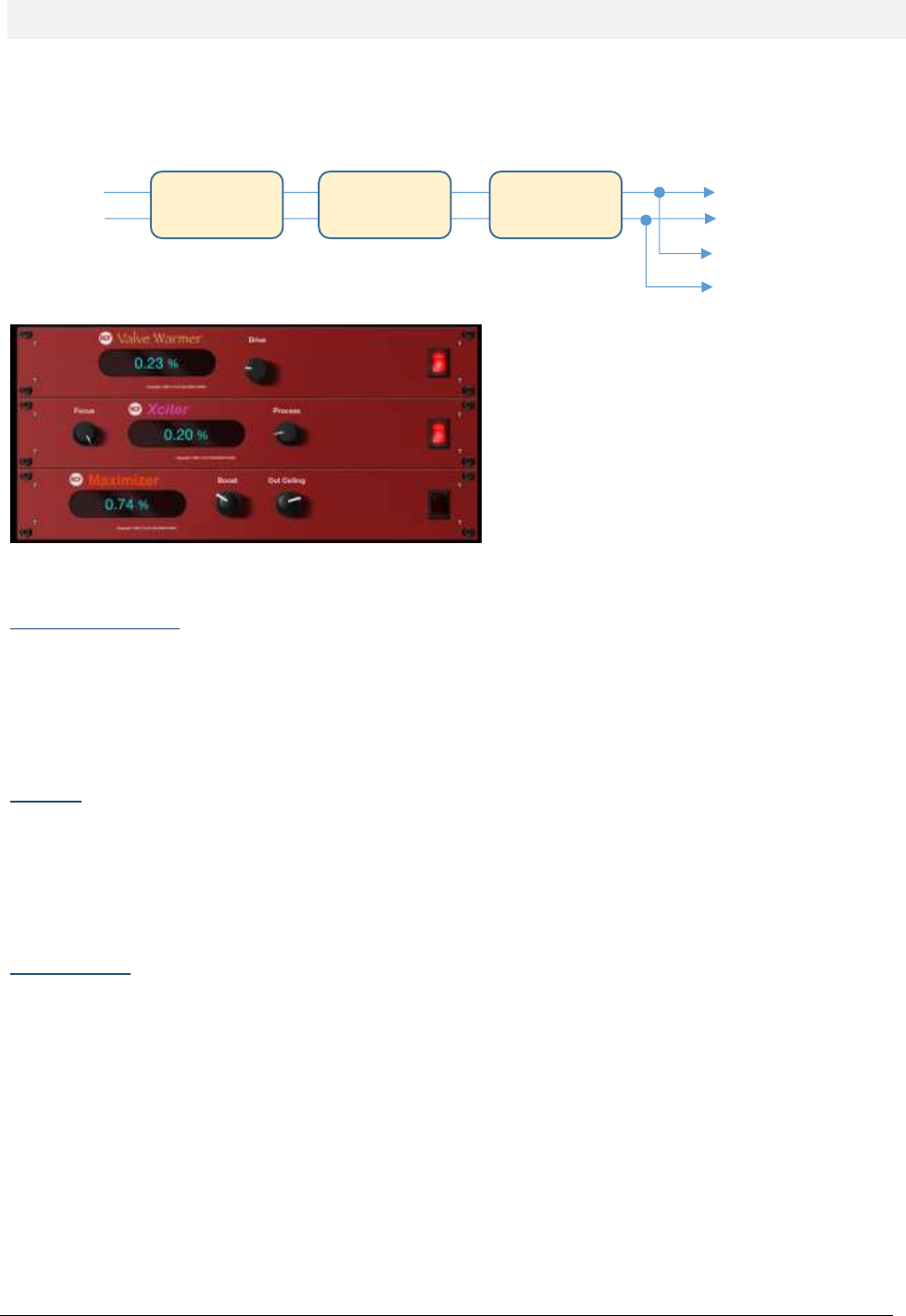
RCF spa
M 18 Digital Mixer User’s Manual
11
Master Processor
The M Series Master Processor is the last stage of processing, before the MAIN Graphic Equalizer, and represents a
precious toolset to give a final touch to overall sound. The Master processor is composed of three individual
processors in series: Valve Warmer, Xciter, Maximizer.
These three processors have been developed to
work together or individually, to achieve a warmer,
analog overall sound, but at the same time to make
your sound loud and proud as required from the
contemporary music business. You can bypass the
set of three processors with a single button, to ease
the evaluation of its effect on the overall mix.
The factory presets are, as always, a great starting
point to easily learn how the three processors can
work together and then to go ahead creating your
own settings.
VALVE WARMER
Very easy to use one knob processor, it allows to vary from subtle warmness to extreme saturated sound.
This processors works like a real analog piece of gear: it means that the resulting sound is depending on input level;
the more you feed it with a louder signal, the earlier you get a saturated sound, so be careful with your levels inside
the mixer and use it very slightly if you want to use it only for warming your sound.
XCITER
It allows to sculp sound with two adaptive curves on the low end and high end. The frequency of these curves have
been tailored to fit easily and quickly every kind of mix.
You can easily achieve a more pleasant and dynamic sound by fine-tuning the overall frequency balance (Focus) and
make it more or less evident (Process)-
MAXIMIZER
This is the last processor in the signal flow chain, that allows you to give a final boost to overall sound. This processor
is very transparent and has been designed to be a “set and forget” stage.
With this in mind, the Maximizer is super easy to set with its two knobs:
Boost: sets the amount of the incoming signal to the maximizer (it’s a boost only knob so rotate it
anticlockwise for NO boost)
Out Celing: sets the final level (it’s an attenuator knob, so rotate it full clockwise for NO attenuation)
The Maximizer can be also used “to compact” the overall mix sound, so in this case you can use it boosting and
attenuating at the same time.
Valve
Warmer
Xciter
Maximizer
L-R
mix
To
GEQ
To stereo
RECORD
option
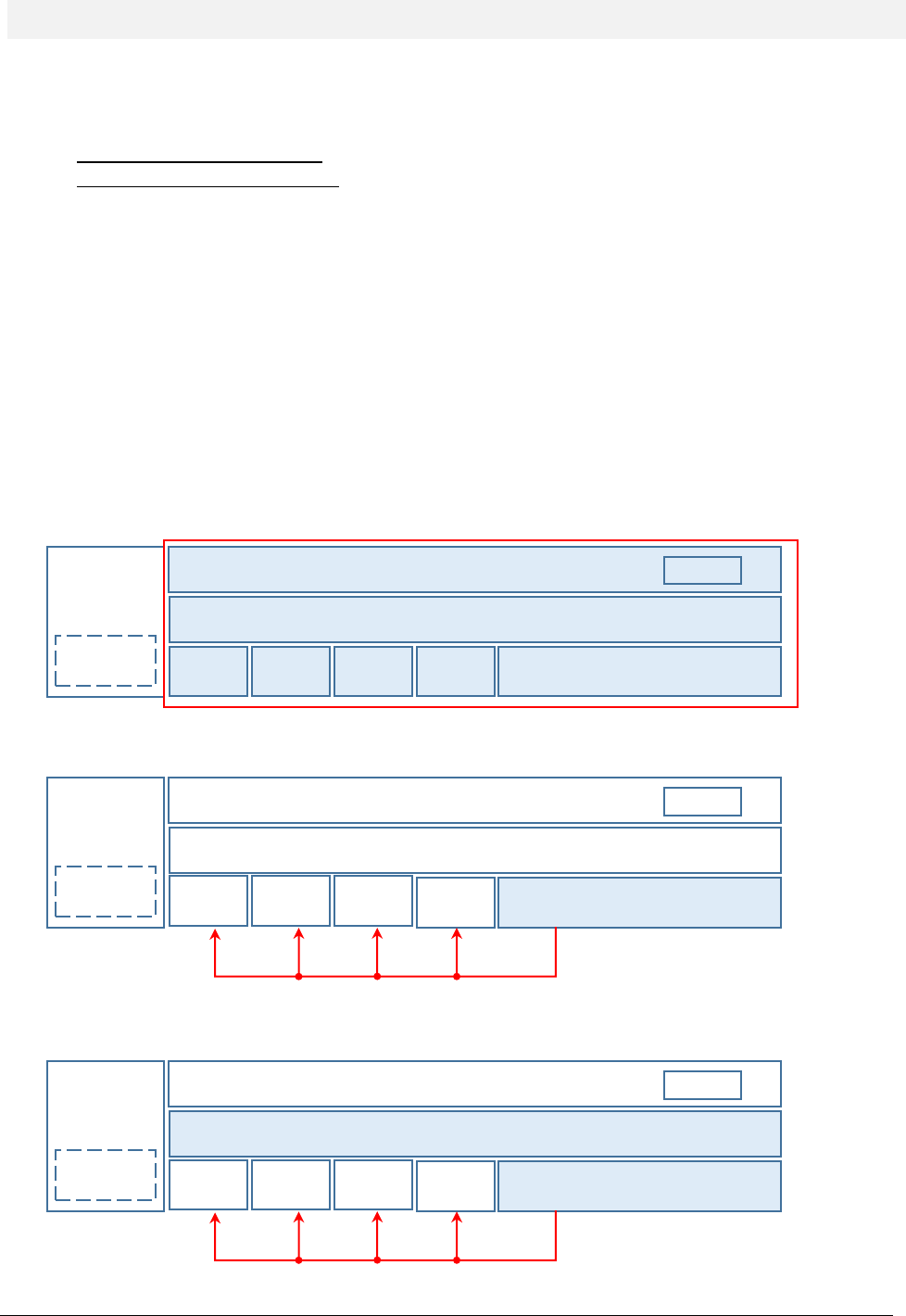
RCF spa
M 18 Digital Mixer User’s Manual
12
Storing and recalling parameters
The mixer handles the many hundreds parameters available in a specific way that has been tailored to the needs of
the performing musician. The following parameters groups can be identified:
- Global configuration parameters: they are stored in the mixer as soon as they are modified
- Network configuration parameters: they need a mixer reboot to become effective
- SHOW: it includes all the mixer parameters, except configuration parameters
- SNAPSHOT: as a SHOW, but without the output related parameters, and may include recall of PATCHes
- PATCH: it includes the parameters of a multieffect (MFX1, MFX2, MFX3, MFX4)
The SHOW is best suited to save all settings after a sound check, or to store the equalization settings of a specific
venue; it can then be recalled when doing a live act in the same venue.
The SNAPSHOT is ideal for storing all the settings that are related to a specific song or context; i.e., you can change EQ
and equalization types on all input channels, as well as all send effects (both send levels and effect types).
When using the M 18 as a submixer, you can also save input channels levels by enabling the Mix Bus option during
Save; this helps in obtaining a consistent audio result.
We can show an overview of M 18 Digital Mixer parameters and the various ways of saving them as follows:
MFX1
MFX2
MFX3
MFX4
GLOBAL
CONFIGURATION
NETWORK
parameters
Mix bus
Snapshot-related parameters
Show-related parameters
GEQ
SHOW
MFX1
MFX2
MFX3
MFX4
GLOBAL
CONFIGURATION
NETWORK
parameters
Mix bus (not enabled at save)
Snapshot-related parameters
Show-related parameters
GEQ
SNAPSHOT (no Mix bus)
PATCH numbers
(if enabled in SETTINGS > SYSTEM)
MFX1
MFX2
MFX3
MFX4
GLOBAL
CONFIGURATION
NETWORK
parameters
Mix bus (enabled at save)
Snapshot-related parameters
Show-related parameters
GEQ
SNAPSHOT (with Mix bus)
PATCH numbers
(if enabled in SETTINGS > SYSTEM)
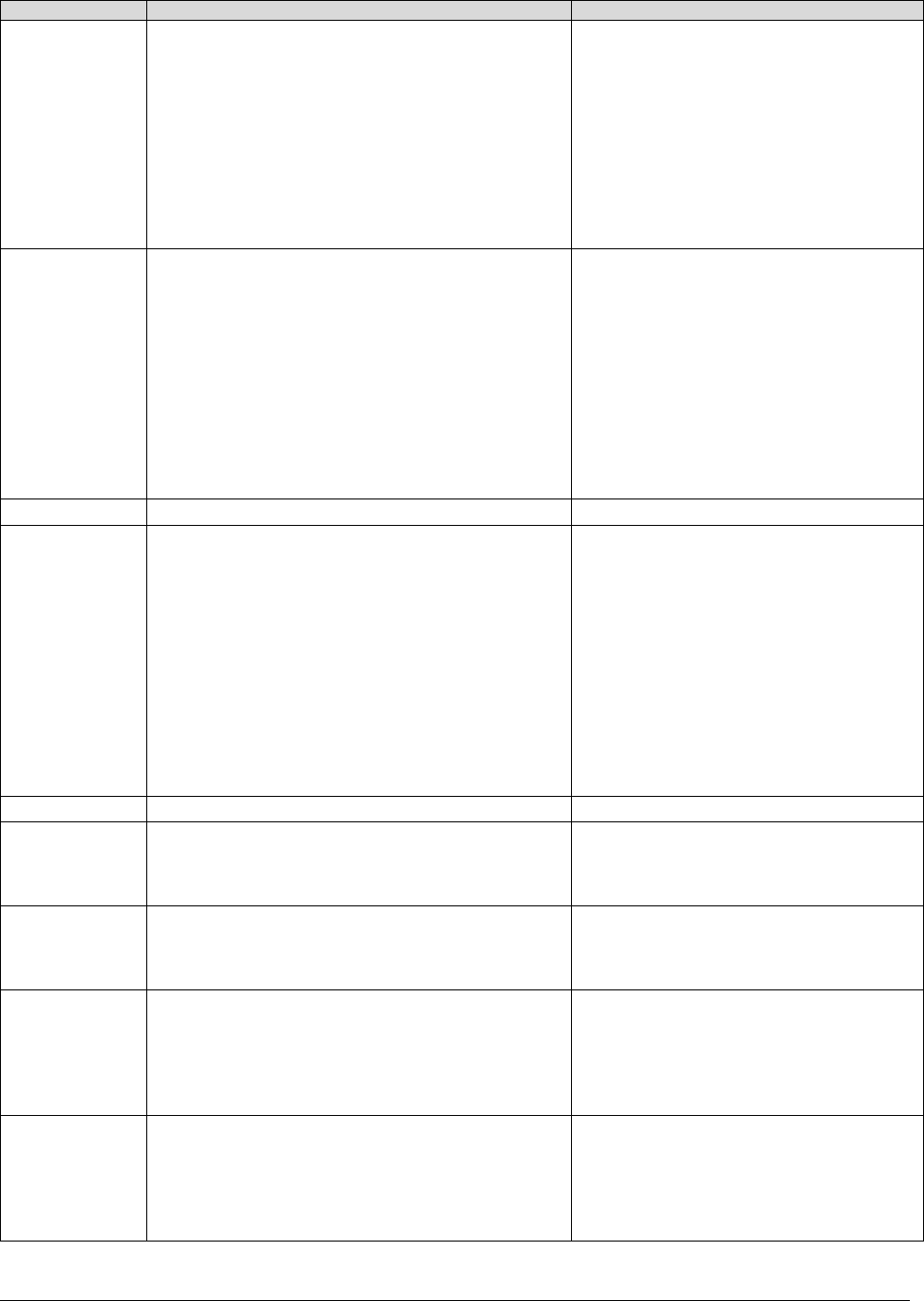
RCF spa
M 18 Digital Mixer User’s Manual
13
Every group is detailed in the following table:
Group
Parameters
Notes
Global
Configuration
NETWORK/LAN Settings
NETWORK/WLAN AP Settings
+48V Phantom Enable
PHONES Mode (PFL/Personal Mix)
MFX1, MFX2 Routing
Footswitch Settings
Outputs Routing
Snapshot Settings (save of MFX patch numbers)
Startup Setting
MIDI settings
PLAYER AUTO Mode ON/OFF
The NETWORK subgroup require a reboot to
become effective
SHOW related
INPUTS CH. PRE (GAIN, TRIM, PHASE, HPF, HiZ)
INPUTS CH. STEREO LINK settings
OUTPUTS LEVEL (Main Out, AUX Out, Phones Out)
INPUTS CH. names
OUTPUT CH. names
AUXs BUS (Level, Mute)
PHONES BUS (Level, Mute, Pan/Balance)
AUX OUT EQ parameters
PHONES EQ parameters
All MFX1, MFX2, MFX3, MFX4 parameters
AUX 5-6 CH. PRE/POST settings
GEQ ON/OFF
A SHOW saves the complete mixer state
(inputs, outputs, processing)
GEQ
Stereo 31-band Graphic EQ settings
May be saved and recalled independently
SNAPSHOT
related
INPUTS CH. EQ parameters
INPUTS CH. GATE parameters
INPUTS CH. COMPRESSOR parameters
INPUTS CH. names
OUTPUT CH. names
SEND EFFECTS parameters
MASTER PROCESSOR parameters
FXs Bus (Level, Mute)
Mix Bus parameters (if enabled at save)
MFX1 PATCH number (if enabled in SETTINGS)
MFX2 PATCH number (if enabled in SETTINGS)
MFX3 PATCH number (if enabled in SETTINGS)
MFX4 PATCH number (if enabled in SETTINGS)
A SNAPSHOT saves all the parameters not
directly related to the outputs
Mix Bus
INPUTS BUS (Level, Mute, Pan/Balance)
May be included in a SNAPSHOT
MFX1
DLY parameters
FX parameters
MOD parameters
FX order
MFX1 is a daisy-chain of 5 individual effects
(DLY, FX, MOD, with assignable order); affects
input channel 5 or 7
MFX2
DLY parameters
FX parameters
MOD parameters
FX order
MFX2 is a daisy-chain of 3 individual effects
(DLY, FX, MOD, with assignable order); affects
input channel 6 or 8
MFX3
DLY parameters
FX parameters
MOD parameters
OD parameters
AMP parameters
FX order
MFX3 is a daisy-chain of 5 individual effects
(DLY, FX, MOD, OD, AMP with assignable
order); it affects input channel 9
MFX4
DLY parameters
FX parameters
MOD parameters
OD parameters
AMP parameters
FX order
MFX4 is a daisy-chain of 5 individual effects
(DLY, FX, MOD, OD, AMP with assignable
order); it affects input channel 10
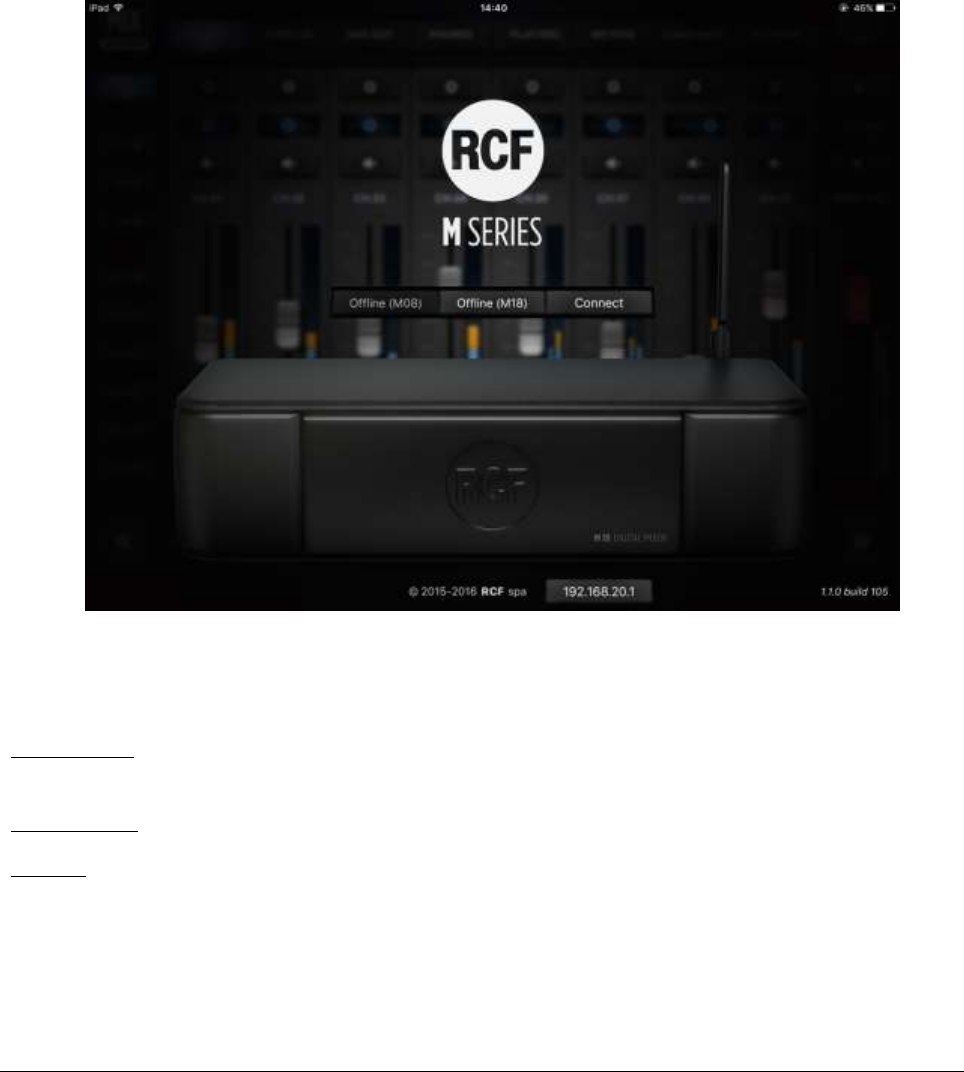
RCF spa
M 18 Digital Mixer User’s Manual
14
MixRemote iOS app
The MixRemote app allows full control of the M 18 Digital Mixer, and links to the unit via a WiFi
connection.
Several enhancements are periodically added to the app, therefore we suggest to check periodically for updates
on the iTunes Store. +Before downloading the updated app, please verify on the release notes if there is the
requirement to upgrade the hardware unit via a firmware update before using the updated app.
When you first launch the app, you reach a welcome screen; at this point, you are still not connected to the
mixer itself. You have three options available:
Welcome screen
In this view, you can choose between the following:
Offline (M08): this feature is intended for the M08 model, is currently disabled and reserved for future
upgrades
OffLine (M18): you can browse all features of the app without the need to connect to a physical M 18 unit
Connect: the mixer connects to your control device in few seconds, provided that you have selected the
proper mixer WiFi Access Point
On the bottom row, you can modify the IP address of the target mixer; there is a button to recall the
default value intended for the internal WiFi Access Point (only available on MixRemote ver 1.1.0 or newer).
After pressing Connect, you are directed to the real operative views of MixRemote.
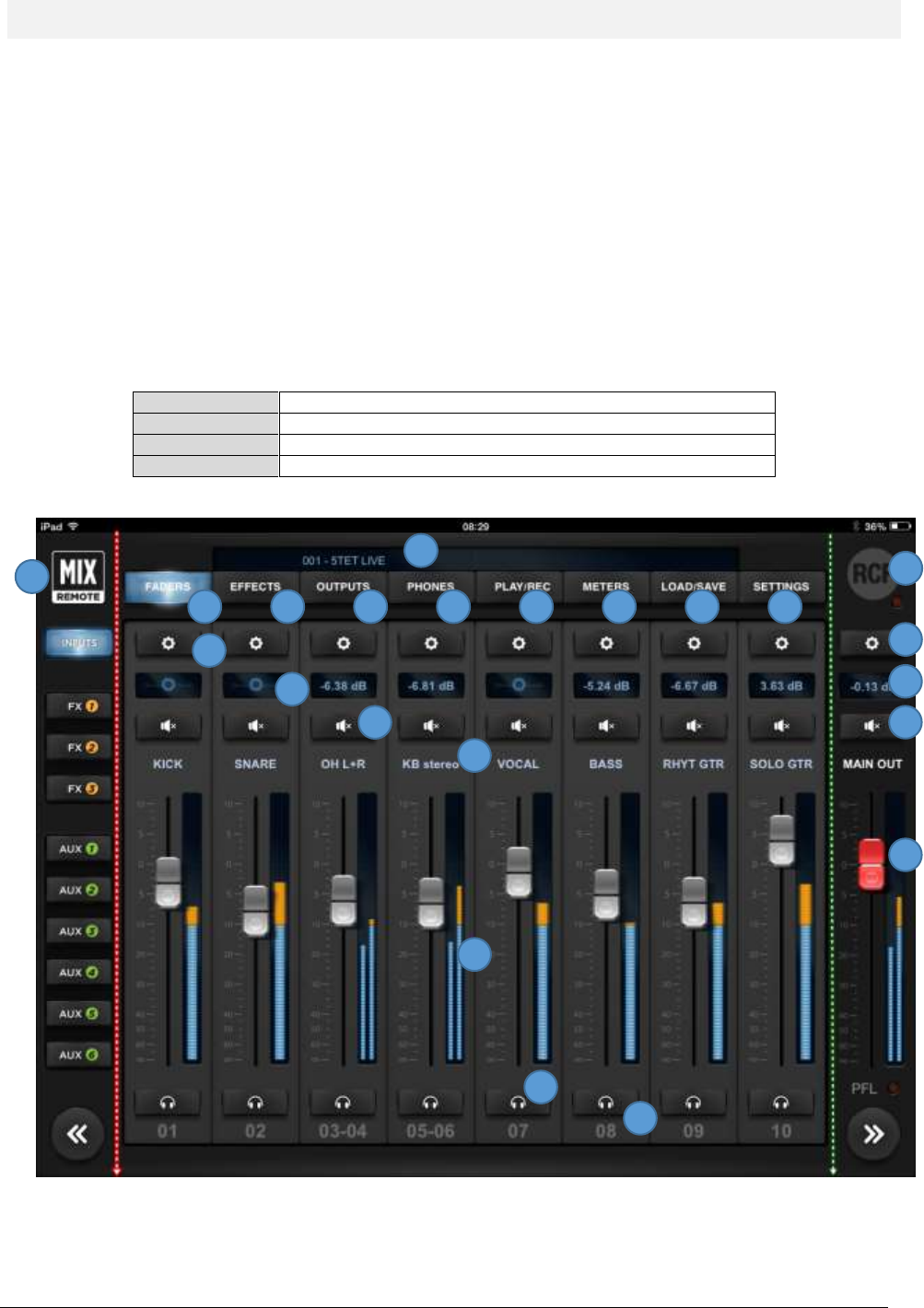
RCF spa
M 18 Digital Mixer User’s Manual
15
FADERS > INPUTS view
The first page you access is the FADERS INPUTS page, which shows on the top left the MIX REMOTE logo
(1). It you tap on the MIX REMOTE logo, you will be directed to the main FADERS > INPUTS view; this is a
sort of “Home” button that leads you always to the initial page with input faders.
In the central area, on the upper side, there is a small text box with indications of the currently active
session (2). Below there is a row of main tabs, named from left to right FADERS (4), EFFECTS (5), OUTPUTS
(6), PHONES (7), REC/PLAY (8), METERS (9), LOAD/SAVE (10) and SETTINGS (11); the active tab is backlit. On
the right side there's the RCF logo (3), which is lit (in brilliant white) when your controller is connected to
the M 18 Digital Mixer. A small indicator just below the logo signals lights up to indicate that the M 18
Digital Mixer is busy and the app is waiting for a response.
The fader caps are color coded consistently throughout the app:
SILVER caps
Input faders; Monitor output faders; FX buss send faders
ORANGE caps
FX send faders, for each input channel
GREEN caps
AUX send faders, for each input channel
RED cap
MAIN output fader
The FADERS INPUTS page, as most pages, is divided in three areas.
1
2
3
4
5
6
7
8
9
10
11
12
13
19
20
21
22
14
15
16
17
18
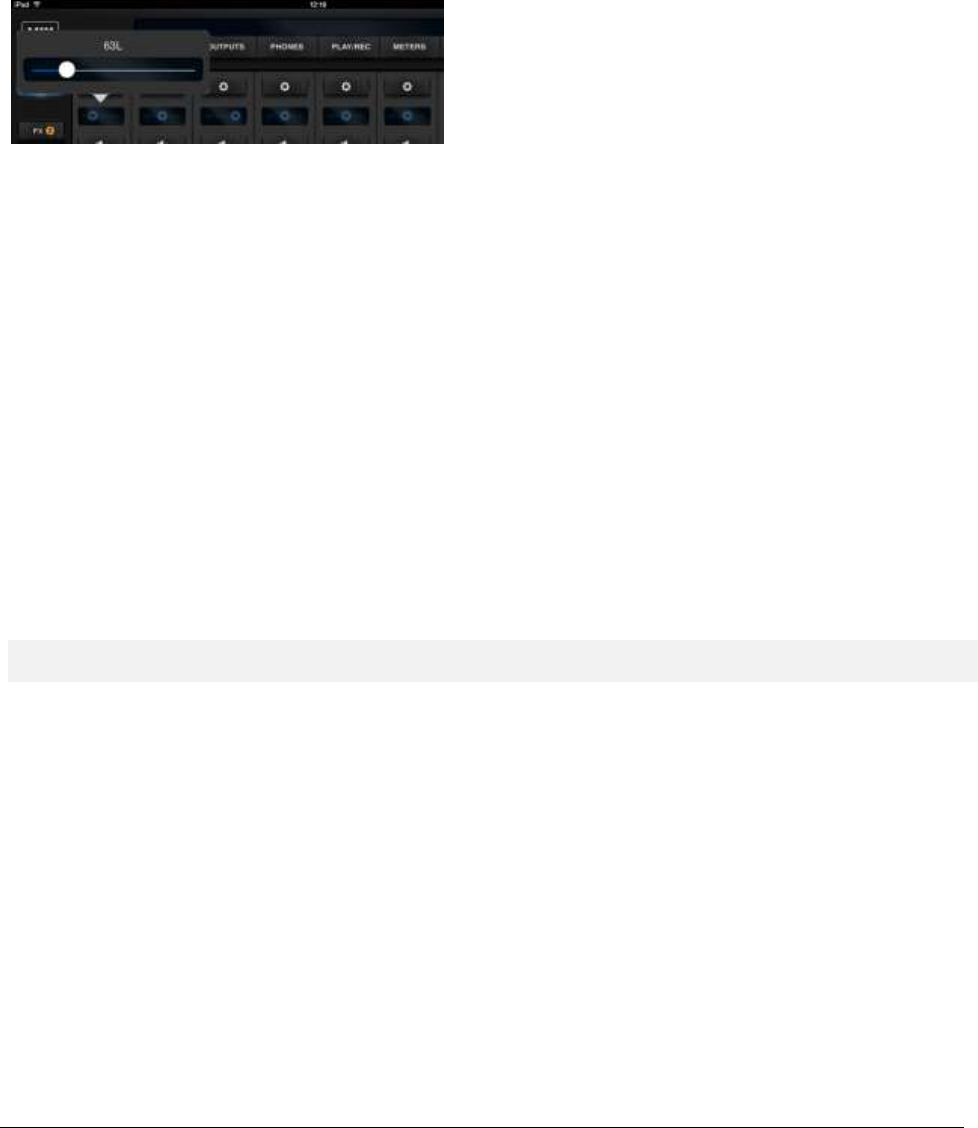
RCF spa
M 18 Digital Mixer User’s Manual
16
The left area, under the MIX REMOTE logo, enables the recall of the INPUTS tab, which is the default one.
Below, there are FX1, FX2, and FX3 tabs in orange, as well as AUX1, AUX2, AUX3, AUX4, AUX5, and AUX6
tabs in green. At the bottom there is a double arrow allowing you to scroll down 8 inputs at a time, or more
if some channel are stereo linked.
The right column, under the RCF logo, is dedicated to the MAIN OUT section, featuring the * key (19) to
recall the MAIN settings page, a box (20) indicating the level of the stereo fader in dB, the Mute button
(21), the MAIN OUT text box and the red stereo fader (22), which remains active in almost every page of
the mixer. At the bottom there is a double arrow allowing you to scroll up 8 inputs at a time, or more if
some channel are stereo linked.
The central area is reserved for a view of 8 faders (12);
this area can be scrolled by swiping your finger
horizontally. Above each fader there is a * (13) to
recall its setup pages, a box indicating the pan-pot
position or each fader level in dB (14) and a Mute
button (15). Please note that clicking on the pan-pot,
a larger windows opens, allowing better setting
accuracy.
Then there's a text box (16) which by default shows the channel number, e.g. CH.01 by clicking on the
button appears a keyboard allowing you to enter up to 12 characters to name the channel. On the right of
each fader there's the relevant level indicator, and under the fader there is the headphone icon (17) if the
PFL mode is activated – please see the Settings tab, Global page. Finally there's the number of the
hardware input (18), which can't be modified.
The faders of the 18 analog inputs are followed by PLAY-L and PLAY-R faders, controlling the signal from
stereo USB flash drive – these channels don't have the PRE-DYN section. Finally there are the faders of
internal effect returns FX1 RTN, FX2 RTN and FX3 RTN, which have only boxes for dB level, MUTE, fixed
name, and PFL, as well as the fader.
The PFL function (Pre-Fader Listen), when enabled, redirects the level indication from the PFL bus into the
Main VU meter; a yellow LED indicates that the Main VU meter is showing the PFL level instead of the
actual audio output (only available on MixRemote ver 1.1.0 or newer).
Input channels: preamplifier, dynamics, MultiFX
By clicking on * you access to each channel settings page; please note that these pages are different for
inputs 1-8, which hardware section is provided with combo connectors, allowing the use of microphones,
eventually provided of Phantom power, see SETTINGS tab GLOBAL page. Note that channels 05-08 may
have the MULTI FX page - with up to three effects.
Inputs 09-10 hardware sections allows the use with a Hi-Z signals, with a specific selector in mixer channels,
and have a large MULTI FX page - with up to five effects. Channels 11-18 features line level only inputs,
with a different RCF PRE layout.
In the left column the last modified section between PRE/DYN, EQ, MULTI FX (only for channels 05-10) and
SEND is lit. The right column, shows the MAIN OUT controls.
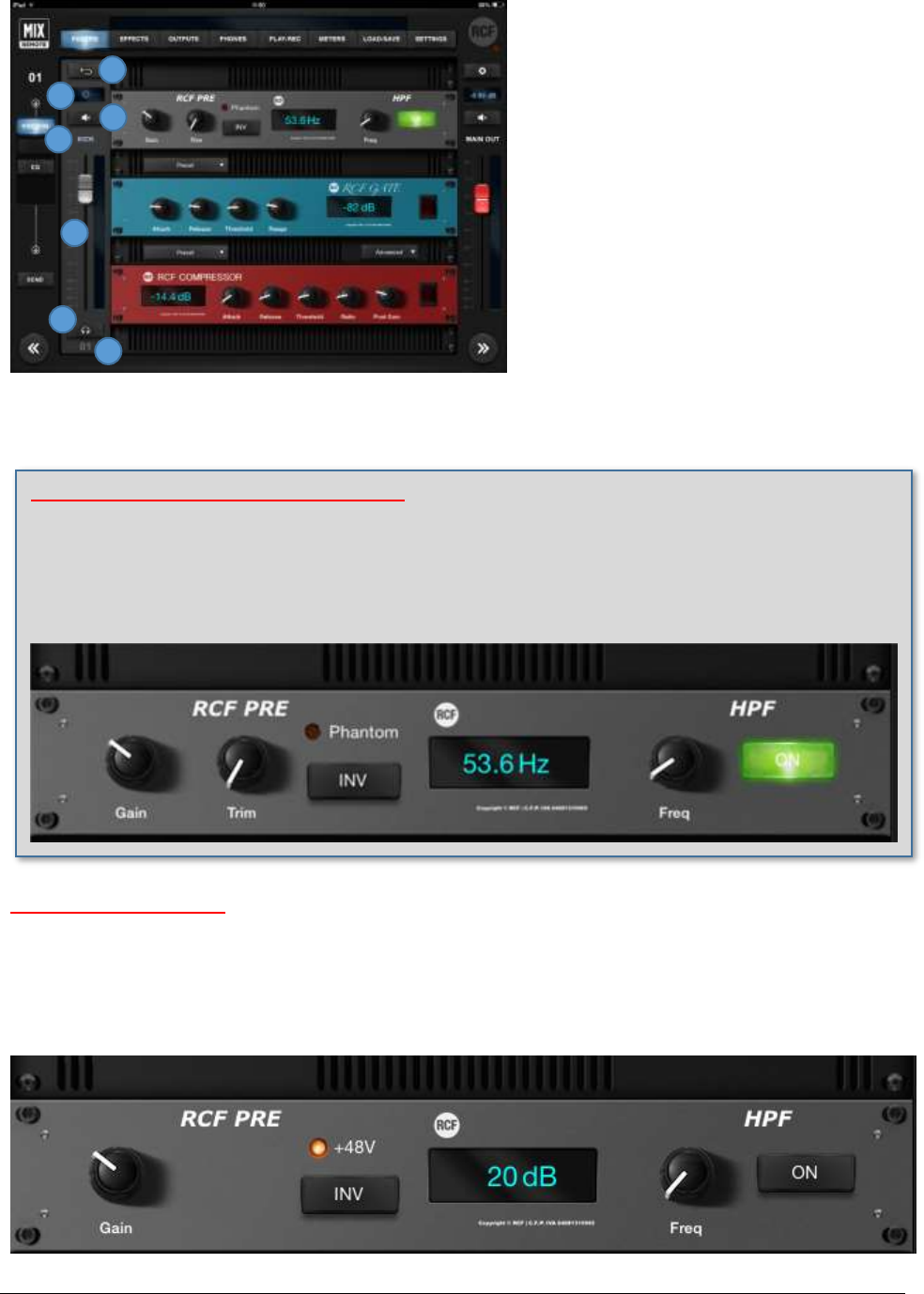
RCF spa
M 18 Digital Mixer User’s Manual
17
Inputs 01-08
The left part of the center column
contains on the top left a BACK button
(1) to allows you return to the INPUTS
view, followed by the pan control which
also shows fader value in dB when
moved (2), the Mute (3) button, the
channel editable name (4), the fader (5),
the PFL (6) button and the non-editable
number of the hardware input (7). The
larger part of this page shows a rack
containing RCF PRE, RCF GATE and RCF
COMPRESSOR, above the latter two
there is a box to recall presets.
The two large arrow buttons on bottom left and right enable you to change input channel immediately,
without requiring to go back to the INPUTS view.
On MixRemote ver. 1.1.0
The RCF PRE preamplifier now features a single GAIN control (from 0 dB to 60 dB in 31 dB steps), the LED
indicating the activation of the Phantom 48V power over the INV switch (phase inversion). The display
shows the values of each parameter, including the frequency of the HPF (selectable between 10Hz and
500Hz) which is activated via its ON button.
1
5
3
4
2
6
7
On MixRemote ver. 1.0.2 (previous version)
The RCF PRE preamplifier features GAIN (from 0 dB to 60 dB in 10 dB steps), TRIM (from 0 dB to -10 dB
in 0.1dB steps), the LED indicating the activation of the Phantom 48V power over the INV switch
(phase inversion). The display shows the values of each parameter, including the frequency of the HPF
(selectable between 10Hz and 500Hz) which is activated via its ON button.
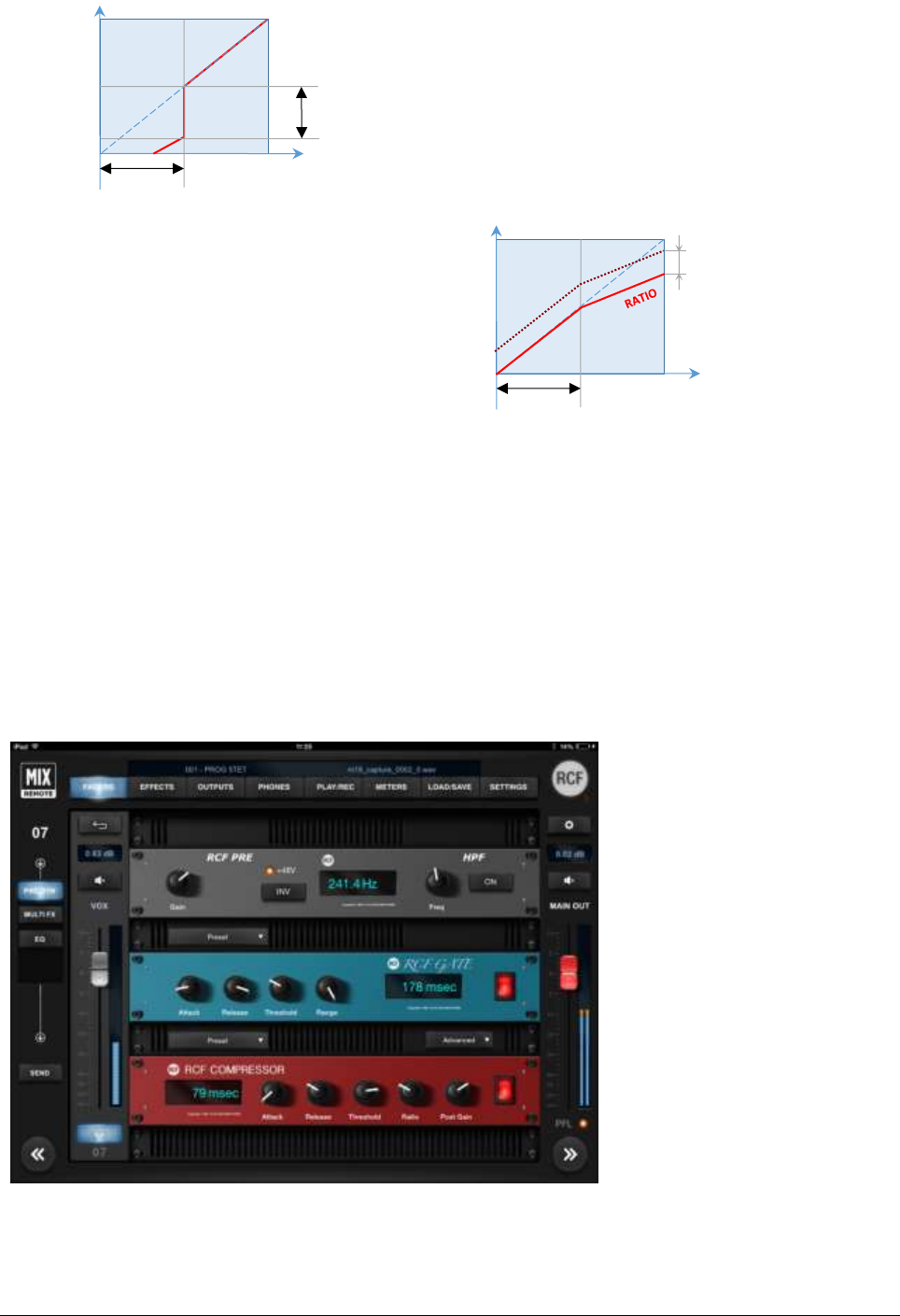
RCF spa
M 18 Digital Mixer User’s Manual
18
The second unit is the RCF GATE, topped by its Preset box,
with ATTACK and RELEASE time controls, THRESHOLD level
and RANGE intervention, completed by the display and the
activation switch. On the left you can see the characteristic
curve of the internal GATE: when the input signal goes
below the THRESHOLD, its level is reduced by RANGE dBs.
The third unit is the RCF COMPRESSOR,
topped by its Preset box, with a display on
the left, followed by ATTACK and RELEASE
times controls, THRESHOLD level, RATIO
compression, POST GAIN level and the
activation switch. On the right, the
characteristic curve of the compressor is
shown, including the contribution of POST
GAIN control.
For faster adjustments, the compressor features the Easy option, located in a small box on the left of the
Preset box - Easy has only the COMPRESSION control (based on input level signal with preset thresholds,
with automatic Post Gain adjustment) against the five controls of Advanced option.
Inputs 5-6 and 7-8
The left part of the center
column contains on the top
left a key (1) to return to
INPUTS followed by the level
of the individual fader in dB
(2), the Mute (3) key, the
name of the channel (4), the
fader (5), the PFL (6) key and
the non-editable number of
the hardware input (7). The
larger part of this page shows
a rack containing RCF PRE,
RCF GATE and RCF
COMPRESSOR, above the
latter two there is a box to
recall presets.
0 dBFS
IN
OUT
0 dBFS
THRESHOLD
RANGE
0 dBFS
IN
OUT
0 dBFS
THRESHOLD
POST
GAIN
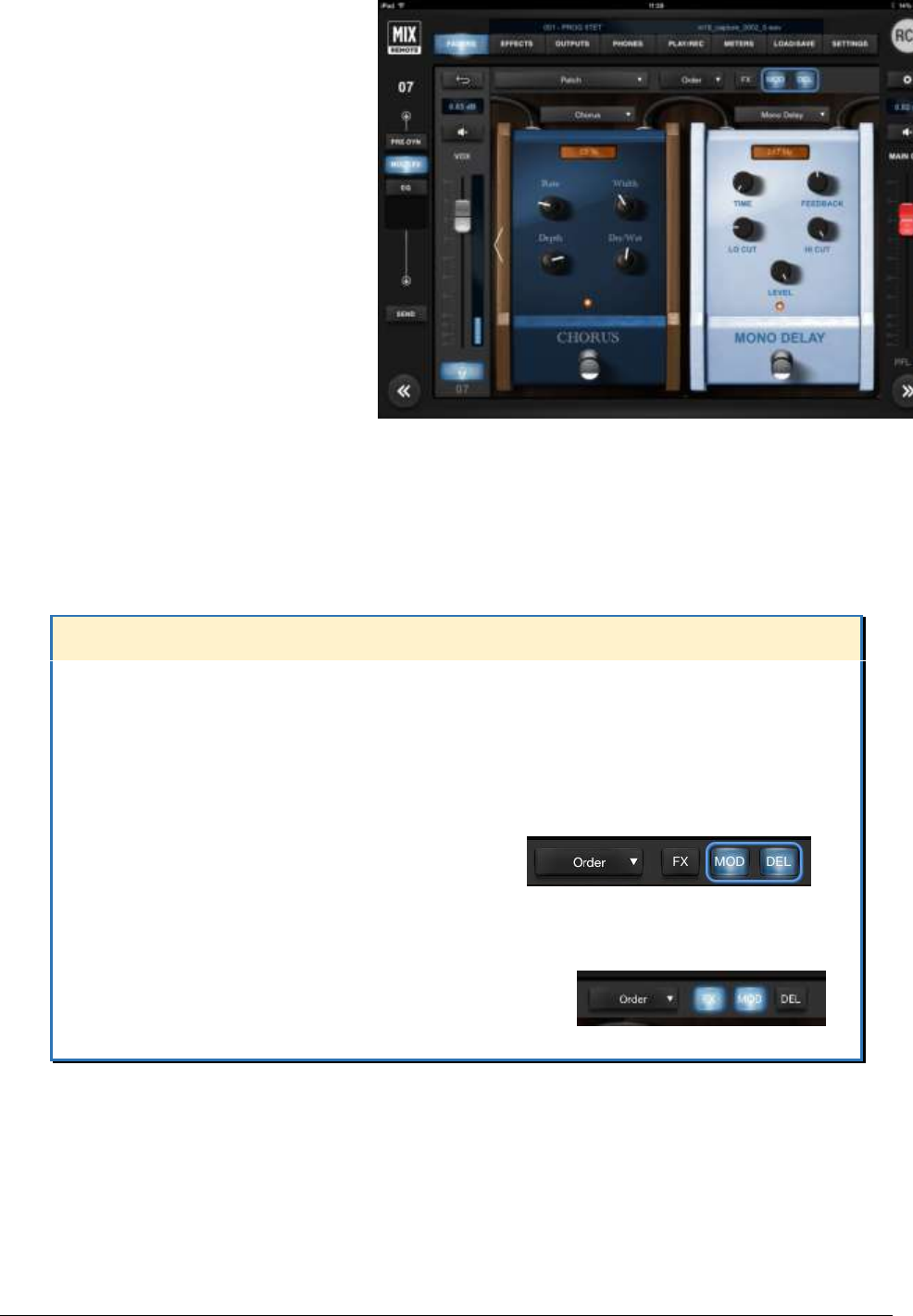
RCF spa
M 18 Digital Mixer User’s Manual
19
Inputs 5-6 and 7-8 left column is a little
bit different, since these channels may
have MultiFX (MFX) additional section.
MFX assignment is made in SETTINGS tab
GLOBAL page.
The MultiFX section allows you to use up
to three chained effects selectable
between MOD (Chorus, Flanger or
Tremolo), FX (Pitch Shifter), and DEL
(Mono Delay, Vintage Delay, ER Delay).
Pressing the Order selector appears a
drop-down menu allowing you to choose
the order of effects which better suits
your needs for each song, as you can see
in above pictures.
At the top of each pedal there's a display showing the last modified control value. At the bottom there's the
activation switch; its status is displayed by a light which is lit when the unit is on.
IN DEPTH
These channels let you use up to three cascaded effects types: MOD (Chorus, Flanger or Tremolo), FX
(Pitch Shifter), and DEL (Mono, Vintage or ER Delay).
You can change the order of cascaded effects through the selector Order, and view the result on the top
right indicators. These indicators show the ON/OFF status, an also allow you to select which pair of effect
is visible on the central section for editing. The order from left to right of the FX, MOD and DEL buttons
reflect the actual audio cascading.
If you touch any of the effect button, the editing view
for effects will shift to include the effect you have selected.
Please note that in MixRemote ver. 1.0.2, there was no
indication of ON/OFF status of individual insert effects;
rather the two shown pedals are indicated as a pair of lit buttons.
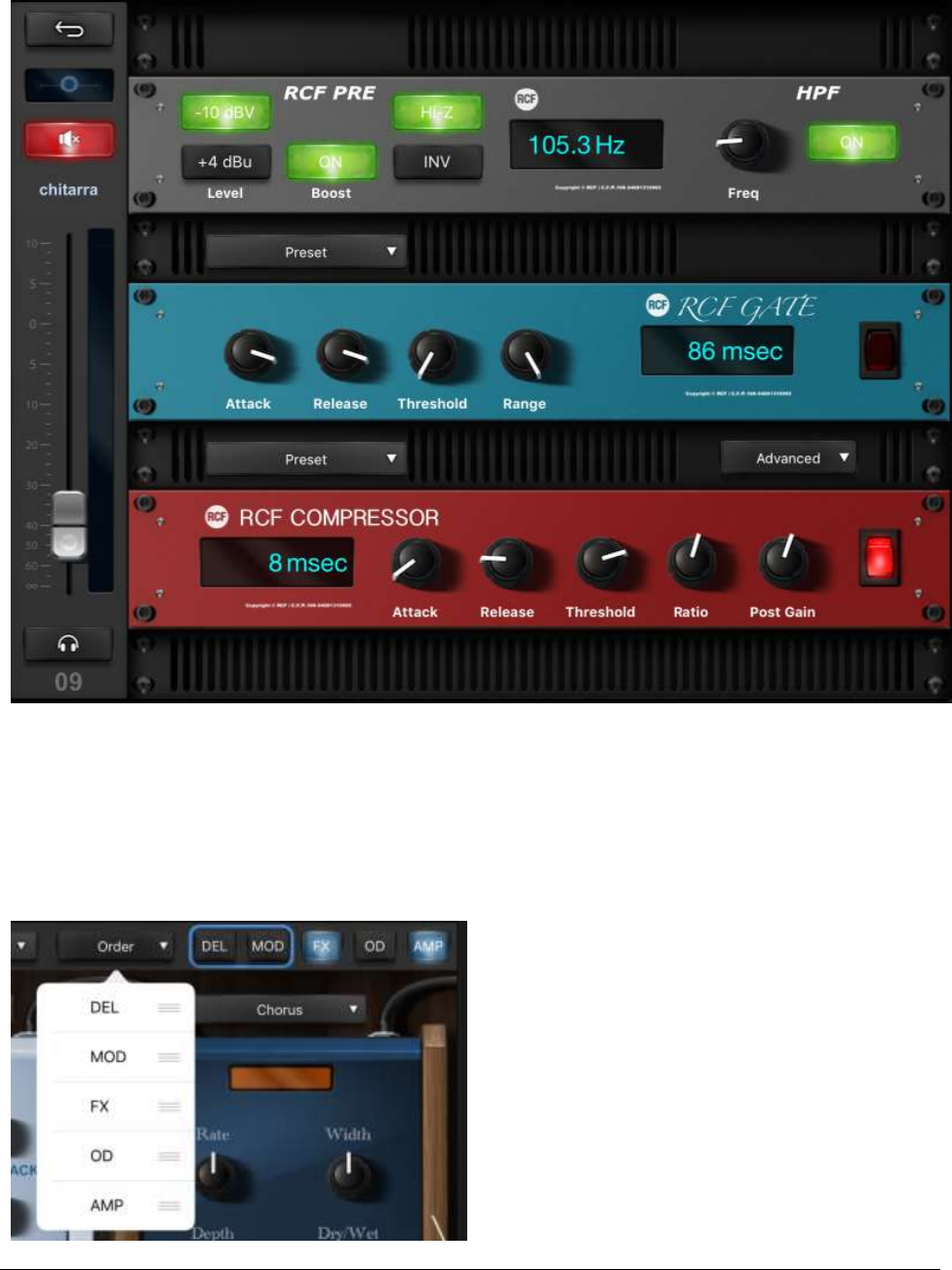
RCF spa
M 18 Digital Mixer User’s Manual
20
Inputs 09-10
Hardware inputs 09 and 10 have line-level sensitivity, but also allows the direct connection of electric guitar
and bass instruments, as they feature a Hi-Z option.
The -10dBV and +4dBu options are similar to the other line-level inputs; the Boost option allows you to
insert another 2 dB boost to the analog stage; while the Hi-Z option enables a real high-impedance stage to
get the best sound from your passive instrument. When in Hi-Z mode, the impedance is 1 Mohm. When
using active instruments, we suggest to maintain the Hi-Z option OFF.
These two channels offer additional capabilities to tailor your own sound, as they both feature a 5-effect
MultiFX.
Similarly to channels 5 to 8, the effects
are displayed in pairs, and you can jump
to the desired insert effect by touching
the dedicate button on top right (see
the red box here below).
You change effect daisy-chaining using
the Order Selector, immediately to the
left of the insert sequence indication. If
you drag the rightmost part of the list,
you can modify the insert position of a
specific effect, and the change is effective
immediately.
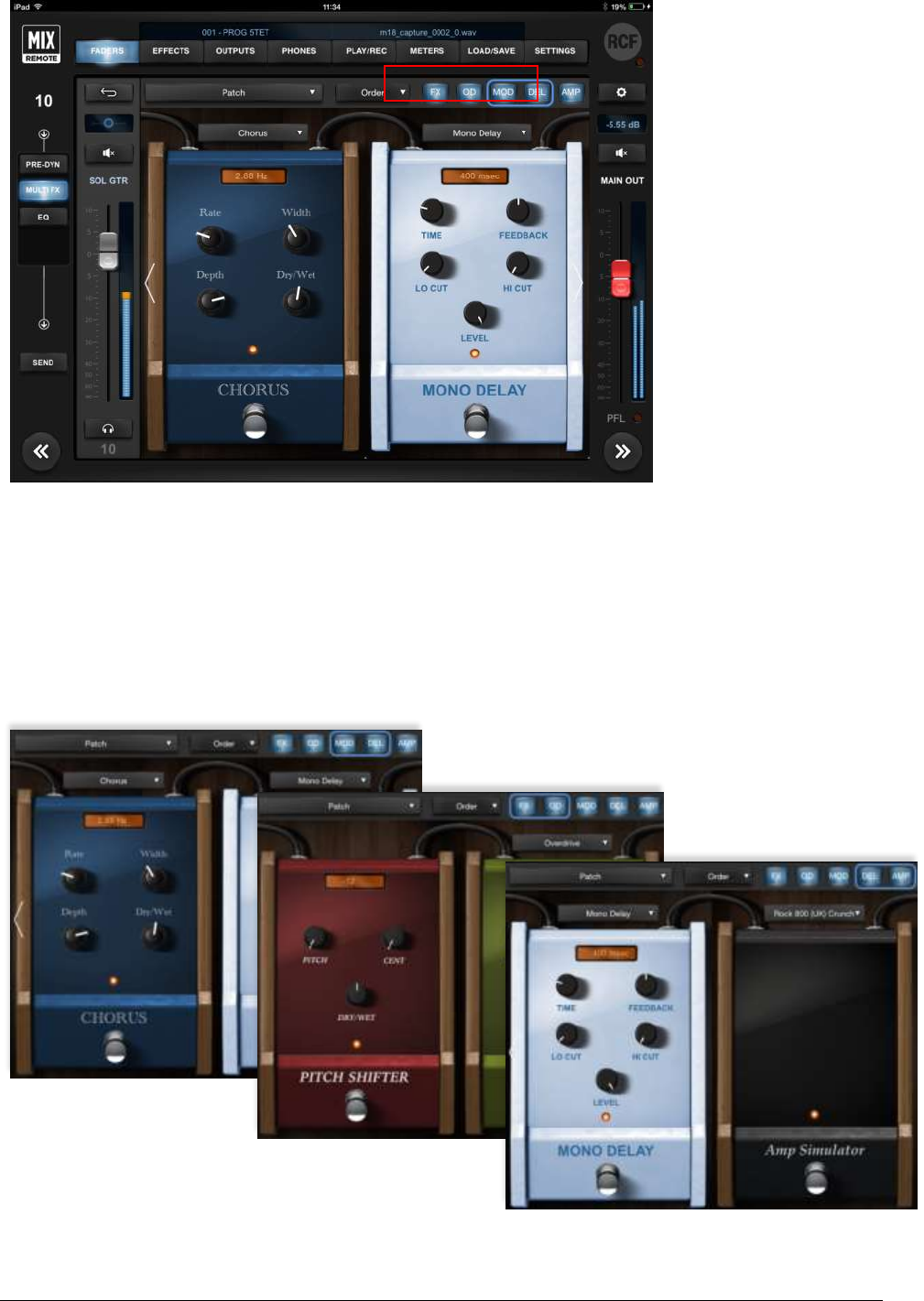
RCF spa
M 18 Digital Mixer User’s Manual
21
At the top of each pedal
there's a display
showing the last edited
control value. At the
bottom there's an
activation switch; its
status is displayed by a
light which is lit when
the unit is on.
The OD section allows
to choose between an
Overdrive and a
Distortion effect,
modeled after well-
known stomp boxes that
have been used by
guitar players for
decades.
The AMP processor is a special one: you can quickly select the amplifier type on its drop-down menu, and if
you tap anywhere on the pedal, you will be directed to the dedicated AMP page (see below) with several
useful controls.
Let’s see an example of the following effects order: DEL, FX, MOD, OD, AMP. The picture above shows the
first two effects; then, by tapping on the buttons at the top right (see red box), you obtain different views:
DEL
MOD
OD
AMP
MOD
FX
AMP
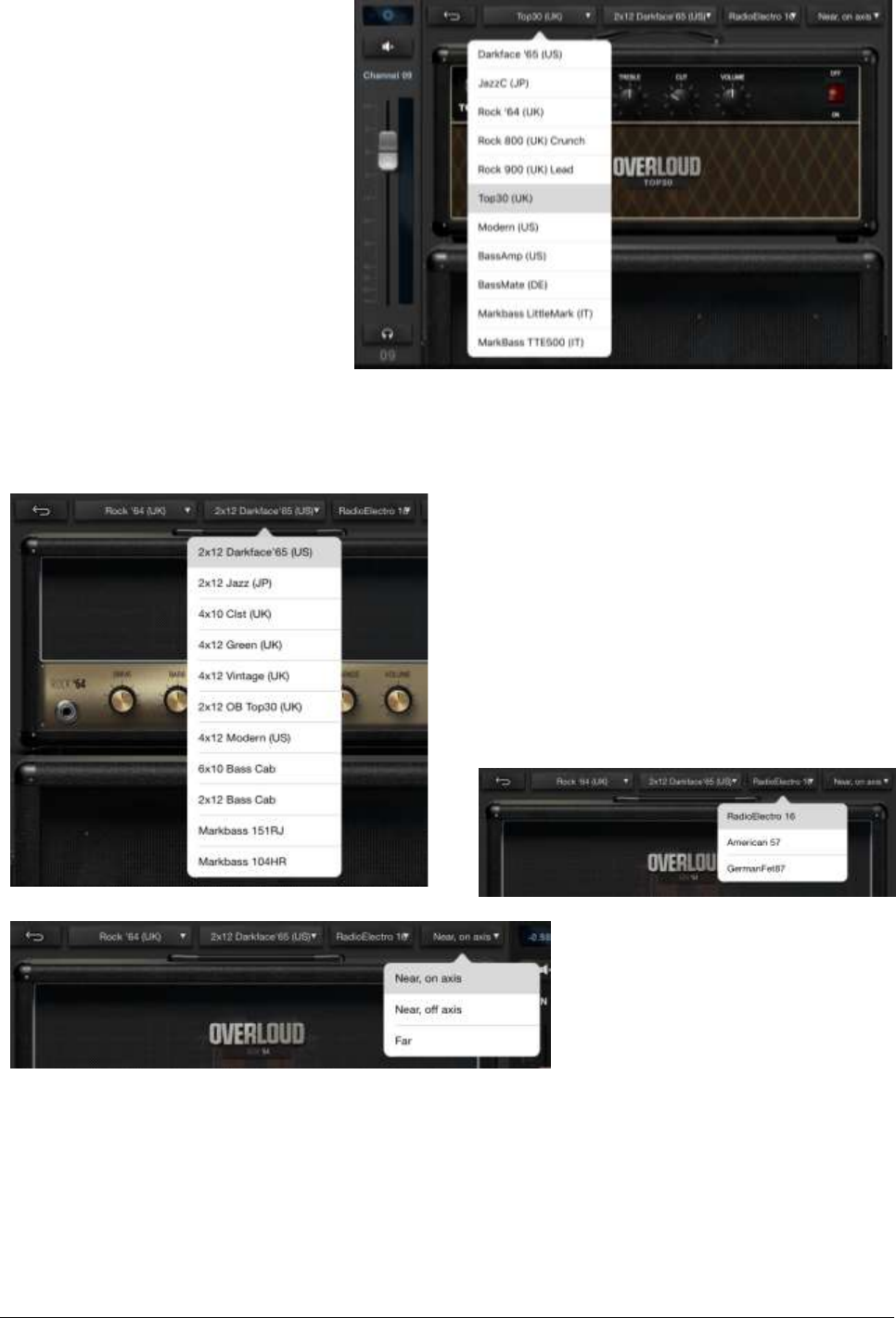
RCF spa
M 18 Digital Mixer User’s Manual
22
By tapping the AMP stomp box, a new
page shows up, with all the relevant
parameters on a single view for
maximum editing efficiency.
Each Head AMP simulation has a
preferred Cabinet combination, and
every time you select a Head AMP, the
matching Cabinet will show up. Then,
you can vary the Cabinet model and
experiment with unusual
combinations.
Each Head AMP has up to 6
parameters that accurately model the
controls available on the original
amplifiers.
The ON/OFF rocker switch represents the BYPASS switch, and has same function as the switch on the
stomp box view.
As visible on the left, most Cabinets have similar names to the Head AMPs.
The last four Head AMPs and Cabinets are dedicated to
bass guitar, covering a wide range of resulting timbre.
In addition to the OverloudTM models, two well-known
MarkBassTM models have been included.
You can also selet the microphone type which has
been used when modeling the AMP (see below):
RadioElectro 16 (large-diaphragm cardioid dynamic)
American 57 (small-diaphragm cardioid dynamic)
GermanFet 87 (large-diaphragm cardioid condenser)
The choice for microphone position is
between:
Near, on-axis
Near, off-axis
Far (1 metre from cabinet)
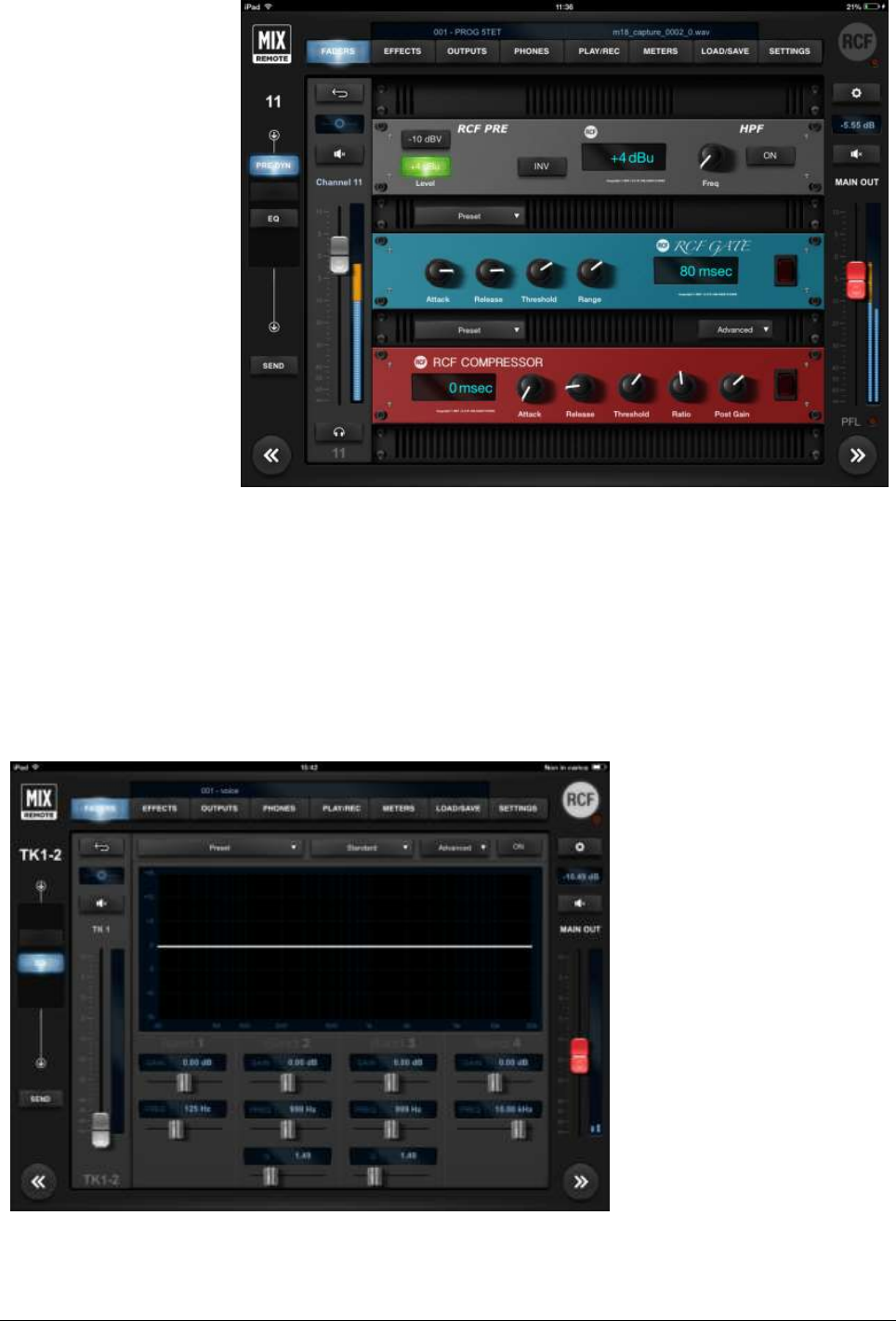
RCF spa
M 18 Digital Mixer User’s Manual
23
Inputs 11-18
Hardware inputs from
11 to 18 have line
connections, with the
option to switch
between -10dBV and
+4 dBu sensitivity.
INV and HPF other
controls are identical to
the other inputs, as you
can see on the right.
Stereo Player (from USB flash drive)
TK USB inputs are managed as a stereo input by default, but you can always unlink them in SETTINGS >
GLOBAL page.
As the audio is directly generated in digital, there is no need for PRE or DYNAMICS.
When you have a stereo track,
the typical use is in stereo
(linked) mode.
If you have a mono backing track
on one channel, and the
metronome click on the other,
then you may work in dual mono
mode, which allows you
independent pan and mixing
controls.
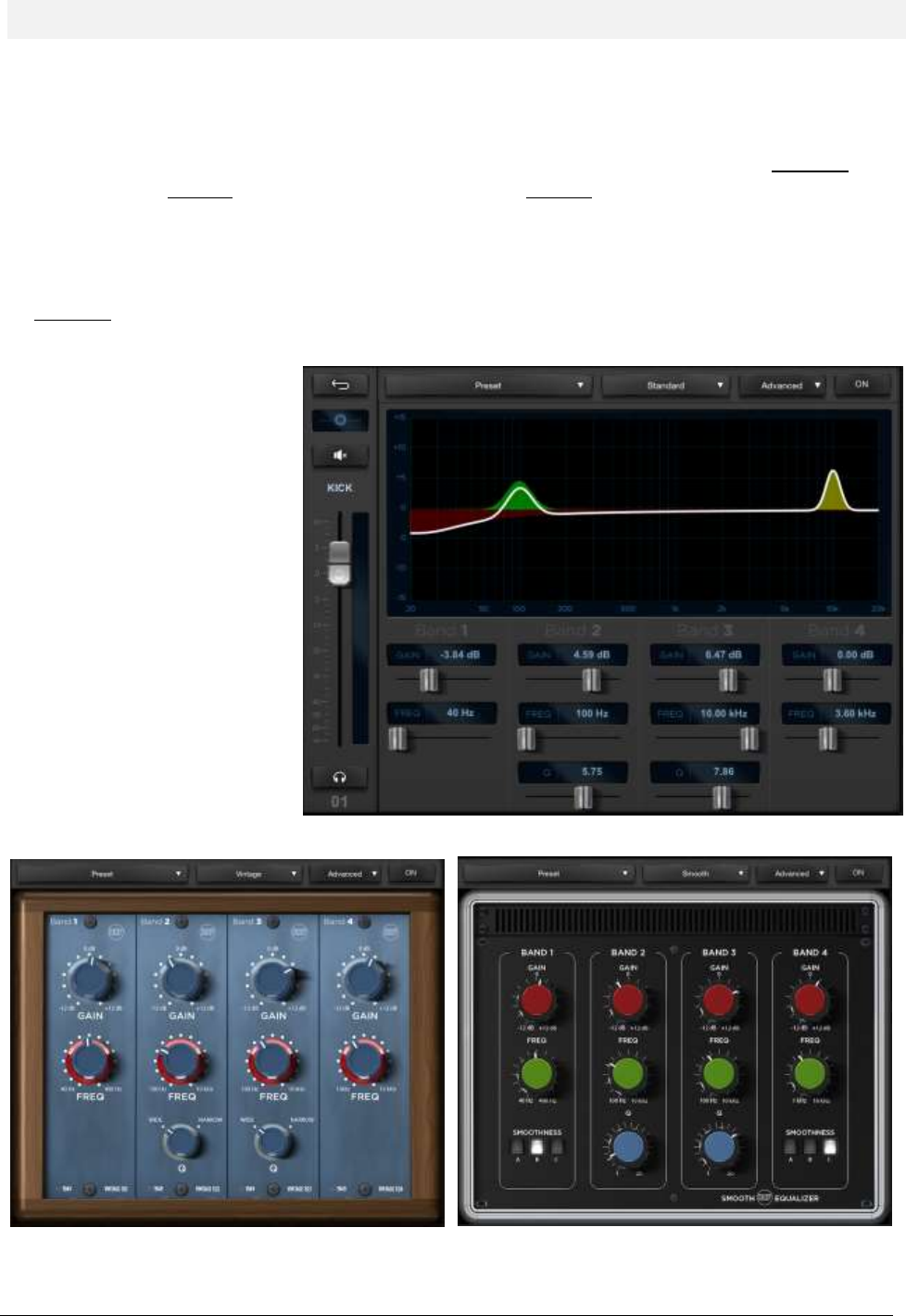
RCF spa
M 18 Digital Mixer User’s Manual
24
Input channels: EQ section
The 4-band EQ page is identical for all input channels - including TK channels. This page is characterized by
the large Preset box, followed by Standard and Advanced boxes and ON switch.
Great versatility is provided by allowing the selection of three different types of equalizer: Standard (a no-
frills, precise EQ), Vintage (modeled after a UK classic EQ), Smooth (whose modeling was inspired by a
modern US EQ). You have a wide choice that can help in providing the right color to your sound. For each
of the three equalizer types, two options are available: Advanced (showing all the available parameters)
and Easy (in which some of the more advanced controls are hidden to enable a quicker interaction).
In Standard mode, the display shows the operation of the 4-band equalizer (the overall intervention is
indicated by a white line).
The Advanced option provides
variable frequency shelving
filters for low and high bands
and two fully parametric mids,
while the Easy option provides
high and low shelving with fixed
frequency, and selection of the
frequency for mid-low and mid-
high.
The range of intervention goes
from -12.00dB to +12.00dB;
double clicking on the GAIN
resets the value to 0.00dB for
each band, while to completely
turn off the equalizer, you have
a global ON/OFF button right
above the display.
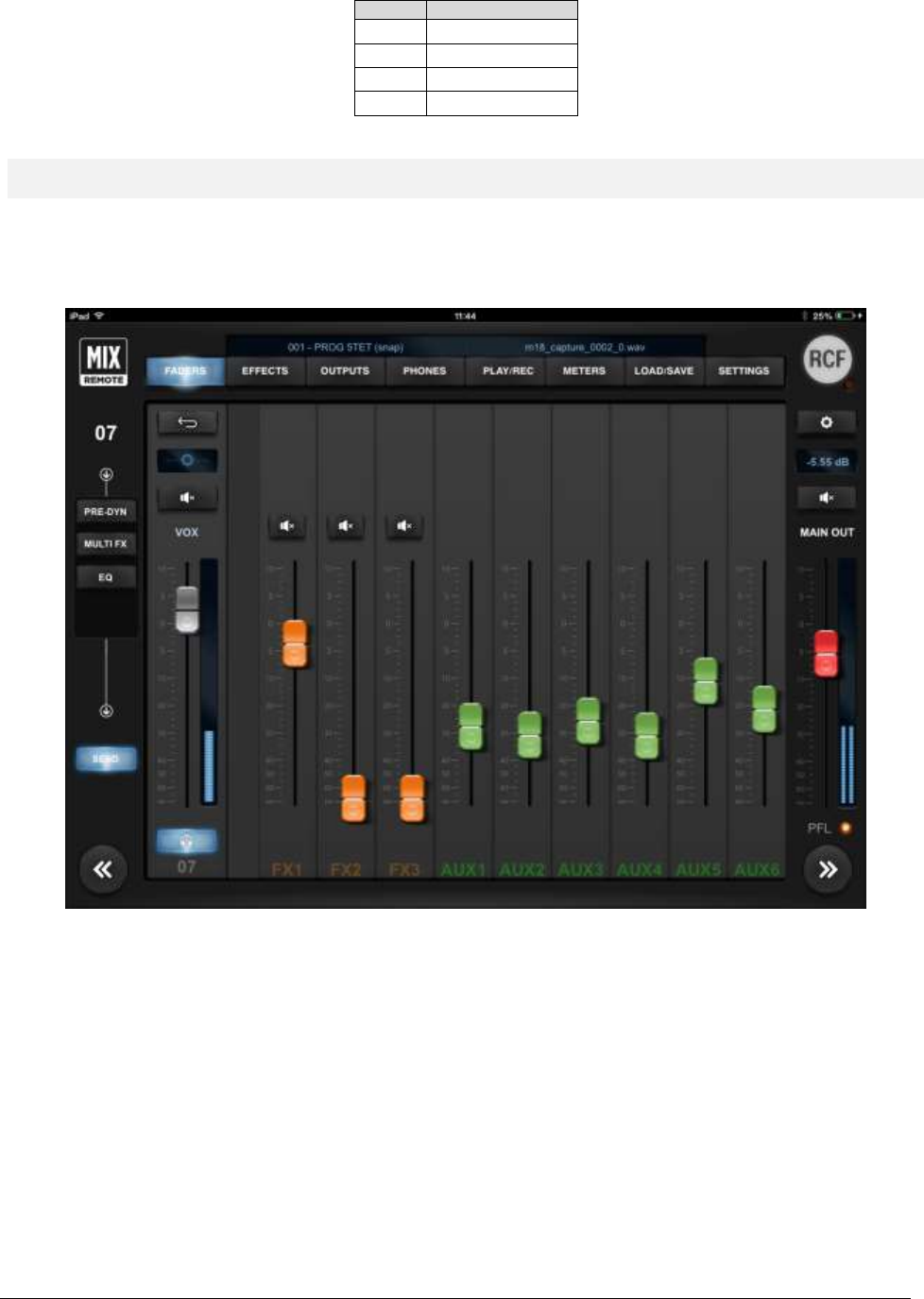
RCF spa
M 18 Digital Mixer User’s Manual
25
All three models, with the Advanced option, have the following frequency ranges:
Band
Freq. Range
LO
40-400 Hz
MID1
100 Hz – 10 kHz
MID2
100 Hz – 10 kHz
HI
1 – 16 kHz
FADERS > SEND view
For each of the input channels, the SEND page allows the accurate settings of three FX and six AUX sends.
FX sends are always post-fader, thus allowing the channel level to affect FX send levels, maintaining the
desired balance. AUX1-AUX4 sends are always pre-fader, thus allowing to set the required level
independently from channel level settings – this solution is ideal for stage monitoring. AUX5 and AUX6 can
be set pre or post fader independently for each input channel.
The central part of this page has 3 faders for FX sends and six faders for AUX send levels. Each of the FX
send faders feature a Mute button. To choose the effects of the three sends, please go to the EFFECTS tab.
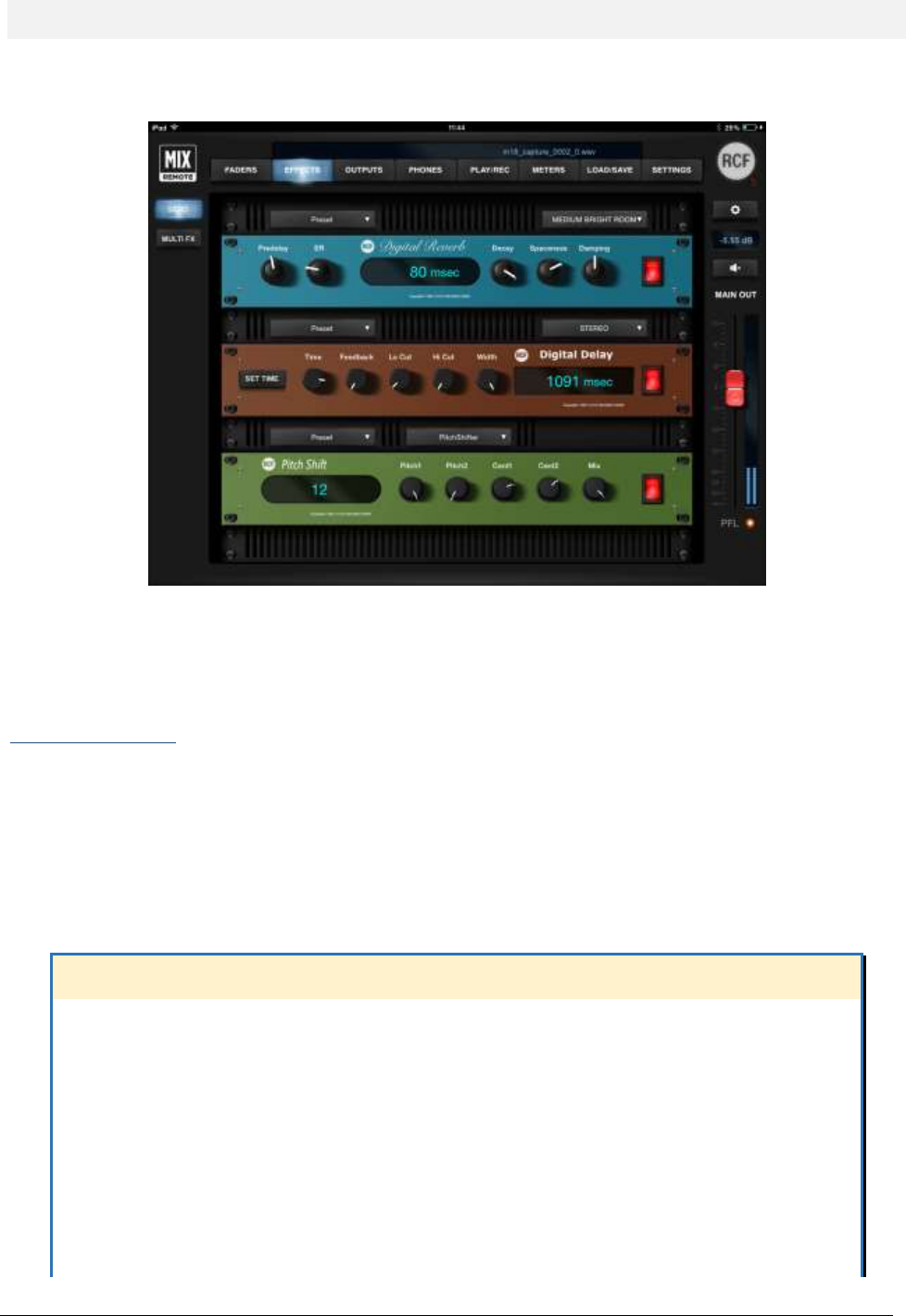
RCF spa
M 18 Digital Mixer User’s Manual
26
EFFECTS view
The EFFECTS tab contains two pages: SEND and MULTIFX.
The left column shows the SEND and the MULTIFX select buttons; the right column shows usual the MAIN
OUT controls.
EFFECTS > SEND
The SEND page shows the three rack mount effects units: FX1 for reverbs, FX2 for delays, and FX3 which
can be assigned to one of four different types of delays and modulations effects. On the upper left side
over each rack device there are small Preset boxes, to recall several factory presets. On the right left side
over each unit there is a box to choose the effect variation. Only on the third device, there is an additional
central box to choose the effect type among Delay, Chorus-Flanger, Tremolo and Pitch Shifter.
The large display shows parameter values and on the right there is the activation button for each effect.
IN DEPTH
The Digital Reverb lets you choose between two large hall, two medium hall, two medium rooms, two small rooms,
two plates and two ambiences.
You can create your own configurations by modifying the following parameters:
- Predelay (delay before reverb)
- ER (amount of primary reflections)
- Decay (time decay)
- Spaceness (percentage of spatialization)
- Damping (percentage of absorption of the higher frequencies)
The Digital Delay can be the chosen among Stereo, Vintage, Modern, Dual and ER.
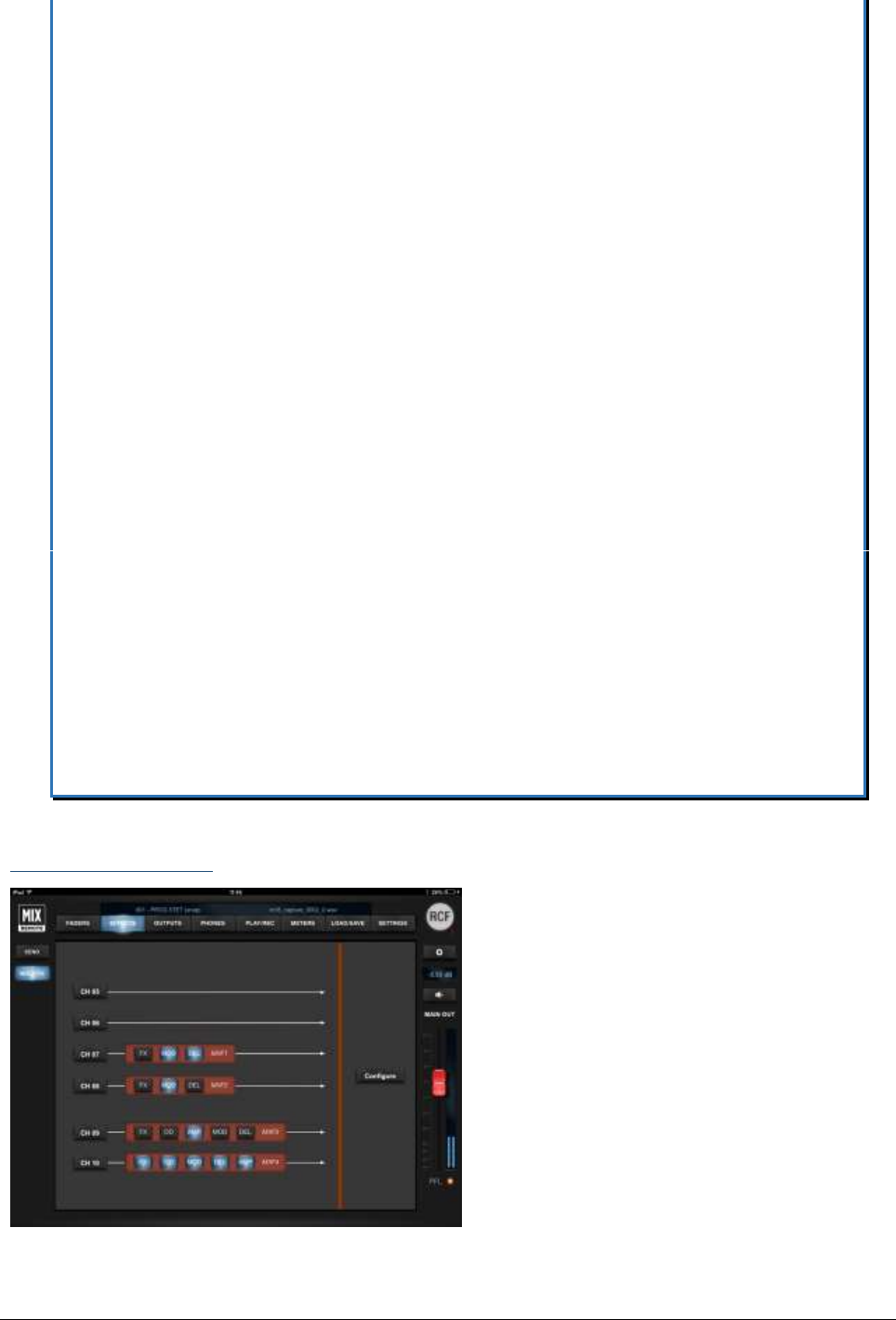
RCF spa
M 18 Digital Mixer User’s Manual
27
You can create your own settings for Stereo and ER by changing the following parameters:
- Time (length of the delay)
- Feedback (% of delay feedback)
- Lo Cut (low cut filter frequency)
- Hi Cut (high cut filter frequency)
- Width (amplitude)
Vintage delay parameters:
- Offset (offset time compared with main Time) instead of Feedback
- Filter (da 0,00 a 100) is a Band-pass filter
Modern delay parameters:
- Offset (offset time related to Main Time) instead of Feedback
- LoCut (low cut filter frequency) instead of Hi Cut.
Dual delay parameters:
- Factor (1/2, 1/3, 1/4, 1/6, 1/8 and 1/16) instead of Feedback
- Feedback 2 (% of delay 2 feedback) instead of Hi Cut
Chorus-Flanger parameters:
- Rate (frequency swing)
- Width (amplitude)
- Depth (depth swing)
- Feedback (% effect feedback)
- Blend (% mix between dry signal and processed)
Tremolo parameters:
- Rate (frequency rate)
- Depth (depth swing)
Pitch Shift parameters:
- Pitch 1 ( voice 1 note interval; from -12 to +12, in semitones , equivalent to +/- 1 octave)
- Pitch 2 ( voice 1 note interval; from -12 to +12, in semitones , equivalent to +/- 1 octave)
- Cent1 (detune of voice 1, in cents)
- Cent2 (detune of voice 1, in cents)
- Mix (% mix between voice 1 and voice 2)
EFFECTS > MULTIFX
This page shows the four channels that have
multiple effects. Here you can also configure
which pair of channels - Channels 05-06 or
Channels 07-08, which are active in this
example – will have the MFX option active. Only
channels 09 and 10 provide you five effects.
The order and ON/OFF status of each insert
effect is shown. Pressing any of these buttons
or the blue button, you access immediately the
corresponding channel.
For details about MFX options, please see
Inputs 05-08 and Inputs 09-10 chapters.
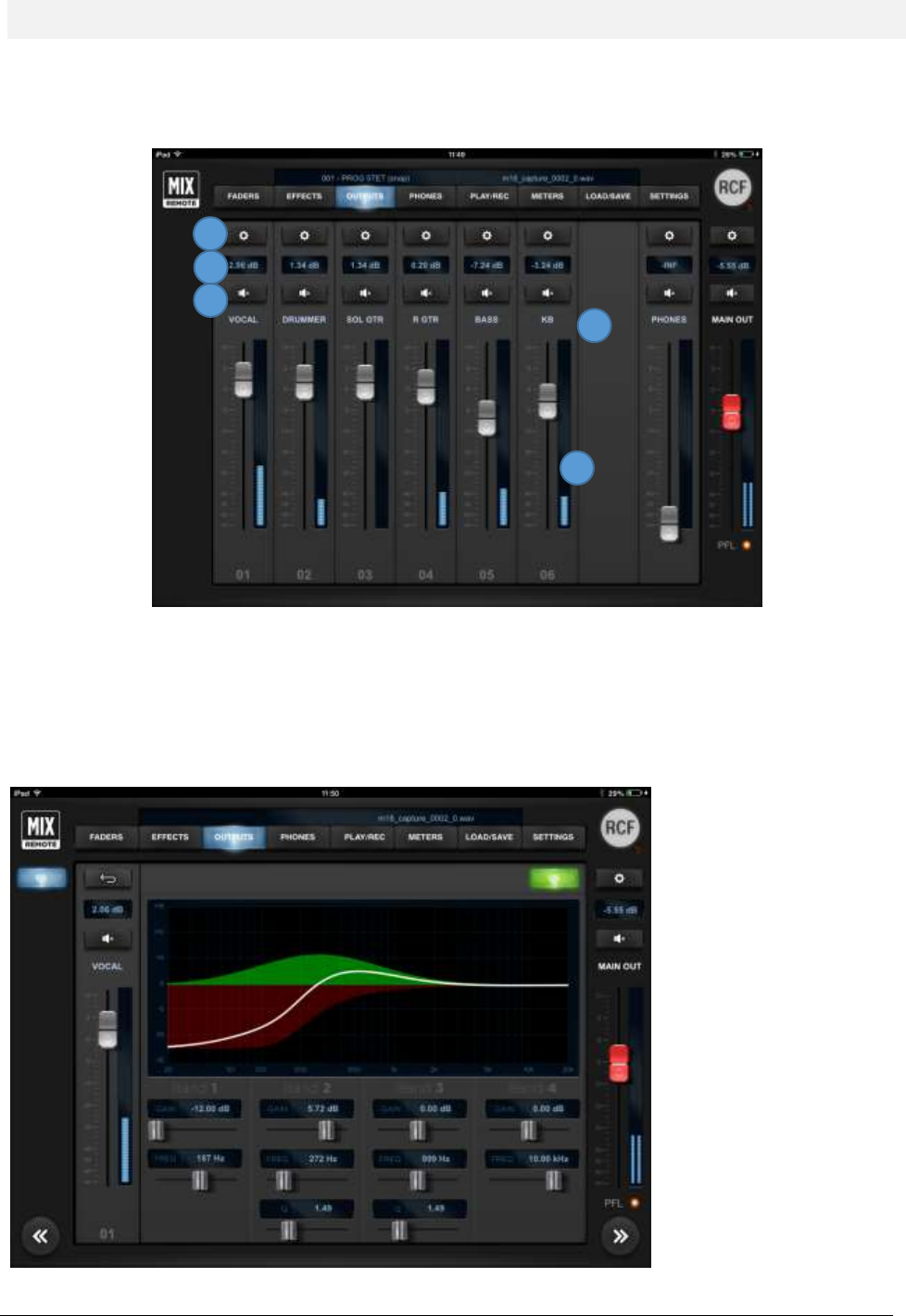
RCF spa
M 18 Digital Mixer User’s Manual
28
OUTPUTS view
This tab has one page only, which shows the six silver master faders for the AUX sends, the PHONES master
level, as well as MAIN OUT master level on the rightmost column, as in most views.
Each AUX output has a * button to recall the settings pages (1), a box indicating the level of the individual
fader in dB (2) and a Mute button (3); just above the fader there is a text field (4) which by default indicates
the send number, but of course can be renamed; the fader (5) for master output level is above output
number, which corresponds to the physical AUX socket.
Pressing *, you recall the
OUTPUTS EQ page,
containing the Advanced
EQ for that AUX send; the
other controls are for level
and mute.
The “Advanced” equalizer
features low (40Hz-400Hz)
and high (1kHz-16kHz)
shelving and two fully
parametric bands (range
100Hz-10kHz for both).
1
2
3
4
5
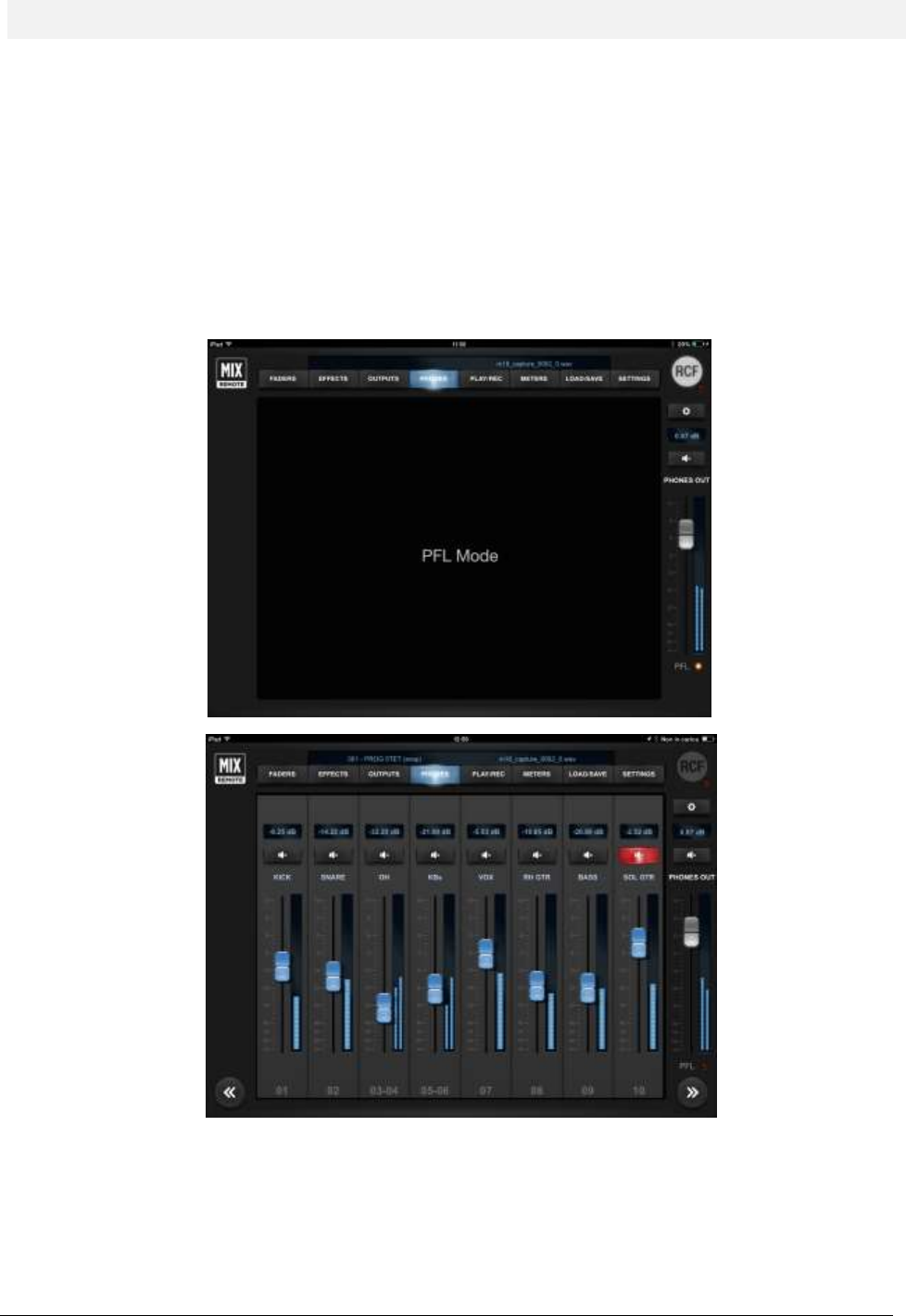
RCF spa
M 18 Digital Mixer User’s Manual
29
PHONES view
The way the PHONES output works depends on SETTINGS tab GLOBAL page selection. You can choose the
operating mode between PFL (Pre-Fade Listen) or Personal Mix.
In Personal Mix mode, the central column of the PHONES page includes a box indicating the level of the
individual fader in dB or the pan-pot position, a small Mute button, a text box which by default is the
number of the send, which can be renamed, and a blue fader for headphone level and the non-editable
number of the hardware socket. The level is pre-fader.
In PFL (pre-fade listen) mode, the signal to the headphones is set by the PFL key of each input, the USB
player and FX RET.
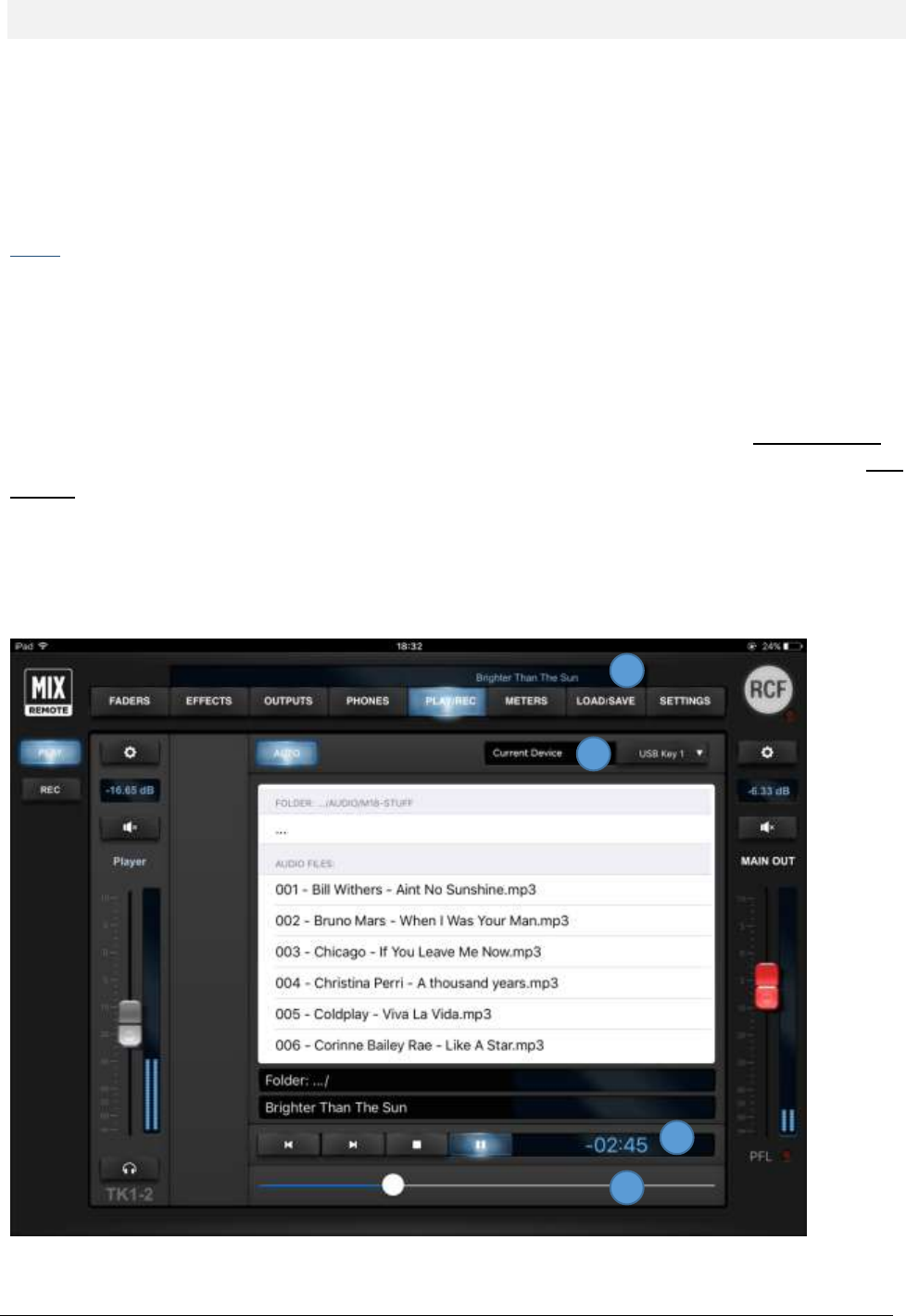
RCF spa
M 18 Digital Mixer User’s Manual
30
PLAY/REC view
Two tabs are available on the left column, and you can select either the stereo PLAYER or the stereo
RECORDER views; both access files on a USB Mass Storage device (USB pen drive, or external HDD)
attached to the local USB host port. Within specific conditions, player and recorder can operate
simultaneously even on the same USB device.
PLAY
This view shows the channels TK1 and TK2 of USB playback. Please note that these channels are stereo
linked by default; if you want independent settings for each channel, you have to un-link them using Input
Stereo Links in SETTINGS tab, GLOBAL page. These channels are processed by a dedicated EQ, of the same
type as other input channels; therefore, three types are available (Standard, Vintage, Smooth) each with
two modes (Advanced and Easy).
On the right side of these controls there is a time indicator (1); by default, it shows the remaining time to
the end of file. By clicking on the time indication, you can toggle the value shown to represent the time
elapsed. A scroll bar (2) shows the current position within the file; you can grab the scroll bar and move to
the desired position, either when in playback mode or stop mode. A drop-down selector (4) on the upper
right corner allows the selection between different 4 USB flash drives; this is required in case multiple USB
flash drives are connected through a USB hub.
On the upper bar, on the right side, you can view (3) the file currently selected on the player.
3
4
2
1
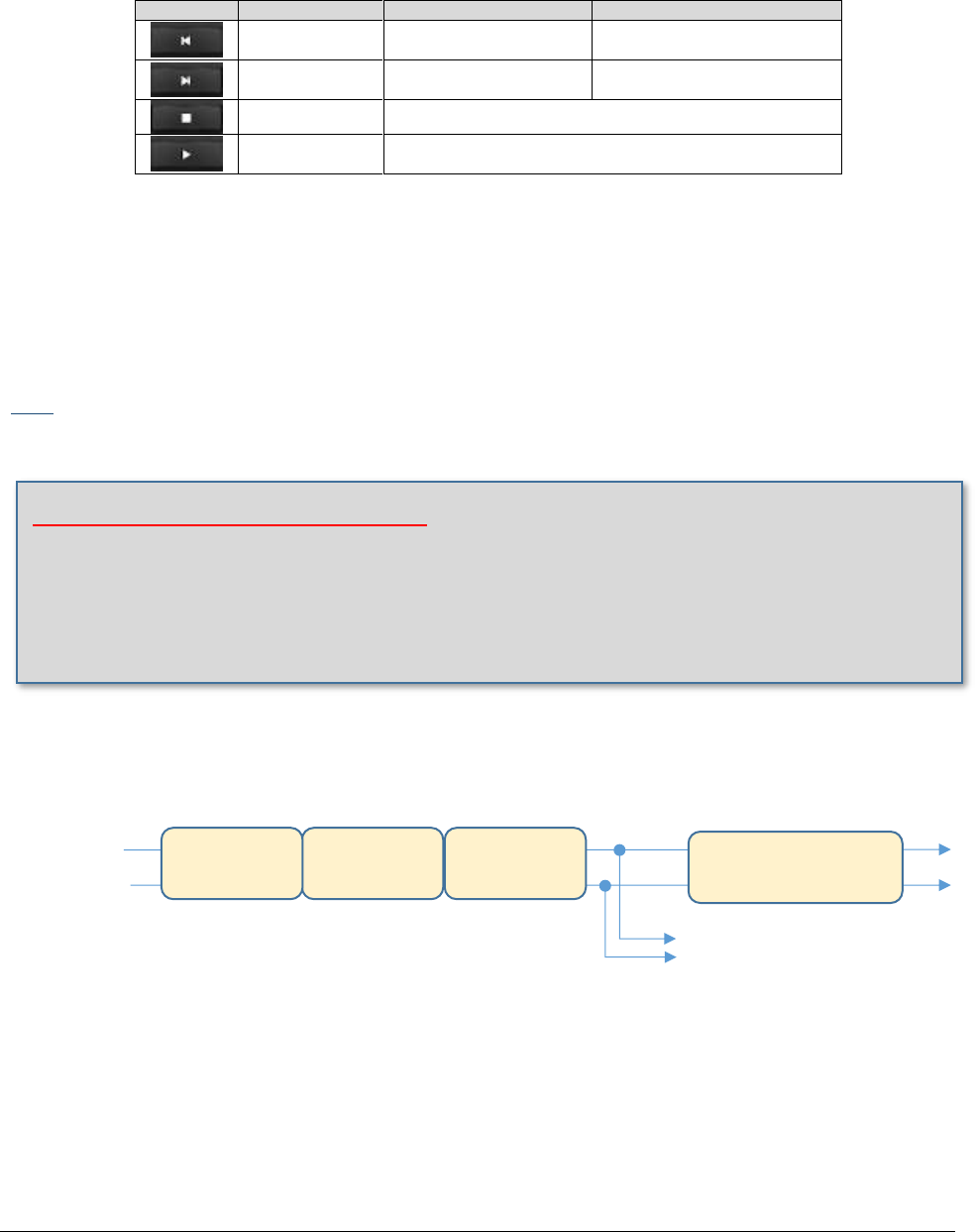
RCF spa
M 18 Digital Mixer User’s Manual
31
A large selection pane allows you to navigate through the USB flash drive folder (upper section), and then
to select the specific files (lower section). To navigate to the previous directory, in the folder section, you
can click on the line with 3 dots. Please notice that with a very large amount of files, it takes several seconds
to show all file names.
Under this window there are the following player controls:
AUTO ON
AUTO OFF
PREV
Go to previous file in list and
PLAY
Go to previous file in list and STOP
at beginning
NEXT
Go to next file in list and
PLAY
Go to next file in list and STOP at
beginning
STOP
STOP current playback and rewind to beginning of file
PLAY/PAUSE
Toggle between playback of current file and PAUSE at current
position
The following audio file formats are supported by the player and shown in the file list:
• WAV stereo audio files; 44.1 and 48 kHz, 16- and 24-bit (*.WAV extension)
• AIFF stereo audio files, ; 44.1 and 48 kHz, 16- and 24-bit (*.AIF and *.AIFF extensions)
• MP3 stereo audio files (*.MP3 extension)
REC
The REC window allows high-quality, stereo recording of the MAIN left and right channels. The tap point is
after the Mastering processor, and before the Graphic Equalizer (which is generally used for settings that
are a function of the available amplification system).
The currently available format is 24-bit, 48 kHz (the internal sample rate of the M18 Digital Mixer).
As the recording level greatly depends on the number of active inputs, a wide-range Rec Trim control (1) is
available. The minimum value of -18 dB is intended for full use of the mixer, with all inputs being used.
The meter (2) below shows the audio level after the Rec Trim regulation, so that you can check if you are
too close to clipping.
On MixRemote ver. 1.0.2 (previous version)
This view is not available, you can access the PLAY view only.
You will need to upgrade both the MixRemote app to ver. 1.1.0 and the mixer firmware to build 203 to
have access to the REC page.
Valve
Warmer
Xciter
Maximizer
L-R
mix
To stereo RECORD section
Graphic
EQ
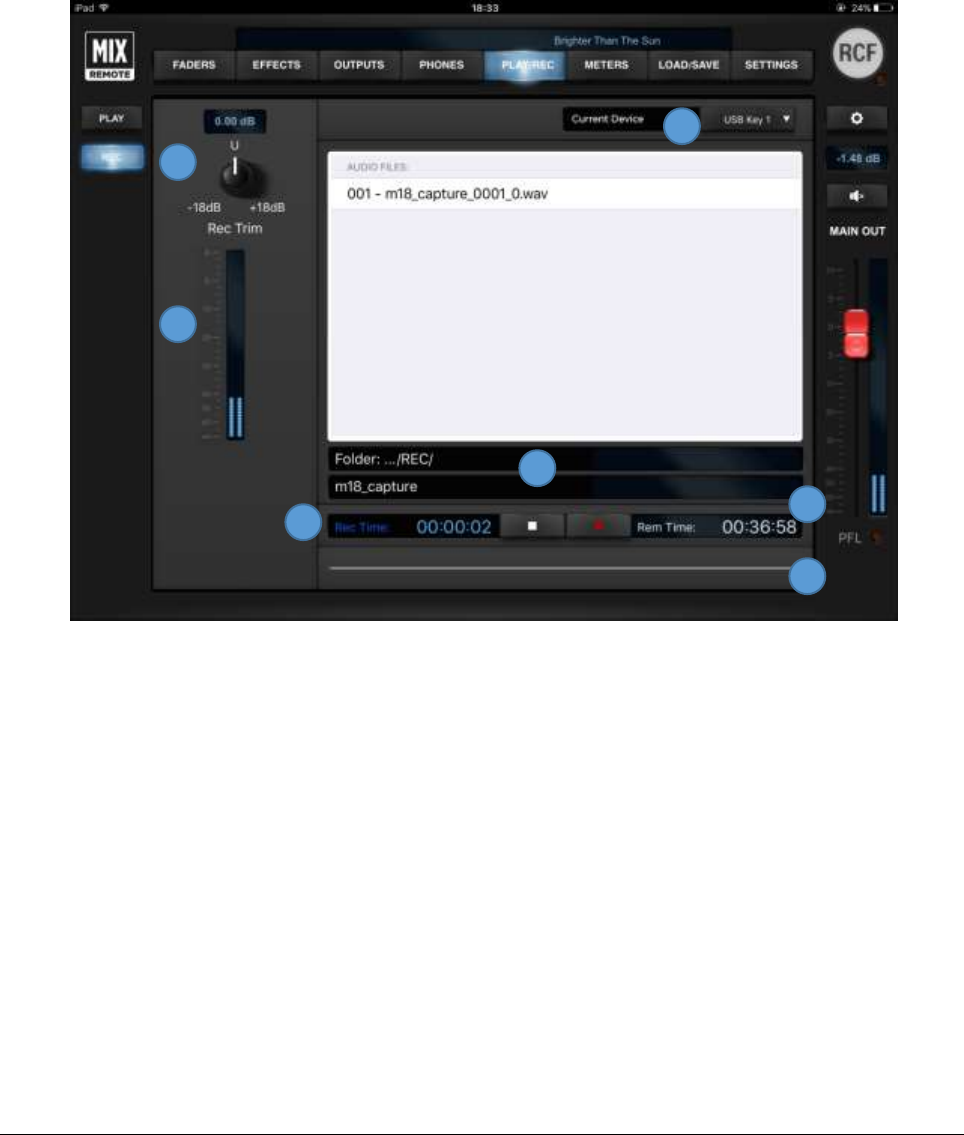
RCF spa
M 18 Digital Mixer User’s Manual
32
All recordings are stored in the /REC folder within the USB Mass Storage device being selected on the
upper right selector (3).
A default name is generated if no specific name is entered, of the form m18_capture_XXXX_0.wav, where
XXXX is a numeric counter to ensure a unique filename.
To modify the filename, it is sufficient to touch the folder/filename area (6) and a text entry popup shows
up.
If a name is given, the numeric counter is automatically appended every time a new record begins.
The file is auto-saved every ten seconds, so that any unwanted interruption (i.e., the USB storage device is
removed abruptly, or M18 power is turned off ) does not result in a total loss of audio data.
Two time indications are shown: the time since start of recording (5) and the remaining time (4) calculated
on the available storage size. A progress bar (7) shows the status compared to the remaining time, defined
as above.
While M18 is quite flexible in terms of USB storage device capabilities for playing back files, a good quality
device is required for recording on USB in real-time.
FAT32 is the only supported file format on M series digital mixers, and is also the safest cross-platform
(Mac / PC) format. Please avoid FAT formatting as we have noticed random problems in playback of audio
files.
Please notice that the minimum supported size for audio recording is 4 GB (mainly due to variations if
formatting results for smaller size devices).
2
1
3
4
5
6
7
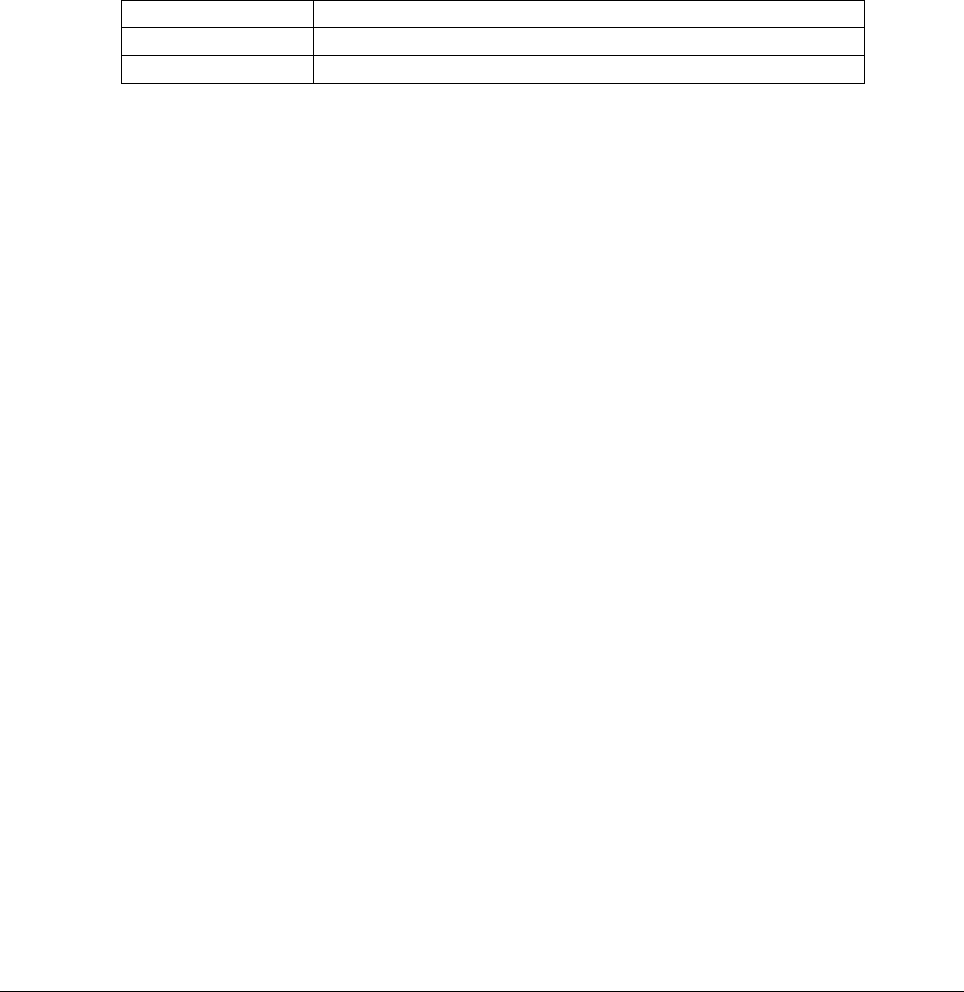
RCF spa
M 18 Digital Mixer User’s Manual
33
Furthermore, consistent and error-free results have been obtained with premium, good-quality USB pens.
Several lower-quality devices can cause random errors due to their lower data transfer performance. USB
3.0 compatible storage devices are recommended, as these guarantee higher data throughput.
Due to filesystem limitations, the internal recorder can generate a file with maximum size of 4 GB,
corresponding to more than 3 hours of continuous recording. If this limit is exceeded, the recorder closes
the current file and creates another file with a minimal audio gap, without interrupting the recording
process.
We have found on several USB devices, that it is recommended to have at least 50% free space on the USB
key; beyond this percentage, most USB keys show significant fragmentation and in this case glitches can
appear in the recorded files.
In case you need to reformat a USB pen for audio recording, please follow these guidelines:
Operating System
FORMAT settings
Windows (any)
File System = FAT32, Allocation Unit Size = Default
Mac OS X
Format = MS DOS (FAT32), Scheme = Master Boot Record
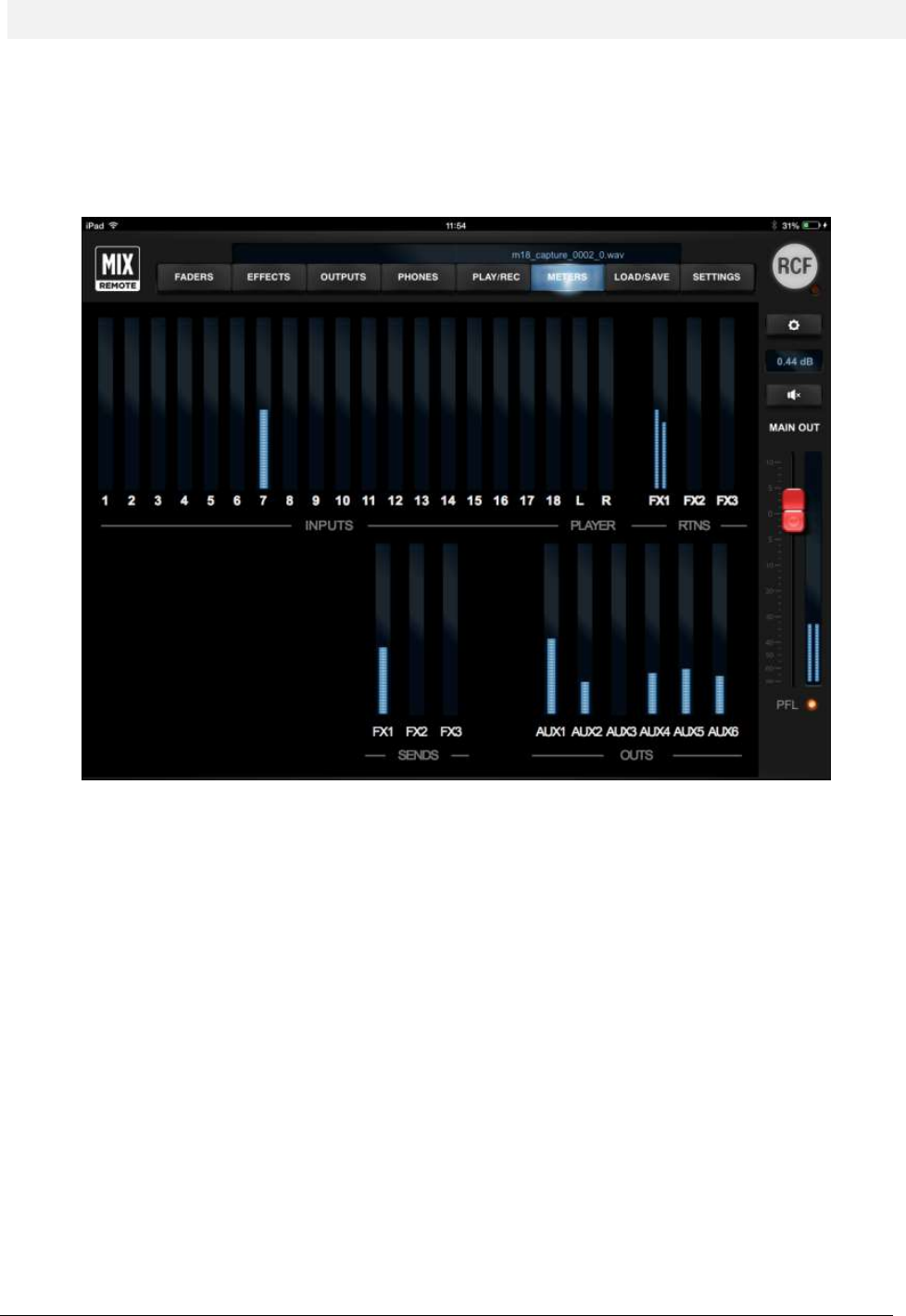
RCF spa
M 18 Digital Mixer User’s Manual
34
METERS view
This tab has just page, which provides an instant view of the levels of all INPUTS - including the PLAYER –
and of three FX stereo returns (RTNS).
The lower section shows the output levels of the three FX SENDS and the OUTS level of the six AUX sends.
This view is very useful to quickly check which signals are actually active, and it is recommended to check
this view every time you want to verify the mixer status.
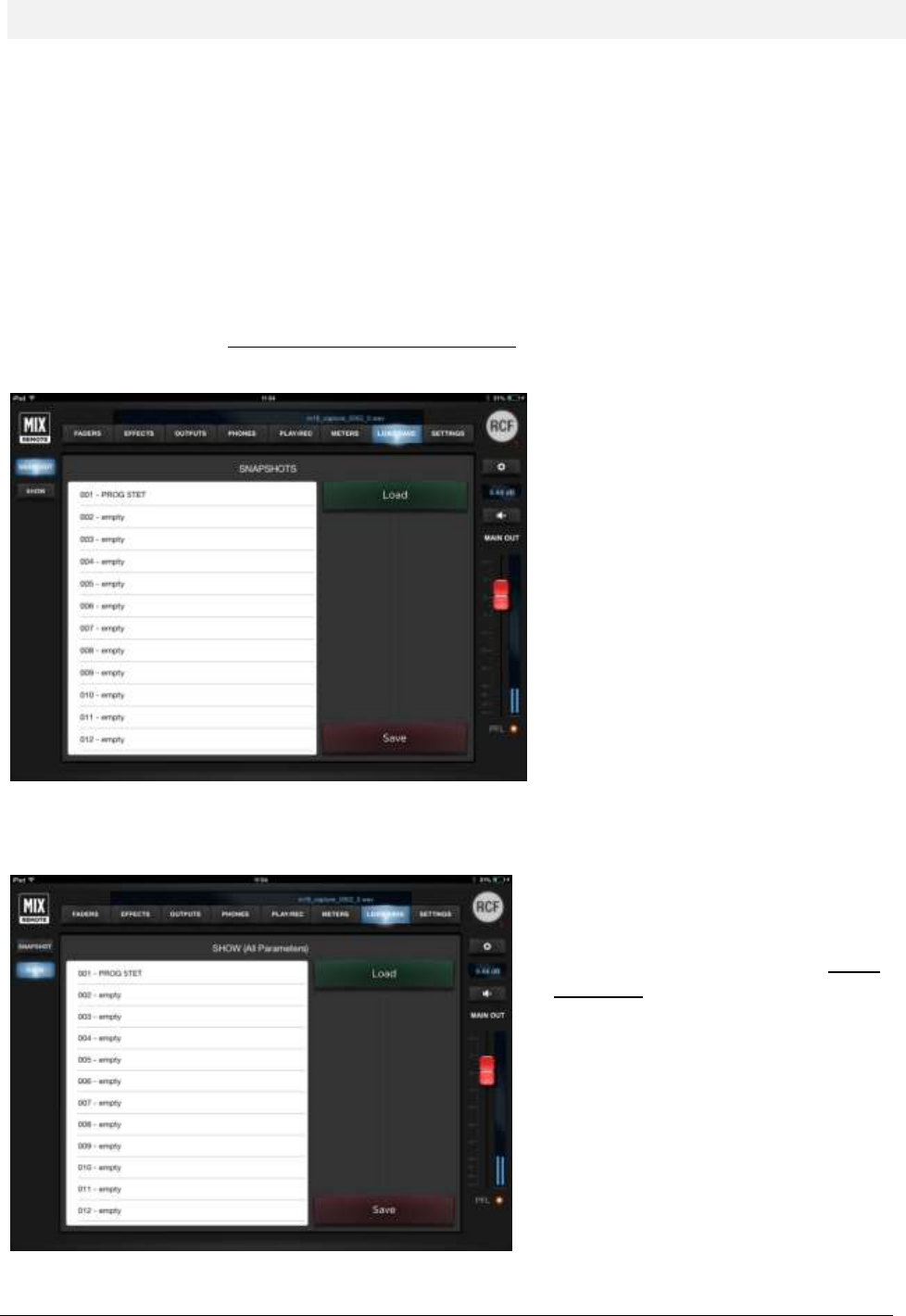
RCF spa
M 18 Digital Mixer User’s Manual
35
LOAD/SAVE view
This section features two pages: SNAPSHOT and SHOW. Using these pages you can save up to 200
SNAPSHOT presets or 100 SHOW presets that you can recall later by pressing the load button after the
selection of the desired snapshot/show number.
SNAPSHOT
The snapshot presets include all the settings but outputs. They are intended for storing all the parameters
that you would typically fine tune in advance for a specific song or context; with them , you avoid affecting
output settings (level, equalization, monitor busses) so that a Snapshot change does not modify the settings
that are usually found during the sound check within the venue for the live act.
A Snapshot Load action does not mute the audio outputs, but applies parameter changes smoothly to
minimize audio artifacts.
Please note that in SETTINGS > SYSTEM
page you can select whether to include
MFX patches recalls independently for
each MFX.
When saving a Snapshot, you have a
further option: you can enable the save
of Mix Bus parameters (see at page 12).
This is useful when the M18 Digital Mixer
is being used as a submixer, in which
case the channel levels are part of the
overall sound creation process.
To load a Snapshot, first select the
Snapshot number on the left pane, and
the press Load.
SHOW
The Show includes all parameters
pertaining to inputs and outputs, except
the global configuration parameters (see
at page 12). A Show Load action mutes
all outputs, to avoid sudden level
changes.
To load a Show, first select the Show
number on the left pane, and the press
Load.
To save a Show, first select the Show
number on the left pane, and the press
Save; you have the option to edit the
Show name before confirming the Save
operation.
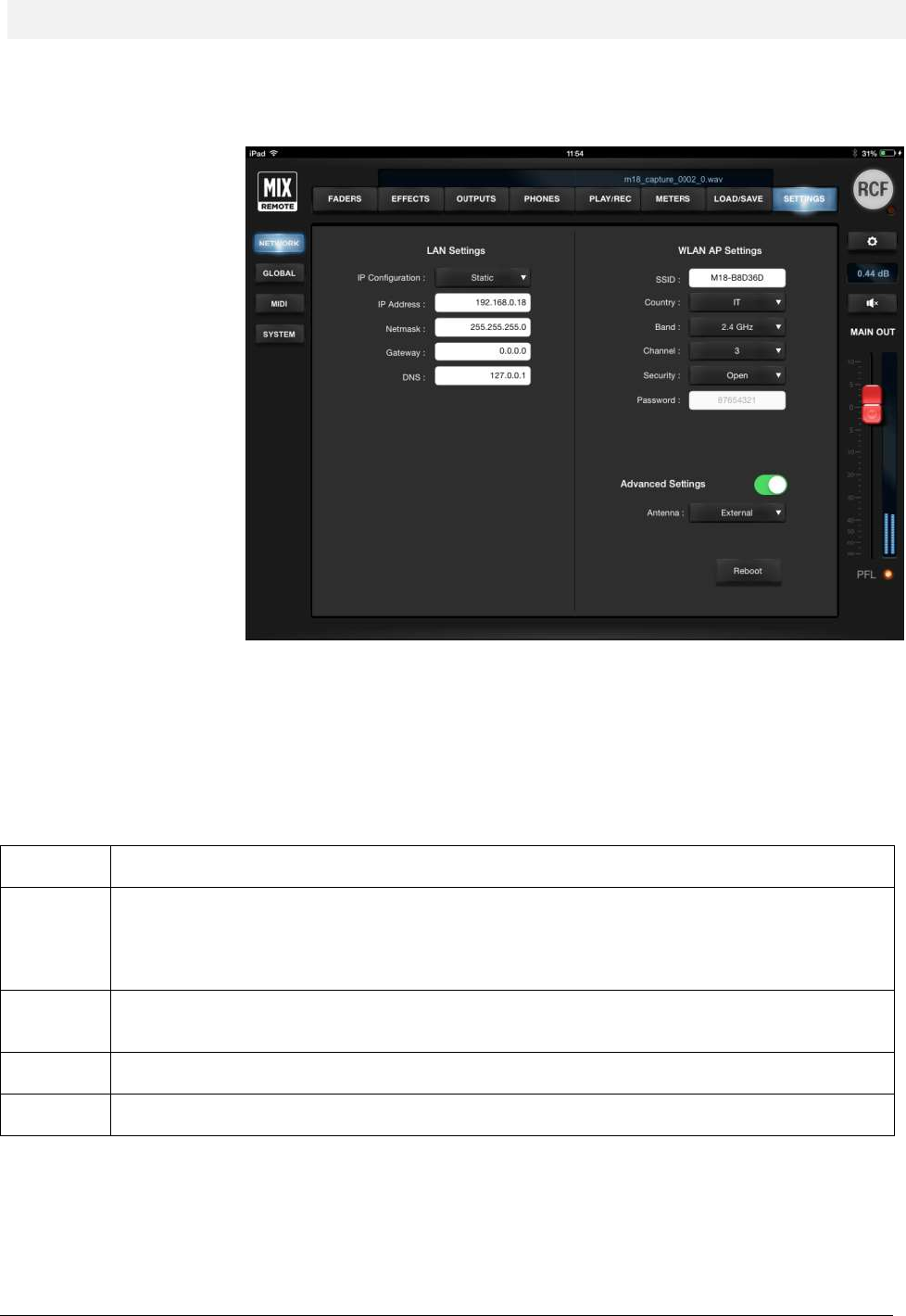
RCF spa
M 18 Digital Mixer User’s Manual
36
SETTINGS view
The SETTINGS view allows access to all of the global configuration parameters (see at page 12). Four tabs
are available, on the left column.
NETWORK
Two sections are
accessible from the
NETWORK view: on the
left side, for the wired
LAN port; on the right
side, for the internal
Wireless LAN Access
Point.
LAN Settings: all network-related adjustments can be made, such as IP Address, Netmask, Gateway and
DNS. These settings are usually left at the factory values, but they can be modified for special uses.
Standard usage of the M18 Digital Mixer does not require the LAN port.
WLAN Settings: all WiFi-related adjustments can be made, mostly like a standard WiFi Access Point. The
parameters are described in detail here:
SSID
You can modify the factory setting to provide a name you can remember. The factory name is in the form M18-
XXXXXX where the latter are a combination of letters and numbers.
Country
By selecting the appropriate country where you are operating the mixer, you can comply with local radio
regulations. Please notice that if you leave to the default value NONE, transmitting power is limited and you will
not obtain the best performance from the M 18 Digital Mixer, including maximum distance and robustness to
interference
(feature not allowed on USA/Canada software version)
Band
You can select between the usual 2.4 GHz band and the less crowded 5 GHz band, depending on your tablet
capabilities. For USA and Canada markets, the 5 GHz band is not allowed, according to the local FCC/IC
regulations.
Channel
You can minimize interference from other Access Points by selecting a channel not being used by others. There
are several scanning software applications that enable you to view which channels are available.
Security
You can either keep the Access Point open, or enable WiFi security (WPA2/PSK). In this case, you will be able to
modify the default password.
After you perform all changes to either LAN of WLAN parameters, you must press SEND to modify these
settings into the mixer. A reboot will be required to make these changes effective.
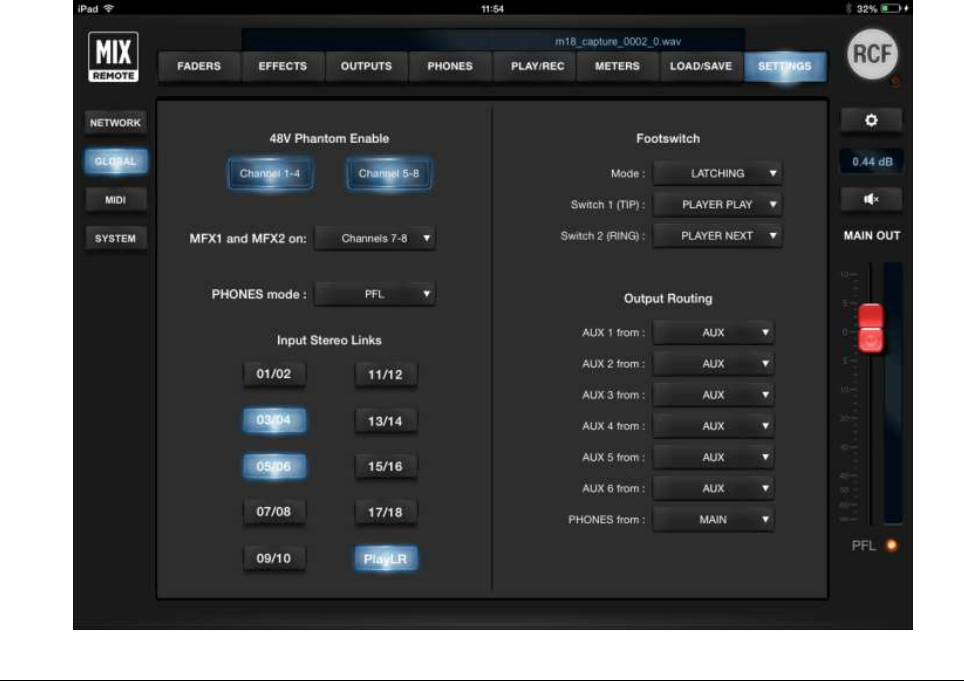
RCF spa
M 18 Digital Mixer User’s Manual
37
If you enable Advanced Settings, then you can switch between the internal and external antennas. This
change is immediate and does not require a reboot.
The Reboot button is intended for advanced applications, and should be avoided in normal usage.
GLOBAL
This page contains several settings affecting the operating mode of the mixer.
The 48V Phantom Enable section allows the activation of 48V phantom power for microphone inputs in
groups of 4, using Phantom 1-4 and Phantom 5-8 switches.
The Phones Mode section sets the mode of the headphone output, allowing the selection between PFL (on
FADERS INPUT page) and Personal Mix.
The Input Stereo Links section allows you to link in stereo an odd channel with the next even channel. After
the link, all settings from the odd channel will be copied to the even channel, and in the bottom row the
numbers of paired inputs will show up (e. g. 03-04) below a single fader with stereo VU meter. The Link
option is available for all inputs (1 to 18) plus the stereo player from USB flash drive. By default the player is
linked in stereo.
The Footswitch section controls allows you to determine the footswitch operation; Mode allows you to
choose between LATCHING or MOMENTARY N.C. footswitch contact. Then there are SW1 assign (TIP) and
SW2 assign (RING) drop-down menus listing all the parameters to be controlled.
The Output Routing section has drop-down menus to choose the source for several physical output:
- AUX output between its relevant AUX, MAIN or PHONES busses
- PHONES output between MAIN and PHONES busses
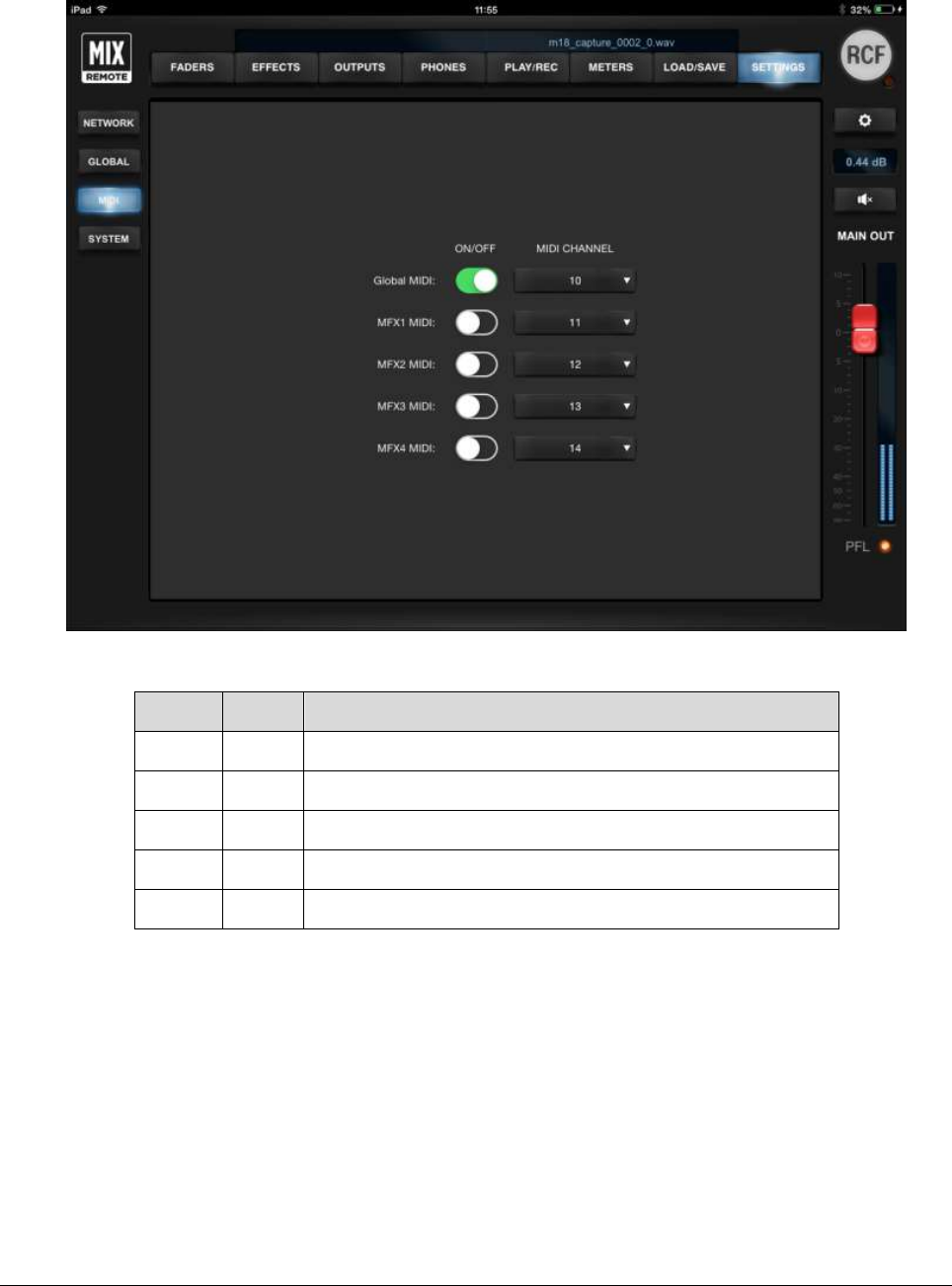
RCF spa
M 18 Digital Mixer User’s Manual
38
MIDI
This page manages allows the define which MIDI are associated with specific functions. You can also disable
reception of MIDI commands.
Section
Default
MIDI ch
Description
Global
10
The allowed commands include output levels (CC messages), player control
(NOTE on) and snapshot load (Pgm Change messages)
MFX1
11
Multieffect MFX1 (assigned to either input ch 5 or 7) patch change (Pgm change
messages) and individual effect toggle (NOTE on)
MFX2
12
Multieffect MFX1 (assigned to either input ch 5 or 7) patch change (Pgm change
messages) and individual effect toggle (NOTE on)
MFX3
13
Multieffect MFX3 (assigned to input ch 9) patch change (Pgm change messages)
and individual effect toggle (NOTE on)
MFX4
14
Multieffect MFX4 (assigned to input ch 10) patch change (Pgm change
messages) and individual effect toggle (NOTE on)
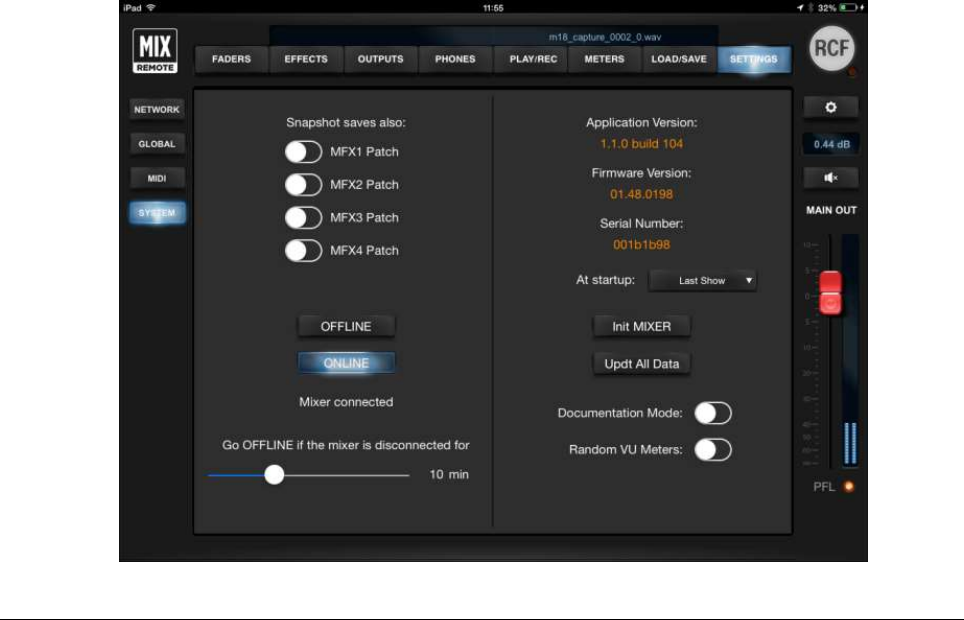
RCF spa
M 18 Digital Mixer User’s Manual
39
SYSTEM
This page contains system settings affecting the M 18 Digital Mixer operations.
The Snapshot saves switches allow to save also the MFX patch numbers, independently for each MFX. In
this way, you can associate saved patches of each MFX to the current Snapshot.
The ONLINE and OFFLINE buttons allow a change of connection status. Immediately below, there's a text
line indicating the status of the mixer (Mixer disconnected or Mixer connected).
There is the option “Go OFF-Line if the mixer is disconnected for:” followed by its time line to choose how
many minutes, in a range from 1 minute to 30 minutes. We suggest to keep it to the maximum value.
WARNING: if disconnection is frequent, please check the WLAN connection in SETTINGS tab
NETWORK page.
On the right side, we have the Application Version and the Firmware Version.
These information are followed by At startup behavior setting: you can select between Init Mixer (the
mixer powers up in initialized state, with all faders turned down) and Last show (at power-up, the mixer
loads the last show that was either loaded or saved).
In case of communication issues between the tablet and the mixer itself, you can press
Updt All Data, which recalls the last active status of the mixer, including all the changes done.
Documentation Mode contains information for our team... nothing useful for the use of the unit ☺
Random VU Meters activates the VU Meters when the mixer is disconnected, and is used for demo
purpose only!
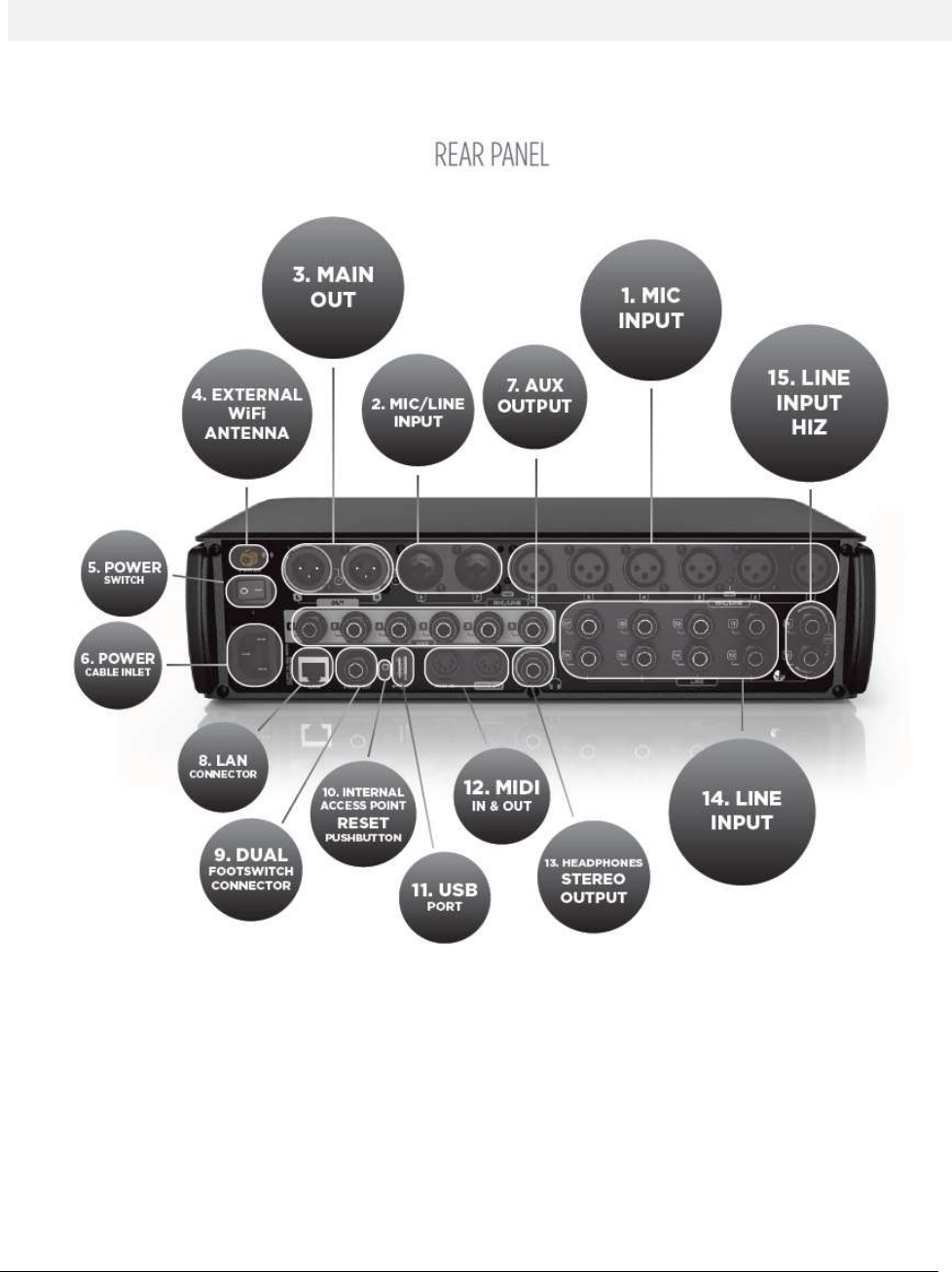
RCF spa
M 18 Digital Mixer User’s Manual
40
Hardware Description
Connectors
All connectors are available on the rear panel, for maximum compactness.
1. MIC Input 1 to 6 – XLR Female
Connect your Microphones to these remotely-controlled 60dB gain-range inputs. Red LEDs
indicate the Phantom power status ON or OFF for MIC input groups 1 to 4 and 5 to 8. To obtain
best performances from your microphones, use balanced XLR cables.
2. MIC/LINE Input 7 and 8 – Combos
Input 7 & 8 provide Mic input on the XLR connection and Line input on the TRS jack connection.
3. MAIN OUTPUT L&R
Connect your active speaker or your amplifier to these +21dBu balanced Output. The green LEDs
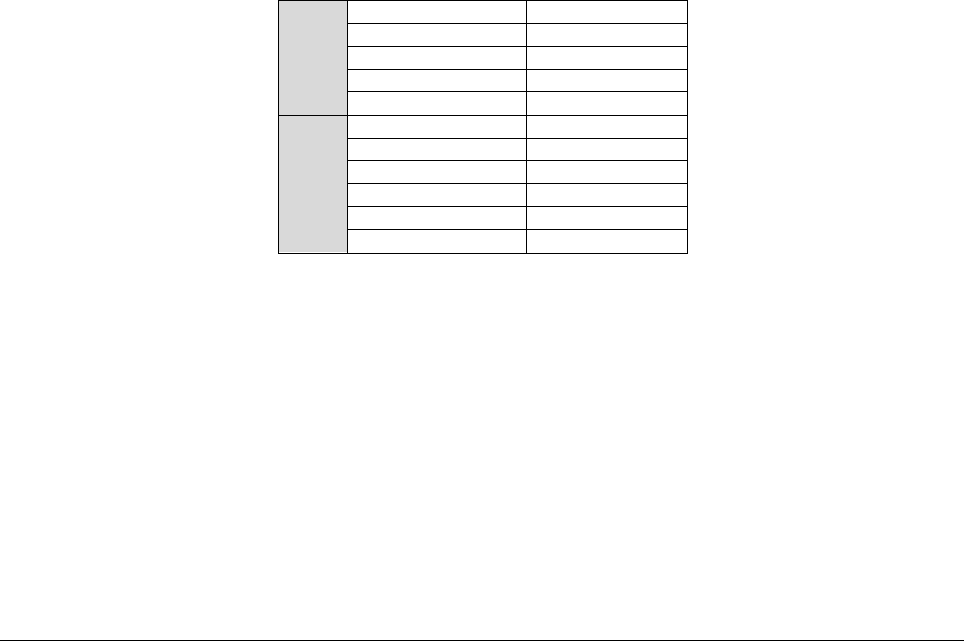
RCF spa
M 18 Digital Mixer User’s Manual
41
show the signal presence on MAIN MIX channels independently for LEFT and RIGHT outputs.
4. External Wi-Fi Antenna connector
M 18 includes an internal antenna and provisions for an external antenna. Attach the provided
external antenna to this connector for optimal performance of the MixRemote app.
[please refer to Statement for Detachable Antenna in Appendix A/1]
5. Power switch
Turn On and Off your M 18 device.
6. Power cable inlet.
Connect here the provided power cord.
7. AUX Output 1-6 Balanced jacks
Connect to these +21dBu balanced output your stage monitors or external effects.
8. LAN connector
It is possible to connect here an external Wi-Fi Access Point for advanced communication
configurations. This port is intended also for future applications.
9. Dual footswitch connector
Connect here a single or dual external footswitch. The footswitch port allows connection of a single or
double stage footswitch to recall effects’ presets or to mute effects’ returns, as well as providing several
other control functions.
10. Internal access point reset pushbutton
Press this button during normal operation (for less than 10 seconds) to restore the default
settings for both the internal Wi-Fi Access Point and the LAN port, as follows:
LAN
IP configuration
Static
IP address
192.168.0.18
Netmask
255.255.255.0
Gateway
0.0.0.0
DNS
0.0.0.0
WiFi
Band
2.4 GHz
Country
NONE
Channel
3
Security
OPEN
SSID
M18-xxxxxx
External Antenna
Enabled
This button is available also for other functions, you can review them more in detail at page 43.
You can modify these settings from the MixRemote app in the SETTINGS > NETWORK page.
11. USB Type A port
Insert here a USB stick to play high quality audio files. .WAV, .AIFF and MP3 file allowed for
reproduction.
12. MIDI connectors
Connect here your MIDI controller. See the dedicated page on MixRemote (SETTINGS > MIDI) to
view the assigned MIDI channels for specific functions.
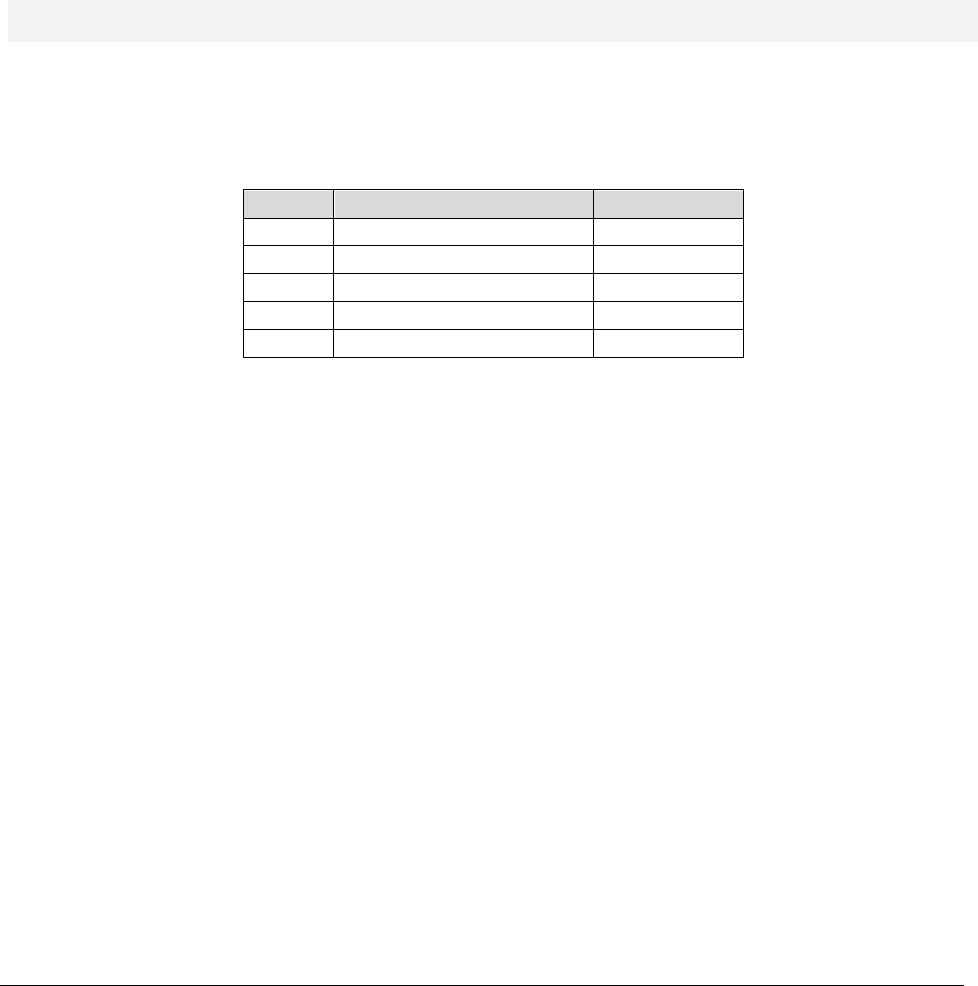
RCF spa
M 18 Digital Mixer User’s Manual
42
13. Headphones stereo output
Connect your headphones here either for PFL, Personal Monitoring or the Main Mix listening.
14. LINE Input 11-18
Connect here your line level sources like keyboard, external audio device or other small analog
consoles used for submix. These input are unbalanced, and their operating levels can be set to
+4dBu or -10dBV.
15. LINE Input 9-10 with switchable HiZ input
Connect to these unbalanced inputs your line-level sources, at +4 dBu or -10 dBV, or high-
impedance passive instruments, like electric guitars, electric basses or piezo pickups. You can
individually enable the Hi-Z option, that offers a 1 Mohm input impedance when activated.
Startup sequence and recovery from an error condition
The M series Digital Mixer features an advanced booting system that ensures the unit correctly powers up
in any condition. The white front LED gives indications about the startup process, which is divided into
several stages.
STAGE
LED
1
startup
Single flash
2
(bootloader)
Fast blinking
3
OS starts
Steady ON
4
M18 executable starts
Slow blinking
5
Completed, ready for use
Steady ON
It can happen that the internal files of the mixer are corrupted, typically when a firmware update
procedure is halted by mistake, by powering down the unit during the process or immediately after.
If the bootloader detects a corrupted file within it internal memory, then it forces the M18 to start in
RECOVERY MODE. This is a special mode in which a clean image is loaded and allows for proper upgrading
to the latest firmware, if needed.
The RECOVERY MODE is indicated in the Firmware version field, in both MixRemote (SETTINGS > SYSTEM),
and in MixUpdate apps. After a mixer starts in RECOVERY MODE, please check if later firmware updates are
available on RCF web site to ensure that you can take advantage of all functionalities.
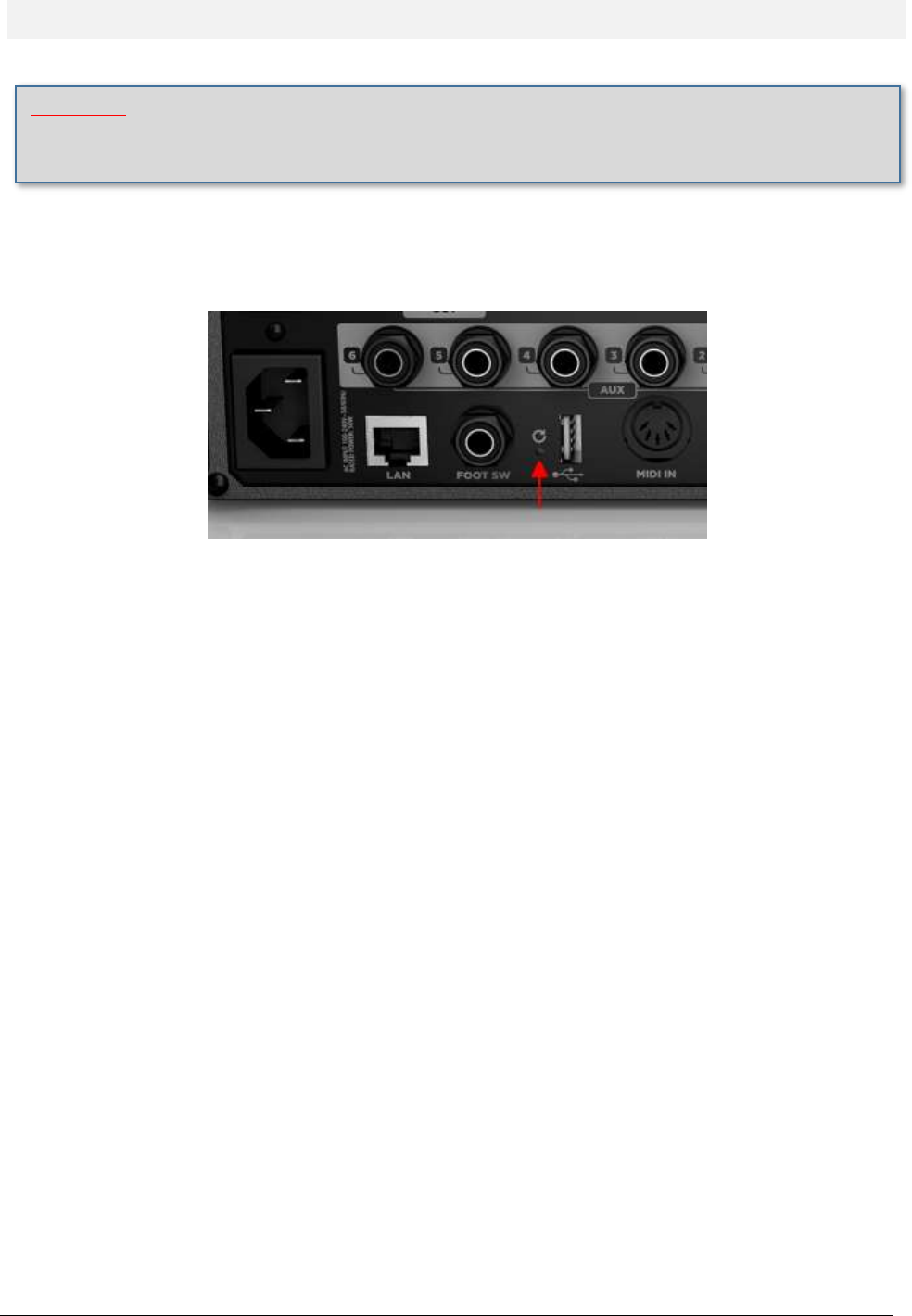
RCF spa
M 18 Digital Mixer User’s Manual
43
Restoring the unit with firmware ver. 182
If your unit is not reachable by the MixRemote app, you have some options to force the unit into an
operating condition again. These option require that the reset button, on the rear panel, near the USB port,
is pressed:
1) The unit is working, but you forgot WiFi and/or LAN password and settings
When the unit is ON and working, press the reset button for no more than 10 seconds, and for at
least 3 seconds. The front LED will blink rapidly; when you release the button, the default settings
will be overwritten and the unit will reboot automatically. When the startup procedure is
completed, you can access the unit with the default parameters.
Please notice that all previously saved data (shows, snapshots, patches) will be maintained.
2) The unit is working, and you want to revert the mixer to default global configuration
When the unit is ON and working, press the reset button for more than 10 seconds. The front LED
will blink very rapidly; when you release the button, the default global configuration parameters
will be copied and the unit will reboot automatically. When the startup procedure is completed,
you can access the unit with the default global configuration parameters.
Please notice that all previously saved data (shows, snapshots, patches) will be maintained.
3) If the unit is not reachable under any condition, and there is no sound
With the unit turned off, press the reset button, then turn power ON, and maintain the button
pressed for at least 8 seconds. The mixer will then start a complete restore that will last about two
minutes, reverting to factory firmware and settings.
After about two minutes, when the front LED starts blinking slowly, you must turn power off. At
the next power-on, the unit will startup in default conditions. Please notice that if you have saved
global settings previously (country code, password, etc…) you will need to set these parameters
again.
Please notice that the first restart after this recovery operation will take much longer than usual,
i.e., about two minutes to complete its reinstall, and therefore the WiFi AP will be visible after a
longer time interval.
Firmware 182
Please notice that this section details behavior for firmware versions 182 ONLY. Go the next Chapter for firmware 203.
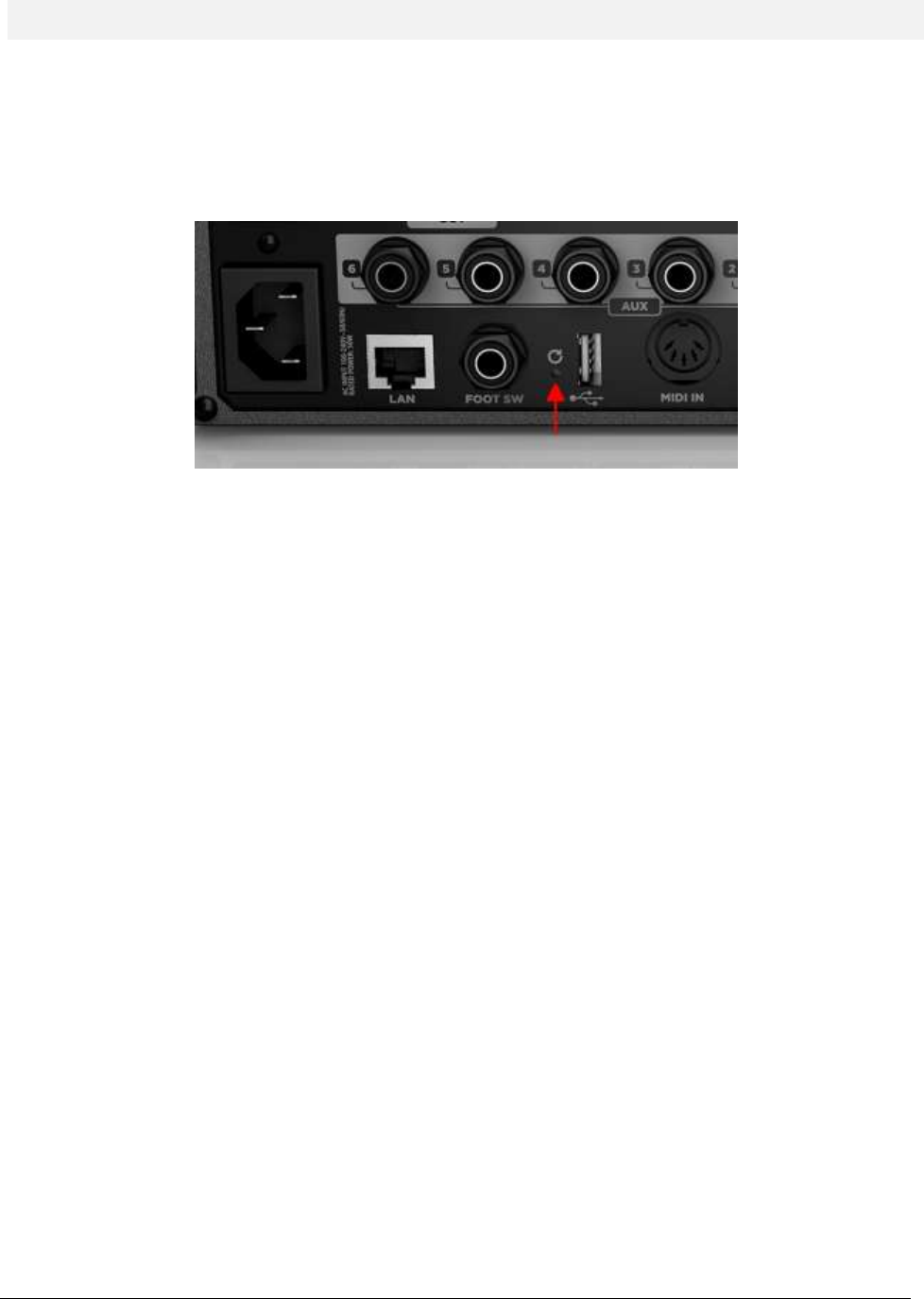
RCF spa
M 18 Digital Mixer User’s Manual
44
Restoring the unit with firmware ver. 203
On firmware ver. 203, recovery options have been modified as follows.
If your unit is not reachable by the MixRemote app, you have some options to force the unit into an
operating condition again. These option require that the reset button, on the rear panel, near the USB port,
is pressed:
1) The unit is working, but you suspect that WiFi is not behaving as intended.
When the unit is ON and working, press the reset button for no more than 10 seconds, and for at
least 3 seconds. The front LED will blink rapidly; when you release the button, the WiFi Access point
will be restarted, without rebooting the mixer. Please notice that all previously saved data (shows,
snapshots, patches) will be maintained. From the moment the button is released, about 10 seconds
are required to complete the operation.
2) The unit is working, but you forgot WiFi and/or LAN password and settings
When the unit is ON and working, press the reset button for more than 10 seconds. The front LED
will blink rapidly first, then more rapidly; when you release the button, all configuration parameters
of both WiFi Access Point and LAN port are restored to their default values. The WiFi Access Point
will be restarted, without rebooting the mixer.
Please notice that all previously saved data (shows, snapshots, patches) will be maintained.
From the moment the button is released, about 15 seconds are required to complete the
operation.
4) If the unit is not reachable under any condition, and there is no sound
With the unit turned off, press the reset button, then turn power ON, and maintain the button
pressed for at least 8 seconds. The mixer will then start a complete restore that will last about two
minutes, reverting to factory firmware and settings.
After about two minutes, when the front LED starts blinking slowly, you must turn power off. At
the next power-on, the unit will startup in default conditions. Please notice that if you have saved
global settings previously (country code, password, etc…) you will need to set these parameters
again.
Please notice that the first restart after this recovery operation will take much longer than usual,
i.e., about two minutes to complete its reinstall, and therefore the WiFi AP will be visible after a
longer time interval.

RCF spa
M 18 Digital Mixer User’s Manual
45
M 18 Usage
Secrets of mixing on a digital console
The most important thing to keep in mind using a digital console is the Gain Structure.
Mixing is essentially an art, but the Gain Structure is based on mathematical reasoning and represents the
most important thing to learn to manage before taking off with your mixing creativity!
The correct input level, starting from the Analog Gain, with all the further processing inside the mixer, must
be set by checking continuously the master output to avoid overload because digital consoles work
differently from analog ones.
The 0dBFS level (where FS stands for full-scale) refers to sound level in the digital domain, inside the mixer
itself, and corresponds to the maximum signal that can be applied to an Analog-to-Digital conversion stage:
above this level, the conversion process clips the signal and sever distortion appears.
A fair starting point to set the proper Analog Input Gain is to set the individual sounds levels in the range of
-18 .. -14 dBFS.
One of the most powerful but often underestimated tools is the High-Pass Filter (HPF); in the M Series
mixer the HPF is located in the PRE-DYN page. The proper HPF setting on the individual channels is
important to optimize the processing of the audio sources, and furthermore it also helps to cut away some
subsonic inaudible components of the sounds that often cause an efficiency loss of the power amplification
system.
It’s highly suggested to always use the HPF on all the input channels, especially on mic inputs during live
gigs where the HPF is a great tool to reduce the noises captured by the microphones by transmission (as an
example, foot stomping or noises captured touching the mic stands).
How to set the HPF?
Generally, except for instruments with lot of low end like a Kick Drum or Bass, 50Hz is a good frequency to
start with. The HPF is not only the first tool to optimize the signal chain but it must be considered like an
EQ band, and for this reason it should be used to easily optimize the frequency range aimed to achieve a
more focused overall balance between the different sounds
A classic example of HPF usage in frequency range optimization is on the Toms. When played alone, Toms
have huge energy in the low end; in a mix of medium density of instruments the perception of those low
frequencies is masked by other instruments, so to make the Tom sound more focused we could boost some
mid-hi frequency or cut some low end with the HPF – 100Hz and above - and increase the level.
This approach allows to keep the same RMS audio level (matching the perceived audio level), but with an
optimized frequency range.
The approach described for Toms above should be reiterated for all instruments.
Gain Input Level, HPF and Gain Structure are the most important elements to keep in mind for the usage of
a digital console.
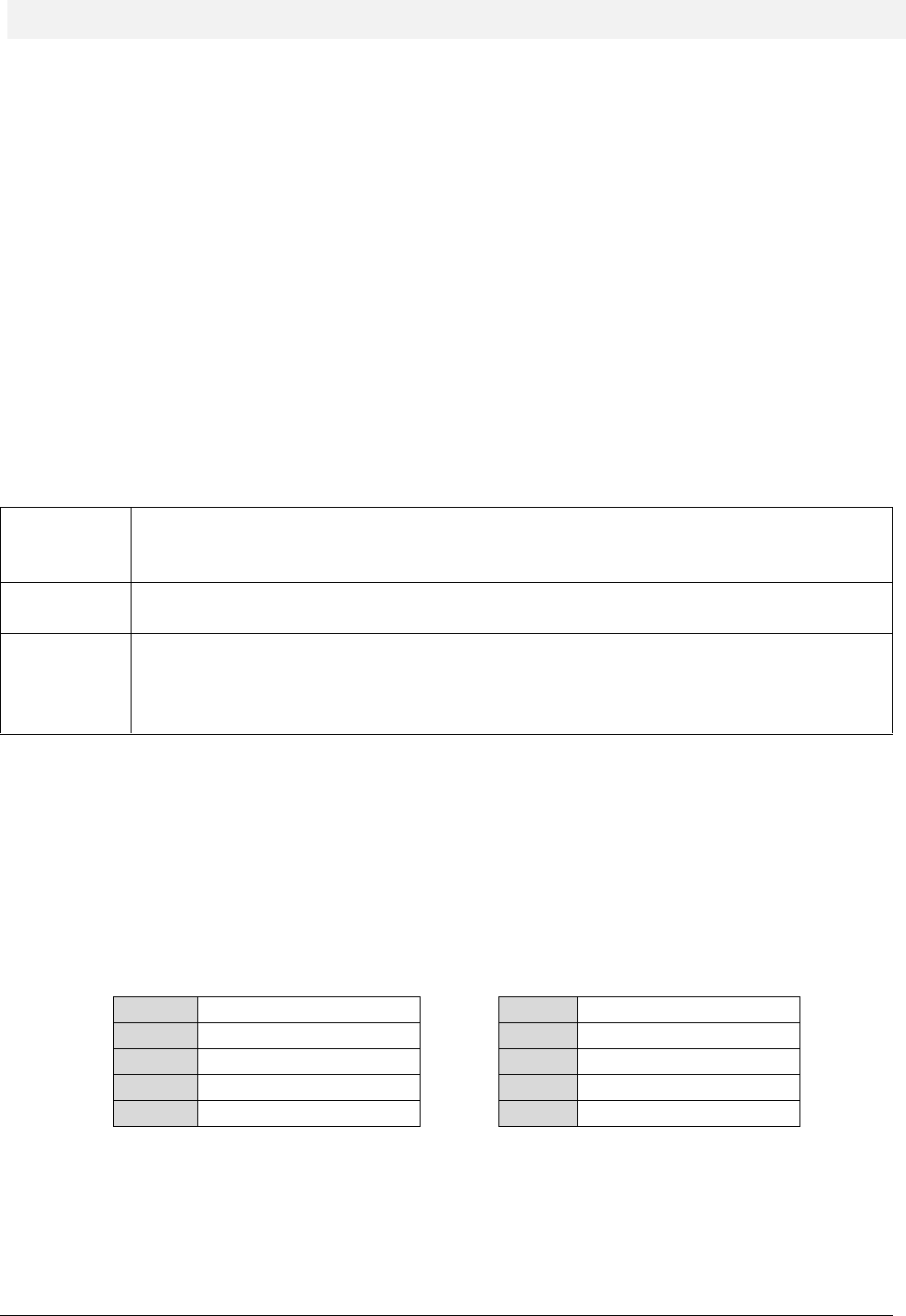
RCF spa
M 18 Digital Mixer User’s Manual
46
Sound Shaping with M 18
A full array of processors is available on each M Series Mixer’s channel: HPF, Gate, Compressor, Insert,
Equalizer, Three Fx Sends.
They allow to tailor every kind of sound not only for correction but also with a creative approach.
The Gate with its full set of controls allows to be optimized for every kind of incoming signal, even the most
complex and difficult to tame.
The Compressor can be at the same time super transparent but also very aggressive.
The Equalizer is the essential mixing tool, and is available in three variations: Standard, Vintage, Smooth.
The Vintage and Smooth types have been derived from models of classic analog equalizer banks that have
been used in countless recordings and mixing sessions.
For each type, an EASY mode is available, showing the essential parameters only, and is perfect for
superfast usage
Which are the features of each type?
Standard
This is the most transparent type of Equalizer in the M series Digital Mixer.
Four bands ideal for every kind of correction but also perfect to tailor the sounds without
colorations.
Vintage
This Equalizer is modeled after the Classic British EQs.
It’s the first choice when you are looking for an Equalizer with character and impact.
Smooth
This is a really unique Equalizer.
The two Mid bands have been designed to shape gently the frequencies and the two
Shelving sections have been developed to cut gently some frequencies in conjunction to
their boost.
These features allow to shape sounds carefully, placing them into the mix with unparalleled smoothness.
The large number of presets are ideal to learn more about the power of Equalizer types and they represent
an invaluable starting point to create your own unique sound.
To simplify navigation, equalizer presets have been grouped in classes depending on the instrument being
targeted; groups are identified by the prefix assigned to each preset, as follows:
[DRM]
Drums
[KEY]
Keyboards
[PRC]
Percussion
[VOX]
Voice
[BSS]
Bass
[ORC]
Orchestral
[EGT]
Electric Guitar
[MIS]
Miscellaneous
[AGT]
Acoustic Guitar
Let’s take a look to some real examples and usage tips.
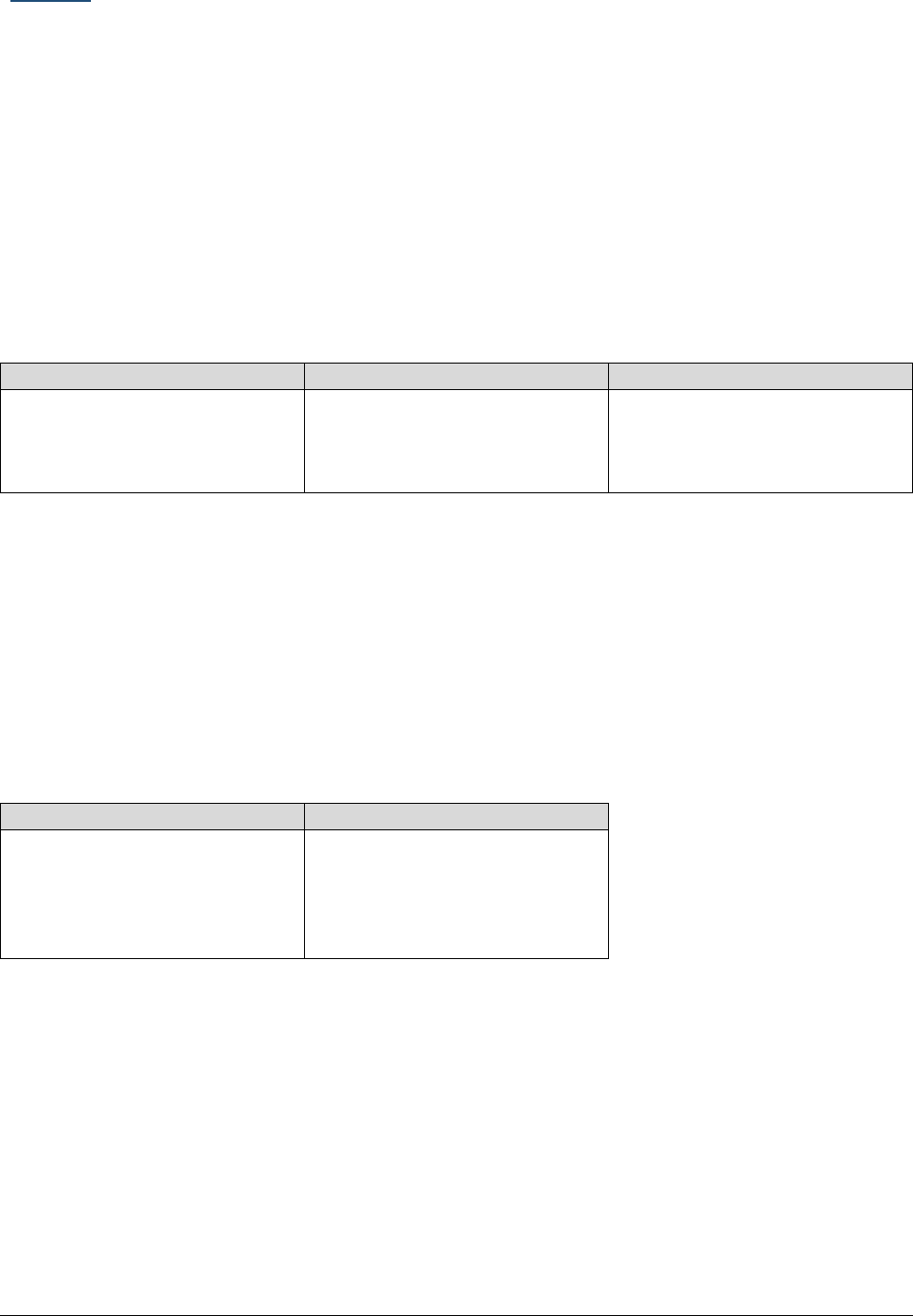
RCF spa
M 18 Digital Mixer User’s Manual
47
DRUMS
Gate and Compressor are processors heavily used on drums and percussions.
Among the various Equalizer options, the Vintage Type is for sure the most recommended if we are looking
for a sound shape with character. The Standard Equalizer Type is still the first choice for surgical
corrections and for transparent shaping. The Smooth Equalizer Type is for sure the best choice for soft
sounds.
Here are some examples and tips for each part of the drum kit.
KICK
EQ
COMP
GATE
HPF: OFF > 50Hz
Body: 50Hz>150Hz
Resonance (Cut) : 180>400Hz
Attack: 4>8 KHz
Attack: Med-Slow
Release: Med-Fast
Ratio: 4:1>8:1
Attack: 1msec
Hold: 80msec
Release: 50msec
Range: 15 > 50 dB
TIP: The Kick is an instrument that, due to its low end, takes a big part of the RMS level, so it’s very
important to define the frequency range where it will stay in relation to the bass guitar.
Generally a good starting point for optimizing the low end range is to avoid boosting the same frequencies
on both the instruments, trying to create some relations between kick and bass, where the kick wraps the
bass and the opposite avoiding – when possible – to overlap frequency ranges.
SNARE
EQ
COMP
HPF: 50 > 250 Hz
Body: 150Hz>250Hz
Resonance (Cut) : 200>400Hz
Attack: 5>8 KHz
Air: 10>12 KHz
Attack: Med-Slow
Release: Med-Fast
Ratio: 4:1>8:1
TIP: Usually the Snare Drum is miked with two microphones (top and bottom). Sometimes it’s necessary to
invert the phase on one of them, especially is the microphone are positioned almost at 180°.
How can you quickly determine if phase shift is necessary?
Take a listen to the two channels in solo and shift the phase of one (generally the bottom); if you hear the
low end increasing, then it would be better to keep the phase inverted, because some phase cancellation is
occurring in absence of phase shift.
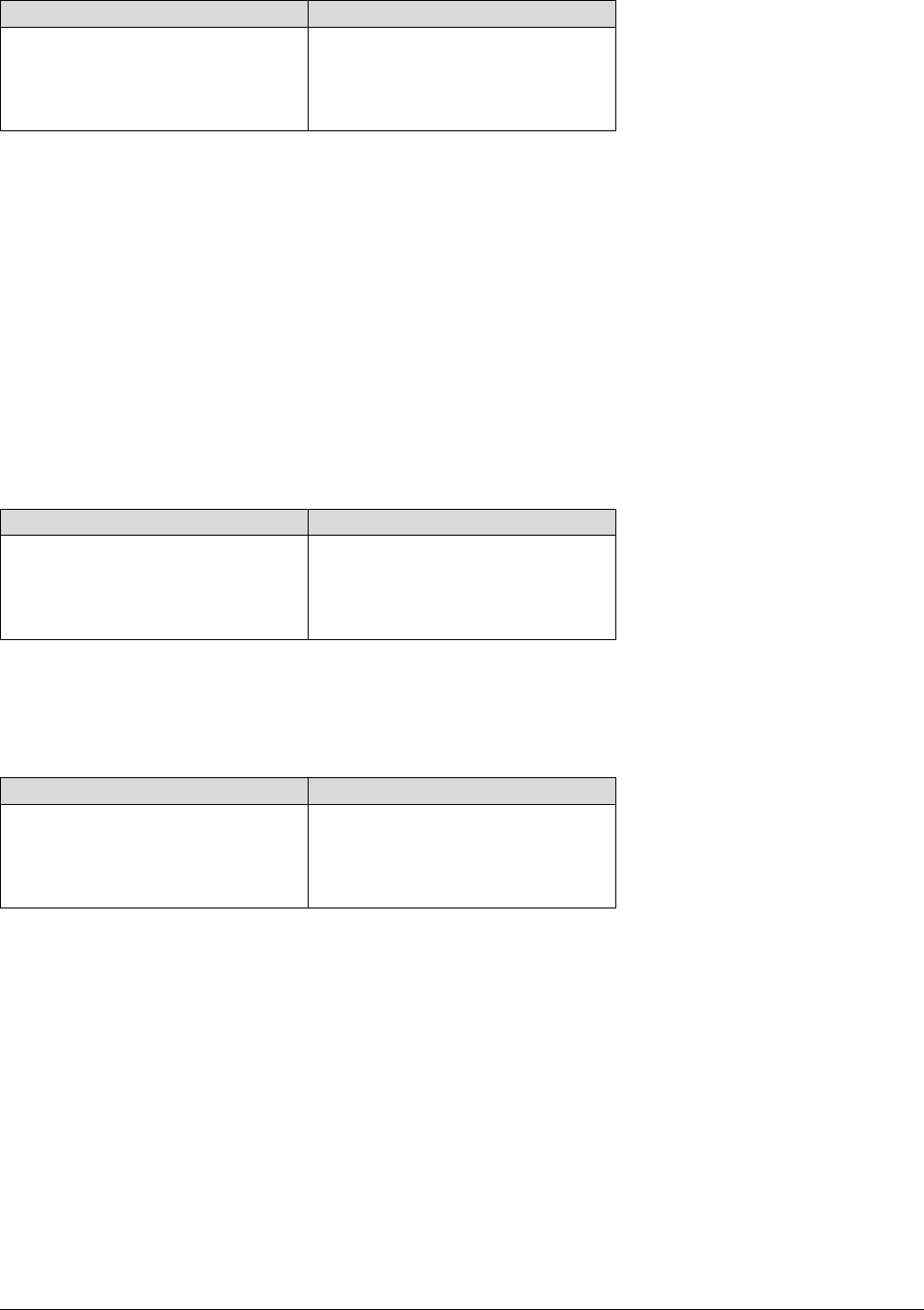
RCF spa
M 18 Digital Mixer User’s Manual
48
TOM
EQ
COMP
HPF: 50 > 200 Hz
Body: 150Hz>250Hz
Resonance (Cut) : 250>600Hz
Attack: 4>8 KHz
Attack: Med-Slow
Release: Med-Fast
Ratio: 4:1>8:1
TIP:
1) Usually, Tom microphones capture cymbals so it’s advisable to avoid extreme boost in the high-end
frequency range; the Smooth Eq Shelving is perfect to cut some hi frequencies and gentle boost
some mid-hi frequencies easily with a single pot!
2) The first Tom (typically positioned above the snare) usually captures a big part of the snare too;
It is better to place the microphone “looking” in direction of the floor tom but not the snare; this is a simple
way to dramatically improve the efficiency of the Gate too.
HI HAT
EQ
COMP
HPF: 50 > 200 Hz
Body: 150Hz>250Hz
Resonance (Cut) : 250>600Hz
Attack: 4>8 KHz
No Comp
OVERHEAD
EQ
COMP
HPF: 100 Hz > 1 KHz
Body: 150Hz>250Hz
Resonance (Cut) : 800Hz >2 KHz
Air: 10>12 KHz
Attack: Med-Slow
Release: Med-Fast
Ratio: 4:1>8:1
TIP: The Overhead can be used in different ways. The classic approach is to capture only the cymbals; in this
case, it makes sense to apply an HPF (above 300Hz) to reduce the presence of other instruments.
Especially in live gigs, it makes sense to use the Overhead also like a “stereo” drum source, using a reduced
amount of HPF and adding a bit of compression and reverb. In this way, the Overhead mics are like the
“Room Mics” generally used in studio recordings that can give to the overall sound a natural spaciousness
that it’s hard to achieve with close mics only.
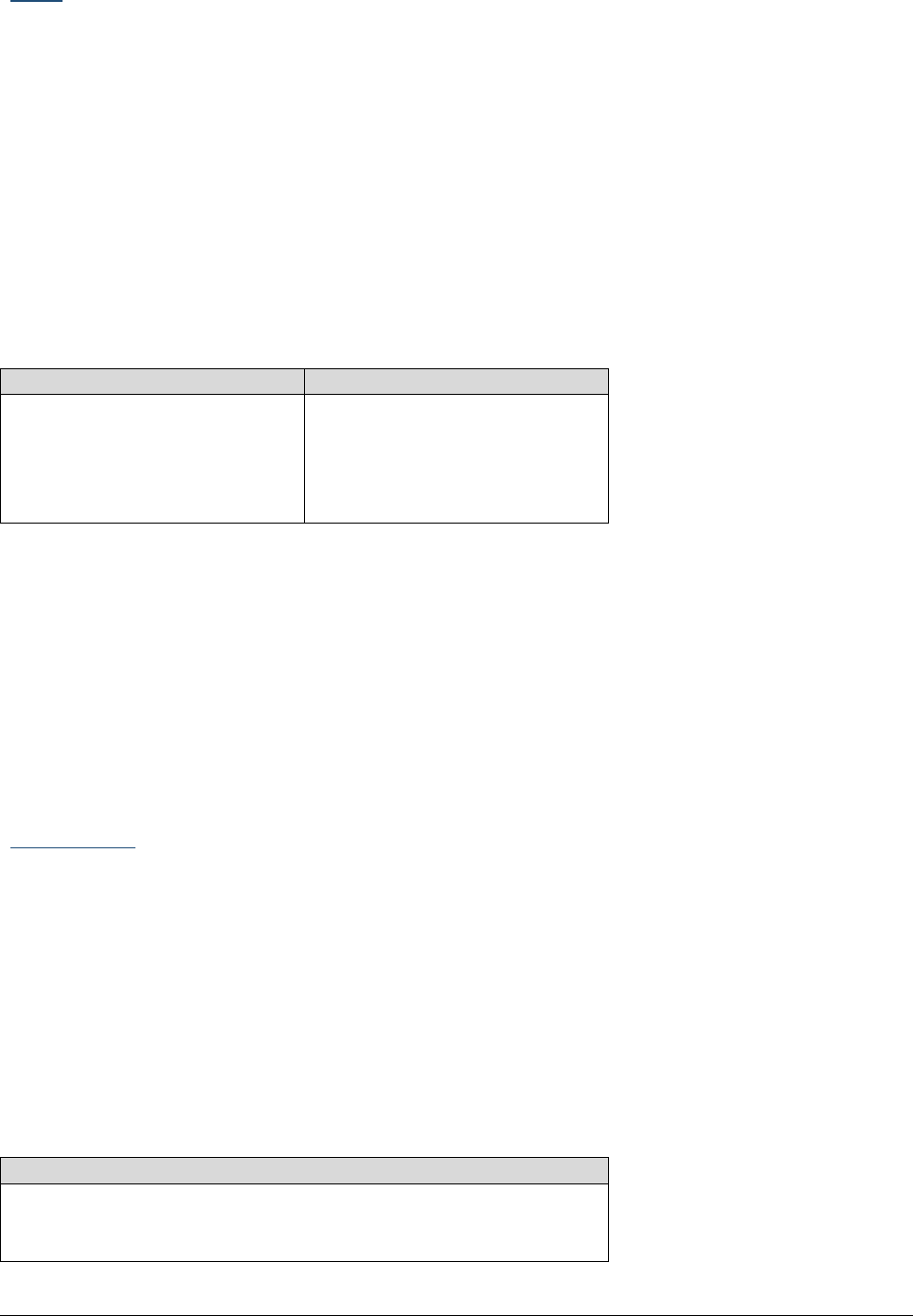
RCF spa
M 18 Digital Mixer User’s Manual
49
BASS
Typical processing of the bass input signal requires both Compressor and Equalizer.
Due the versatility of the M Series Compressor, it can be used on bass for several purposes, from increasing
the average volume – and limiting some pick – to adding some attack and aggressiveness to the overall
sound.
All the EQ types are also usable on bass, with excellent results depending on the sound we are looking for.
As for the Drums, we recommend to use the Vintage EQ if you are looking for a solid and precise sound.
The Standard EQ is as always a good choice for a neutral and surgical approach to the sound. The Smooth
EQ, thanks to its unique curves, is perfect if you are aiming at a super thick sound avoiding tedious
resonance in the mid-low range.
EQ
COMP
HPF: OFF > 40Hz
Presence: 60Hz>100Hz
Body: 100Hz > 150Hz
Resonance: 180Hz >250Hz
Presence: 1KHz>3KHz
Attack: Med-Slow
Release: Med
Ratio: 4:1>8:1
TIP: The Bass’s extra Low frequencies could be critical in the overall sound of the mix. It is strongly
suggested to check the extra low frequencies of the kick drum as well, to avoid overlap of the boost of
some extra low frequencies. Again, the HPF is a great and simple tool to focus the low range.
Example: If you bass sound has a big presence below the 50Hz maybe it could be a good idea to check how
it sounds in the mix cutting the frequencies below 50 Hz on the kick drum.
KEYBOARDS
The Equalizer is generally the most used processor on keyboards. Compressor is sometimes used to
increase the attack (on the piano for example) and rarely to limit the dynamic range.
All the M Series equalizers can be used with great results; each one, with its own character, is able to tailor
the sound in a very pleasant way. The Smooth EQ can be a great choice to gentle sculpt the sounds
increasing the focus and cutting easily at the same time some unwanted frequencies which usually cause
some congestions in the mid-low and mid-hi range. As always, also on keyboards the HPF is the perfect tool
to cut some not unuseful frequencies and immediately clean the mix allowing also to place the keyboard at
an highter level in the mix.
Here are some suggested frequency ranges to be considered when approaching keyboard equalization:
EQ
HPF: OFF > 400Hz
Body: 100Hz > 200Hz
Resonance: 180Hz >500Hz
Presence: 1KHz>3KHz
Attack: 2KHz>8KHz
Definition: 5KHz>12KHz
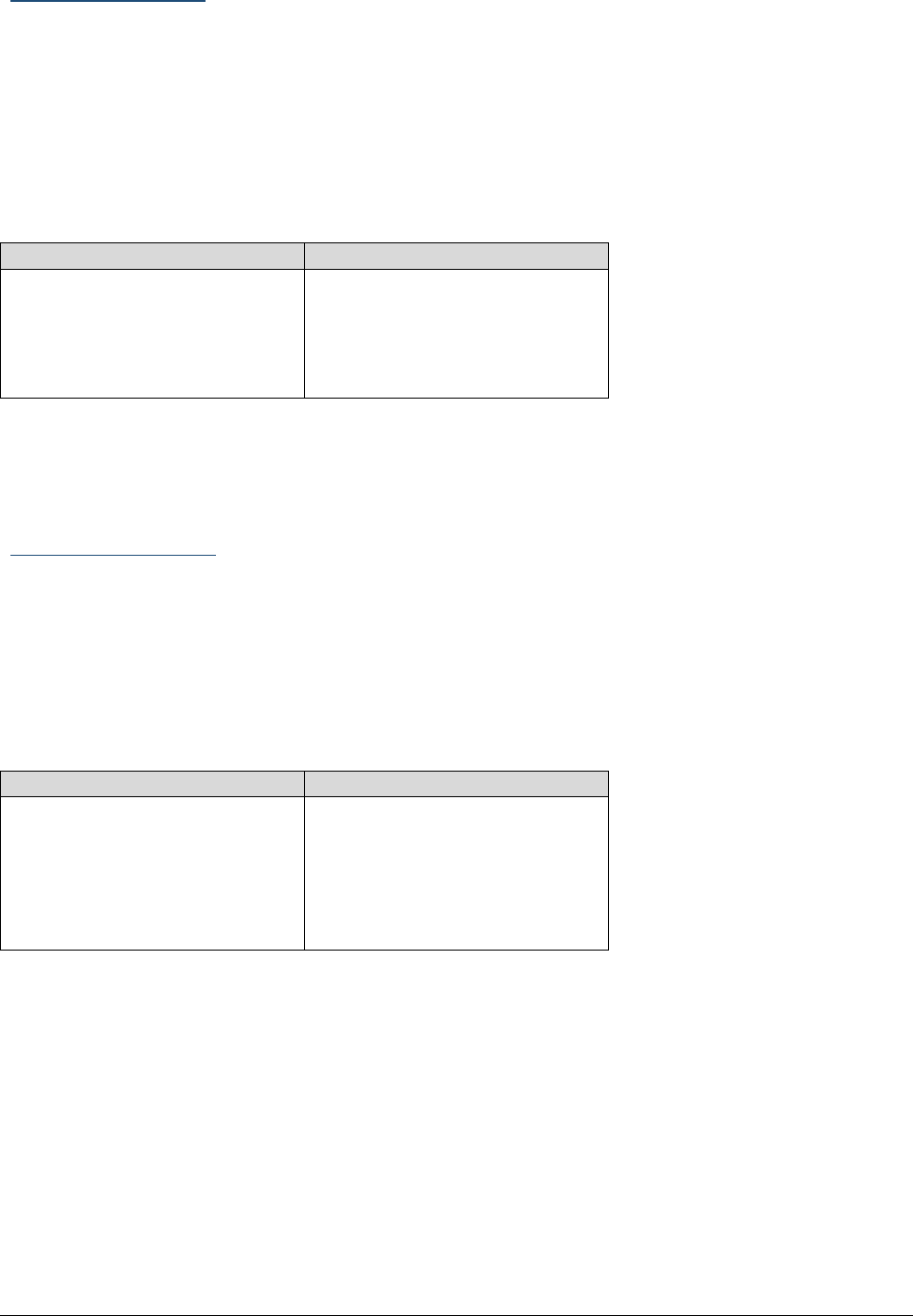
RCF spa
M 18 Digital Mixer User’s Manual
50
ELECTRIC GUITARS
The approach to the Electric guitar processing changes a lot according to the original sound.
The internal M Series guitar processor allows tons of tone possibilities that can be fine tuned also through
EQ and Compressor.
Of course, you can use the mixer miking a real amp and cabinet, and in this case the internal processors
could be used more to fine tune the sound.
EQ
COMP
HPF: OFF > 100Hz
Body: 100Hz>200Hz
Resonance (Cut) : 150>400Hz
Presence : 900Hz > 2 KHz
Attack: 2>5 KHz
Attack: Med-Slow
Release: Med
Ratio: 4:1>8:1
ACOUSTIC GUITARS
Acoustic Guitars are usually amplified during live gigs through a pickup, and only occasionally with mics.
The pickup sounds is often a bit harsh, and it may be necessary to smooth it reducing some extra high
frequencies and adding some warm with EQ and Compressor.
EQ
COMP
HPF: OFF > 120Hz
Body: 100Hz>200Hz
Resonance (Cut) : 150>400Hz
Presence : 900Hz > 2 KHz
Attack: 2>4 KHz
Harshness (Cut) : 8>12 KHz
Attack: Med-Slow
Release: Med-Fast
Ratio: 2:1>6:1
TIP: The Smooth EQ is the perfect EQ type to remove some harshness in the high-end, adding at the same
time some definition to the sound of acoustic guitars in the mid-hi range.
The Smooth EQ is also great to increase the body of the sound removing some resonances using only one
band!
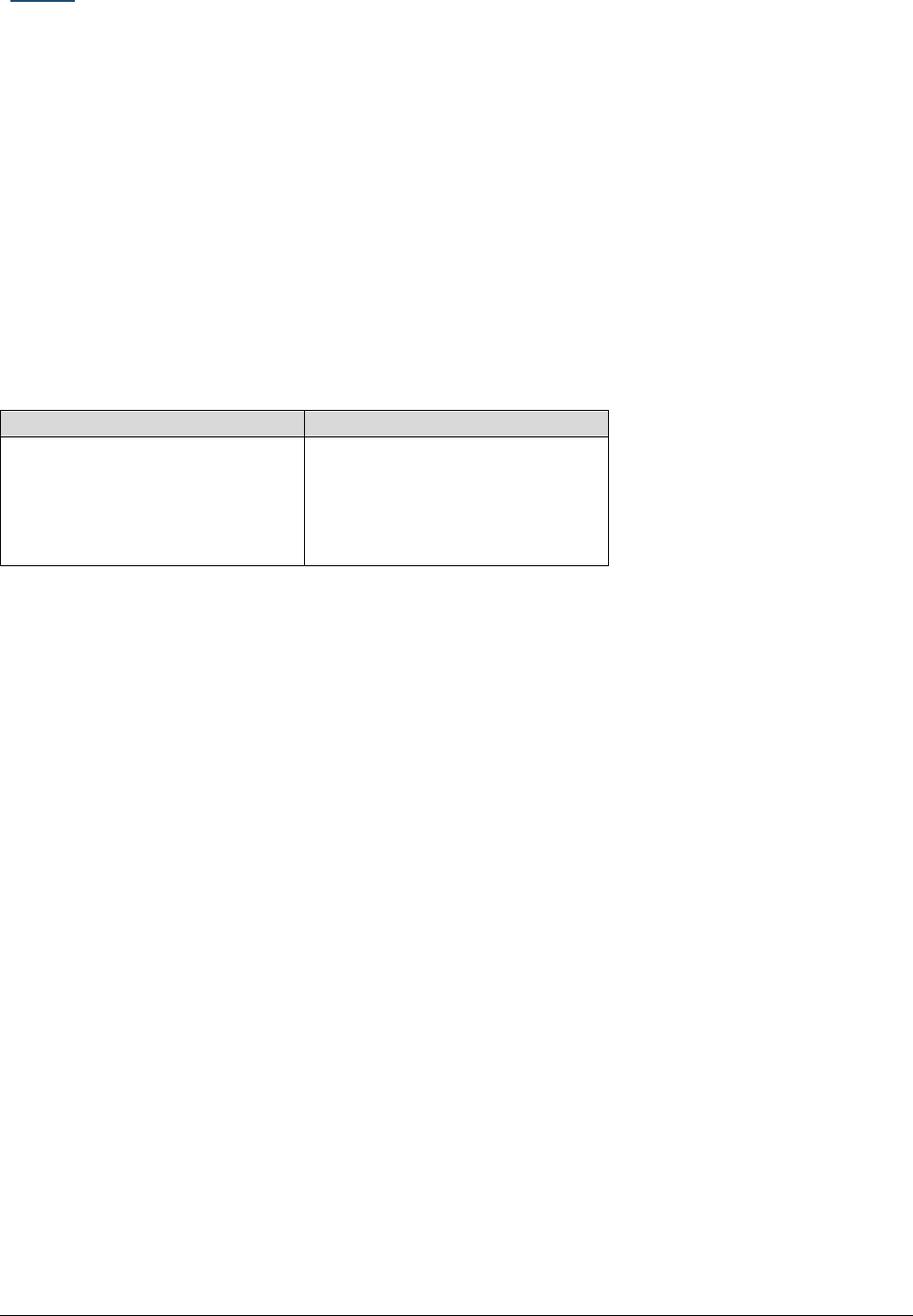
RCF spa
M 18 Digital Mixer User’s Manual
51
VOICE
The Voice is a complex “instrument”, mainly because it can be emitted in several different ways.
The main problems to handle, especially during live gigs, are first the control of the dynamic range and then
the balance of the frequencies according to the dynamic.
The M Series Compressor is absolutely transparent, and on voices it can be used to control the dynamic
range also hardly without the classic pumping side effect.
All the M Series Equalizers can be used successfully to easily tailor the voice tone each one with its own
unique character. If you want to gently boost the voice sound, making it more exciting, the Smooth EQ is
for sure the first choice; if you want an aggressive, in-your-face sound, the Vintage EQ is the recommended
selection and, as always, the Standard EQ is the perfect all-purpose choice.
EQ
COMP
HPF: OFF > 120Hz
Body: 100Hz>200Hz
Resonance (Cut) : 150Hz>300Hz
Presence : 2KHz > 4KHz
Air : 10KHz>16KHz
Attack: Fast-Med
Release: Med
Ratio: 4:1>6:1
TIP: When mixing, voice intelligibility is the main concern. The mid range is where the voice is mostly
located, so be careful to check how other instruments work in that frequency range; usually it is better to
cut some instruments that over-eq or increase the voice level.

RCF spa
M 18 Digital Mixer User’s Manual
52
A1 – Declaration
FCC / IC CERTIFICATION
M18 digital mixer is approved for FCC rules. The below FCC code allows to find related information:
FCC ID: 2AHDK-M18DIGI
IC: 21113-M18DIGI
This device complies with part 15 of the FCC rules. Operation is subject to the following two conditions:
1) this device may not cause harmful interference, and
2) this device must accept any interference received, including interference that may cause undesired
operation
INFORMATION FOR USERS
NOTE: The manufacturer is not responsible for any radio or TV interference caused by unauthorized
modifications to this equipment. Such modifications could void the user's authority to operate the
equipment.
NOTE: This equipment has been tested and found to comply with the limits for a Class B digital device,
pursuant to Part 15 of the FCC Rules. These limits are designed to provide reasonable protection against
harmful interference in a residential installation. This equipment generates, uses and can radiate radio
frequency energy and, if not installed and used in accordance with the instructions may cause harmful
interference to radio communications. However, there is no guarantee that interference will not occur in a
particular installation. If this equipment does cause harmful interference to radio or television reception,
which can be determined by turning the equipment off and on, the user is encourage to try to correct the
interference by one or more of the following measures:
• Reorient or relocate the receiving antenna
• Increase the separation between the equipment and receiver
• Connect the equipment into an outlet on a circuit different from that to which the receiver is
connected
• Consult the dealer or an experienced radio/TV technician for help
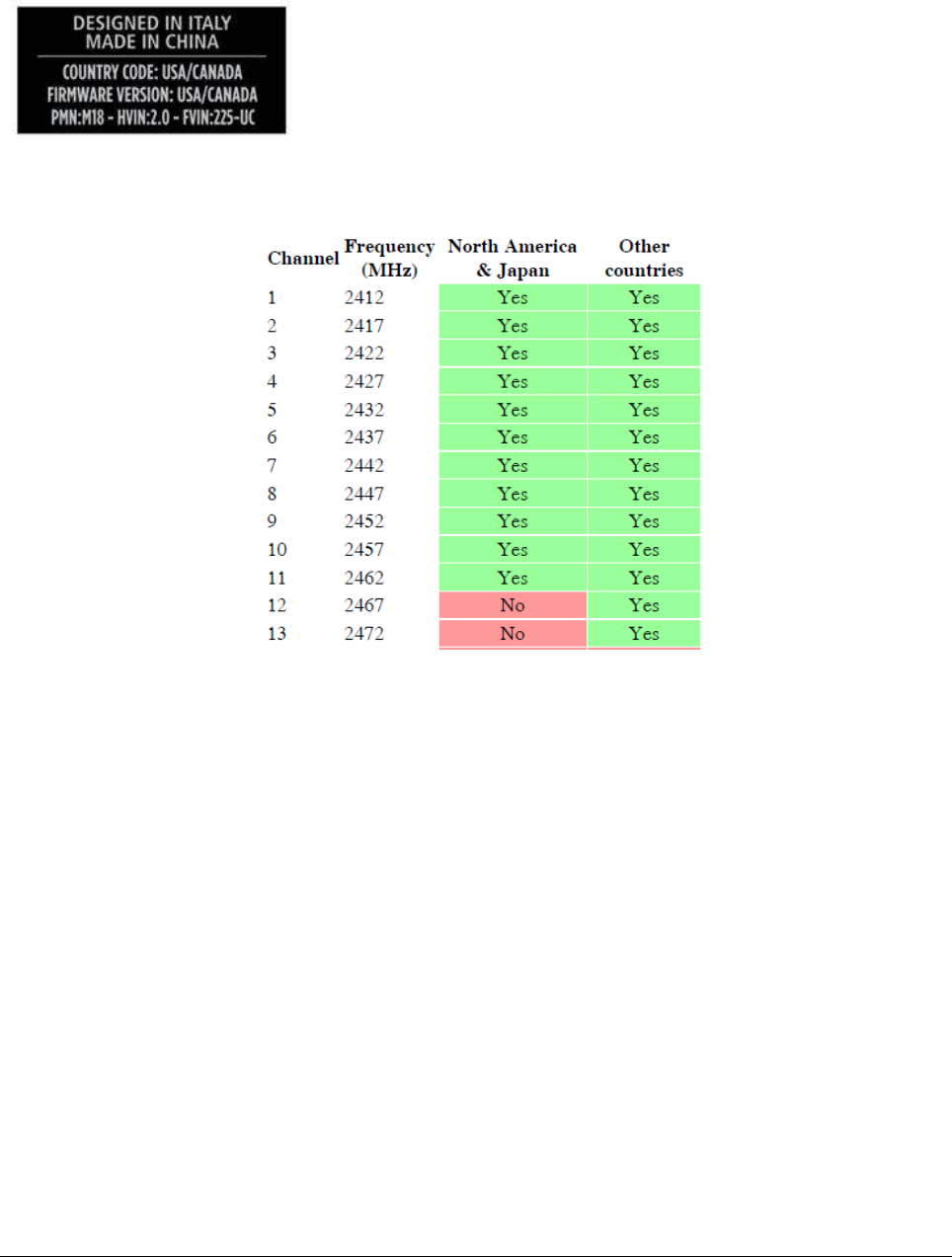
RCF spa
M 18 Digital Mixer User’s Manual
53
RADIO CHANNEL SELECTION
Two different options are available, depending on the hardware unit version: for USA/Canada (limited to
channels 1-11), or EU/other countries (channels 1-13 are allowed); refer to Table 1 for more details. The
unit version is clearly indicated in the label placed on the bottom of the unit:
If this label is not present, the unit is configured to access all 13 channels
as shown in Table 1, and therefore, according to FCC/IC rules, it cannot
be operated in USA or Canada.
Table 1 – Allowed Frequencies on M18
WARNING
To avoid interference to local communications, it is strongly recommended to verify allowed frequencies in
the country of use before deploying the product.

RCF spa
M 18 Digital Mixer User’s Manual
54
ISED compliance statements
This device complies with Industry Canada licence-exempt RSS standard(s) RSS-247 and RSS-102. Operation is subject
to the following two conditions: (1) this device may not cause interference, and (2) this device must accept any
interference, including interference that may cause undesired operation of the device.
Le présent appareil est conforme aux CNR d'Industrie Canada applicables aux appareils radio exempts de licence.
L'exploitation est autorisée aux deux conditions suivantes : (1) l'appareil ne doit pas produire de brouillage, et (2)
l'utilisateur de l'appareil doit accepter tout brouillage radioélectrique subi, même si le brouillage est susceptible d'en
compromettre le fonctionnement.
(compliance statement and unlicensed device usage conditions)
=================================
CAN ICES-3(B)/NMB-3(B)
Statement for detachable antenna
Under Industry Canada regulations, this radio transmitter may only operate using an antenna of a type and maximum
(or lesser) gain approved for the transmitter by Industry Canada.
To reduce potential radio interference to other users, the antenna type and its gain should be so chosen that the
equivalent isotropically radiated power (e.i.r.p.) is not more than that necessary for successful communication.
This radio transmitter (identify the devi ce by certification number, or model number if Category II) has been approved
by Industry Canada to operate with the antenna types listed below with the maximum permissible gain and required
antenna impedance for each antenna type indicated. Antenna types not included in this list, having a gain greater than
the maximum gain indicated for that type, are strictly prohibited for use with this device.
Conformément à la réglementation d'Industrie Canada, le présent émetteur radio peut fonctionner avec une antenne
d'un type et d'un gain maximal (ou inférieur) approuvé pour l'émetteur par Industrie Canada.
Dans le but de réduire les risques de brouillage radioélectrique à l'intention des autres utilisateurs, il faut choisir le type
d'antenne et son gain de sorte que la puissance isotrope rayonnée équivalente (p.i.r.e.) ne dépasse pas l'intensité
nécessaire à l'établissement d'une communication satisfaisante.
Le présent émetteur radio (identify the device by certification number, or model number if Category II) a été approuvé
par Industrie Canada pour fonctionner avec les types d'antenne énumérés ci-dessous et ayant un gain admissible
maximal et l'impédance requise pour chaque type d'antenne. Les types d'antenne non inclus dans cette liste, ou dont le
gain est supérieur au gain maximal indiqué, sont strictement interdits pour l'exploitation de l'émetteur.
RF exposure limit statement
This equipment complies with radio frequency exposure limits set forth by Industry Canada for an uncontrolled
environment. This equipment should be installed and operated with minimum distance 20 cm between the device and
the user or bystanders.
Cet équipement est conforme aux limites d'exposition aux radiofréquences définies par Industrie Canada pour un
environnement non contrôlé. Cet équipement doit être installé et utilisé avec un minimum de 20 cm de distance entre
le dispositif et l'utilisateur ou des tiers.
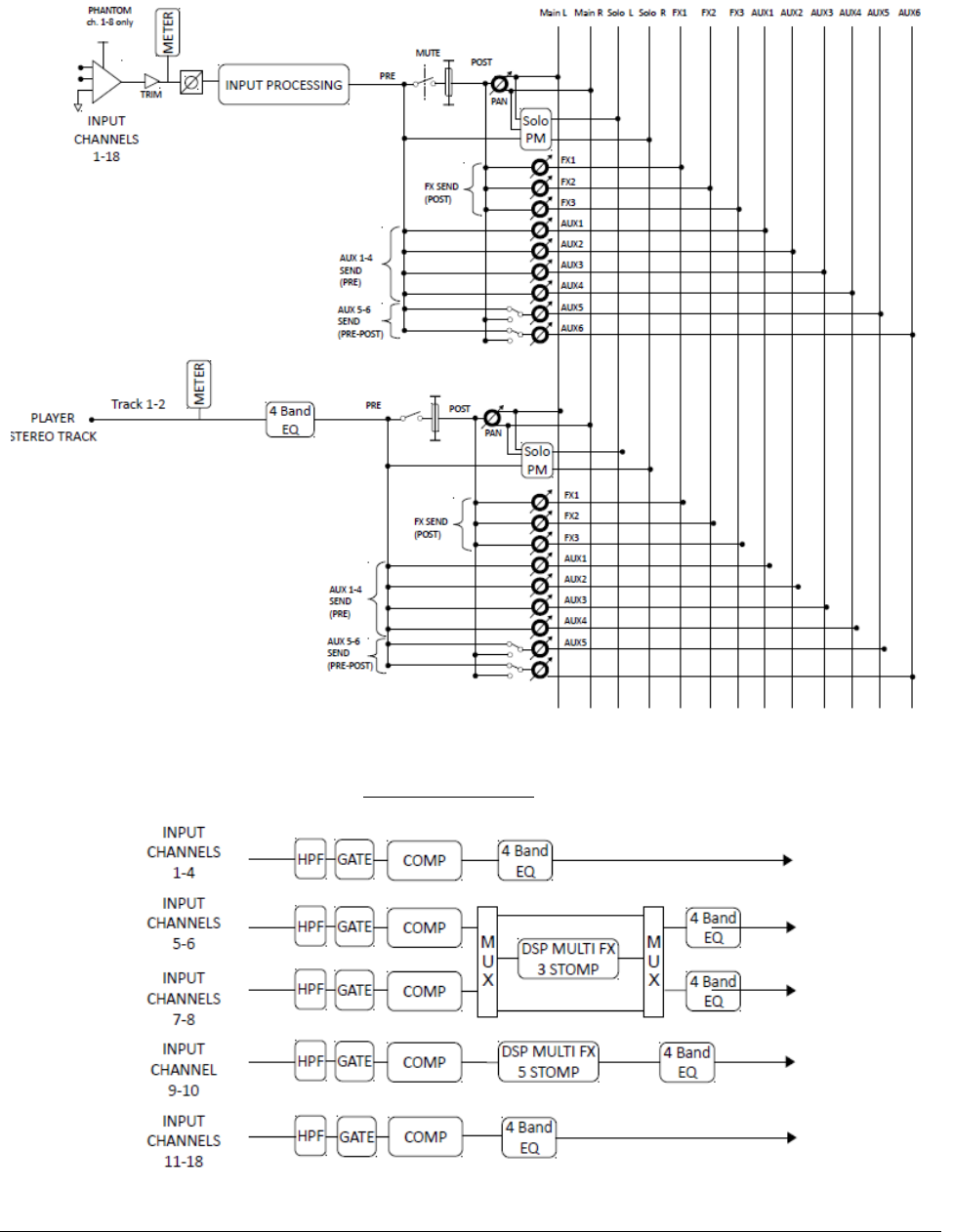
RCF spa
M 18 Digital Mixer User’s Manual
55
A2 - Block Diagram
INPUT PROCESSING DETAIL
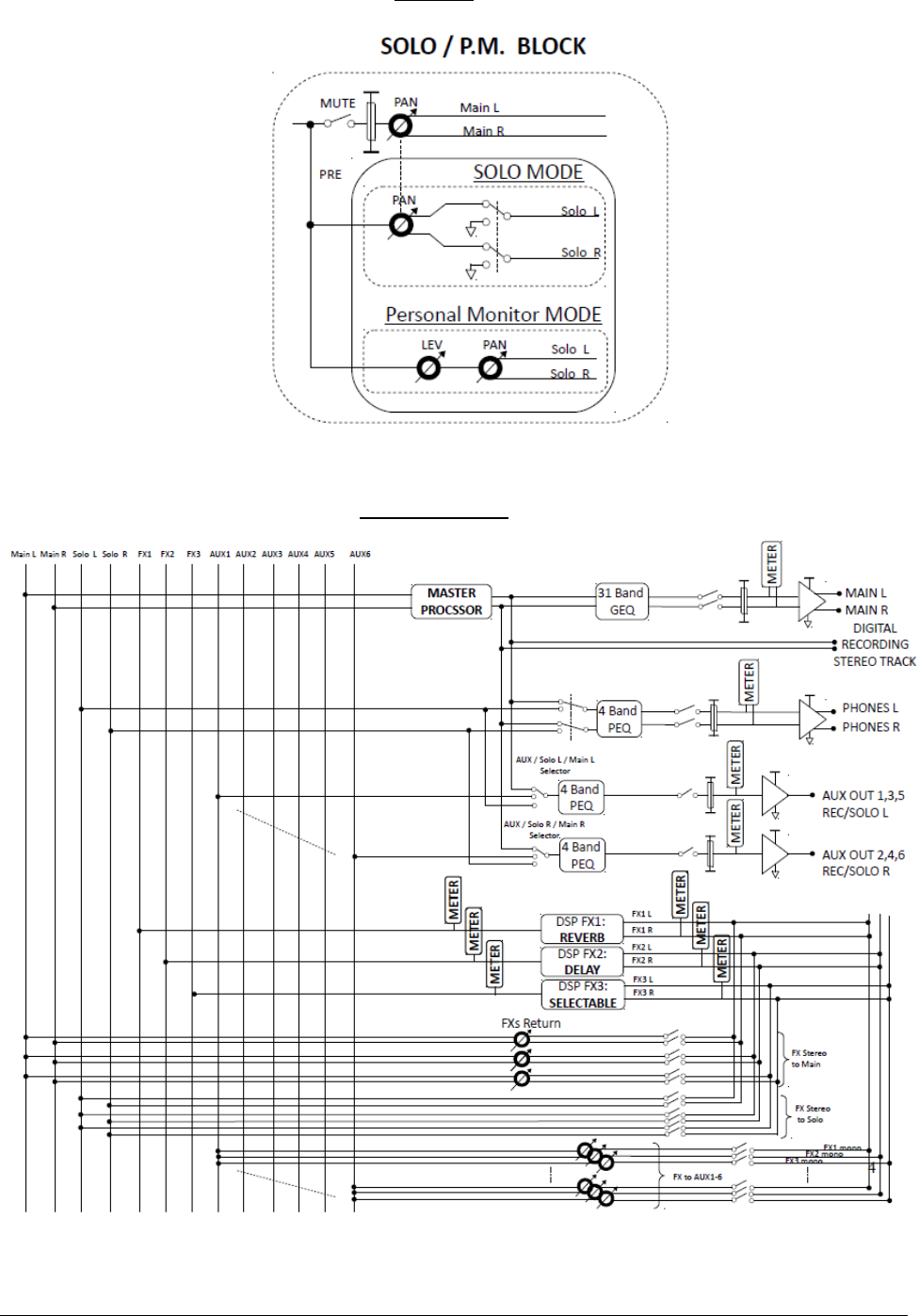
RCF spa
M 18 Digital Mixer User’s Manual
56
SOLO PM details
OUTPUT SECTION details
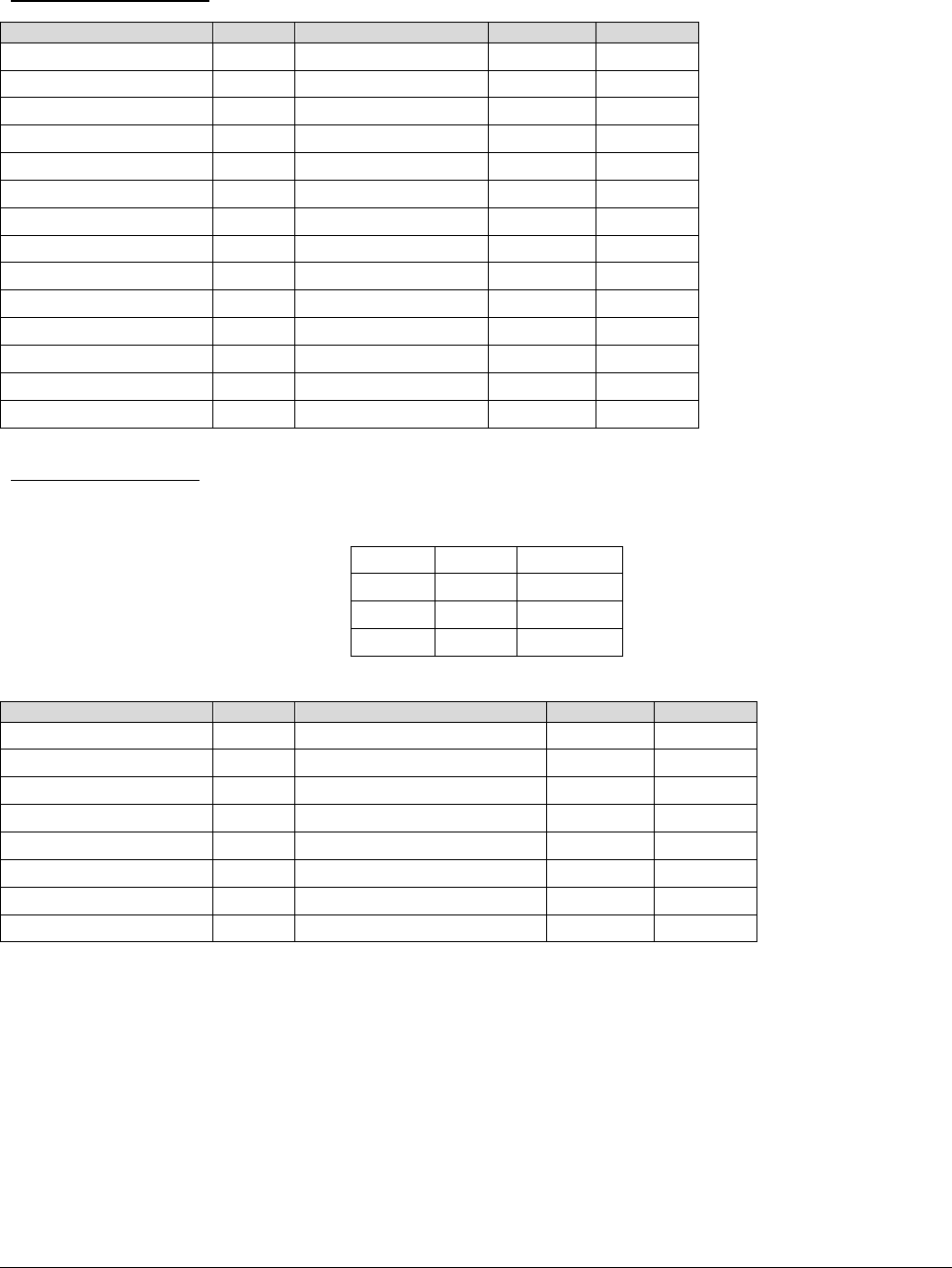
RCF spa
M 18 Digital Mixer User’s Manual
57
A3 – MIDI implementation chart
ON GLOBAL CHANNEL (default = ch 10)
MIDI message
Number
Assigned to
Transmitted
Recognized
Control Change
1
MAIN OUT LEVEL
YES
YES
Control Change
2
PHONES LEVEL
YES
YES
Control Change
3
AUX1 LEVEL
YES
YES
Control Change
4
AUX2 LEVEL
YES
YES
Control Change
5
AUX3 LEVEL
YES
YES
Control Change
6
AUX4 LEVEL
YES
YES
Control Change
7
AUX5 LEVEL
YES
YES
Control Change
8
AUX6 LEVEL
YES
YES
Note On
18
PLAYER PREV
--
YES
Note On
19
PLAYER NEXT
--
YES
Note On
21
PLAYER STOP
--
YES
Note On
22
PLAYER PLAY
--
YES
PROGRAM CHANGE
1-100
SNAPSHOT LOAD
--
YES
BANK SELECT (CC32)
0, 1
SNAPSHOT BANK
--
YES
ON MFXn CHANNELS
Defaults:
MFX1
Ch 11
disabled
MFX2
Ch 12
disabled
MFX3
Ch 13
disabled
MFX4
Ch 14
disabled
MIDI message
Number
Assigned to
Transmitted
Recognized
Note On
32
DEL ON/OFF TOGGLE
--
YES
Note On
33
MOD ON/OFF TOGGLE
--
YES
Note On
34
FX ON/OFF TOGGLE
--
YES
Note On
35
OD ON/OFF TOGGLE
--
YES
Note On
36
AMP ON/OFF TOGGLE
--
YES
Note On
42
PATCH PREV
--
YES
Note On
43
PATCH NEXT
--
YES
PROGRAM CHANGE
1-100
PATCH LOAD
--
YES
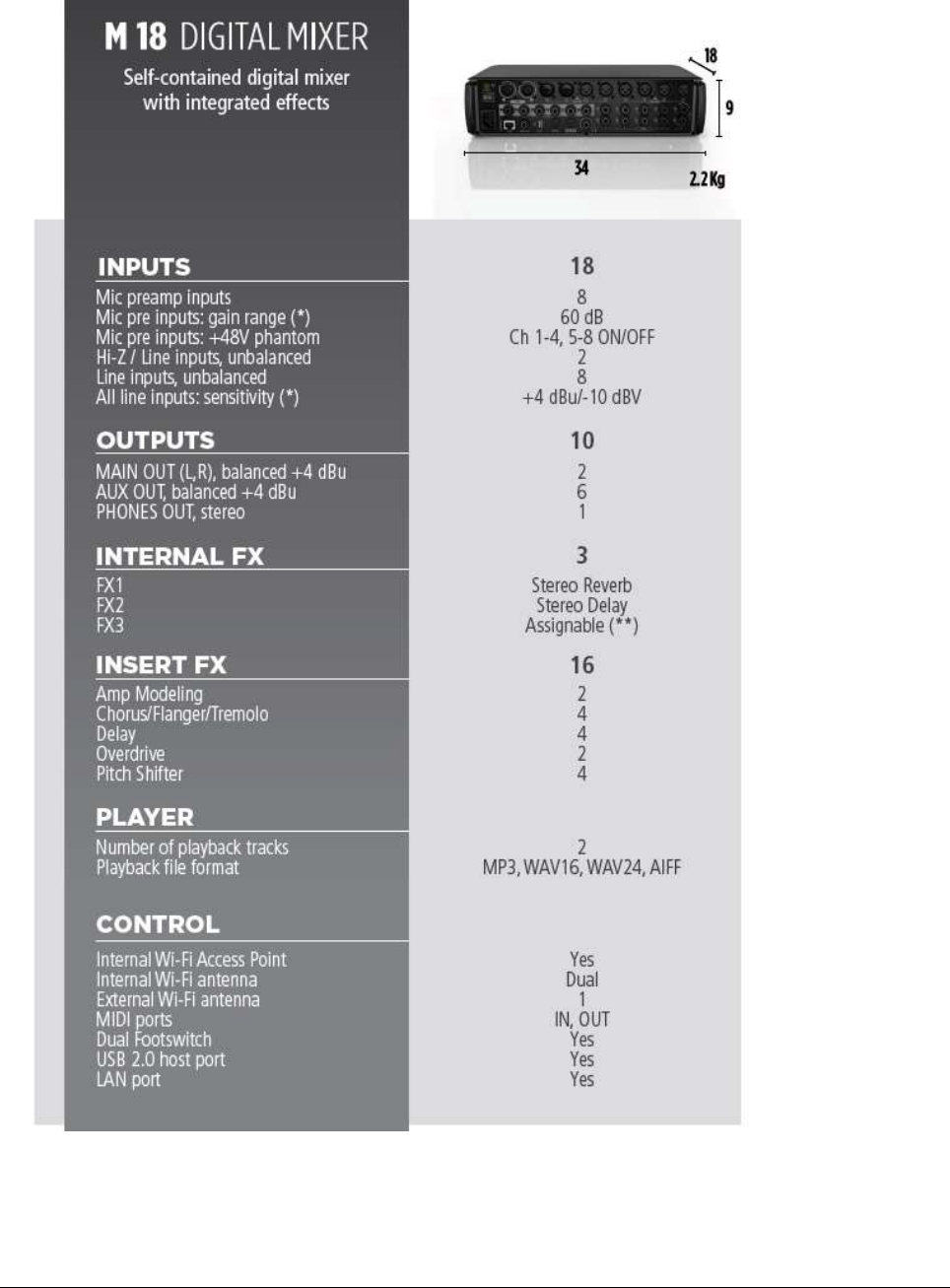
RCF spa
M 18 Digital Mixer User’s Manual
58
A4 – Technical Specifications
* remote control from the app
** Stereo Chorus, Stereo Flanger, Stereo Tremolo, Stereo Delay, or Stereo Pitch Shifter